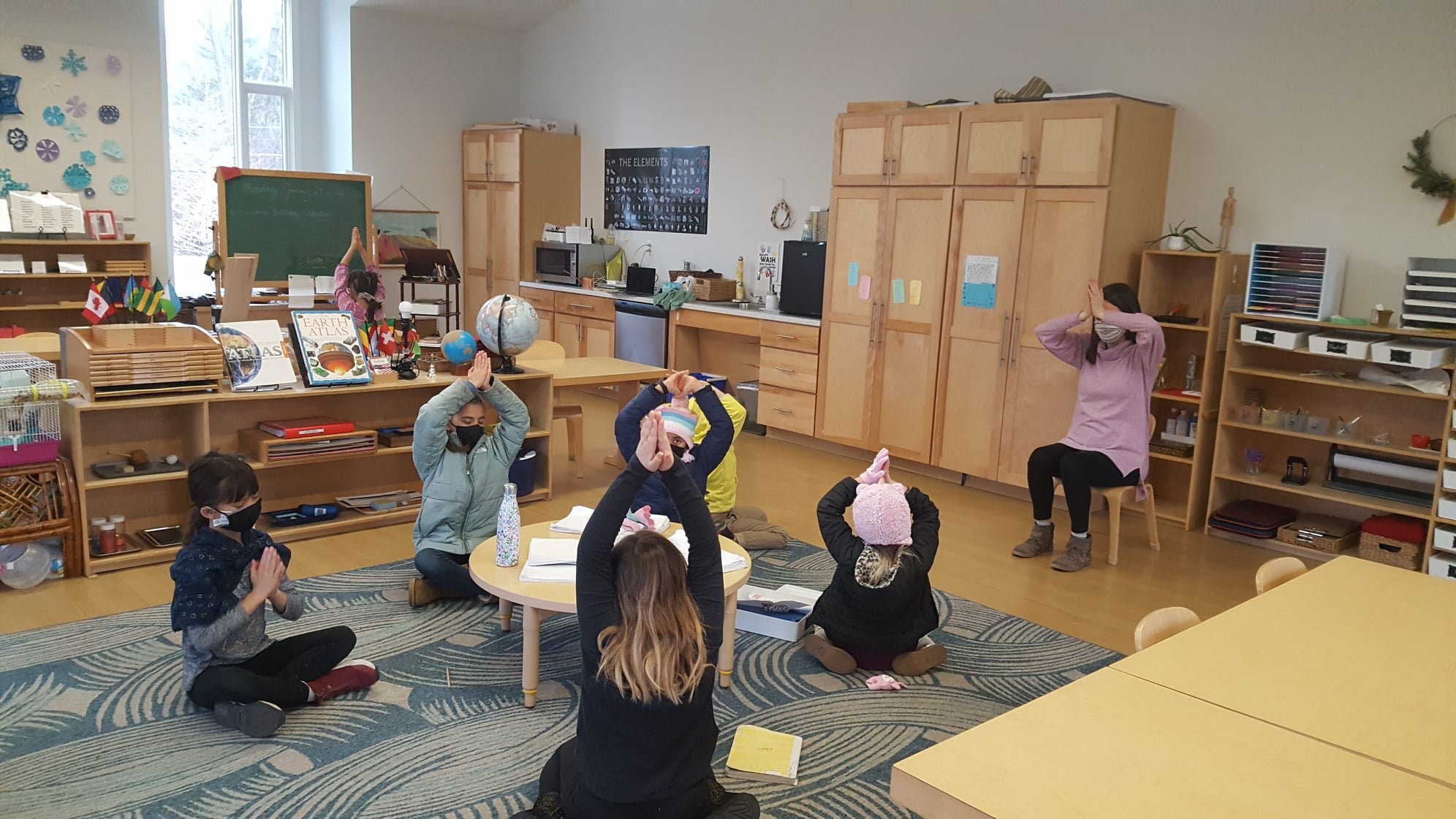 While we (shamelessly) love to show off our school and community in the Villa di Maria blog, we are also here to spread the word about Montessori beyond our campus—demystifying and celebrating the Montessori method of education in the hopes that more people will discover its benefits for children and families.
While we (shamelessly) love to show off our school and community in the Villa di Maria blog, we are also here to spread the word about Montessori beyond our campus—demystifying and celebrating the Montessori method of education in the hopes that more people will discover its benefits for children and families. You’ve seen our recent posts from our 101 series, where we breakdown some of the terminology you might find in a Montessori school. This week, we’ll kick off another series, all about Montessori theory. In our Theory series, we’ll dive deep into the foundational principles of the Montessori method and take a look at how these theories come into practice in the school setting. We’ll start today with “The Four Planes of Development.” The work of the Montessori guide, the organization of the Montessori classroom, the design and function of Montessori materials—everything about the Montessori method—it all comes down to the four planes.
You’ve seen our recent posts from our 101 series, where we breakdown some of the terminology you might find in a Montessori school. This week, we’ll kick off another series, all about Montessori theory. In our Theory series, we’ll dive deep into the foundational principles of the Montessori method and take a look at how these theories come into practice in the school setting. We’ll start today with “The Four Planes of Development.” The work of the Montessori guide, the organization of the Montessori classroom, the design and function of Montessori materials—everything about the Montessori method—it all comes down to the four planes. The four planes of development are 6-year stages of child development, from birth to adulthood. In her research and work with children, Dr. Maria Montessori observed that children and adolescents develop through natural stages which can be defined by specific characteristics and developmental needs: birth to age 6; ages 6 to 12; ages 12 to 18, and ages 18 to 24. Dr. Montessori believed it was crucial to serve the specific developmental characteristics and needs of children in each plane, to allow them to move with strength into each following plane and prepare them for adulthood.
The four planes of development are 6-year stages of child development, from birth to adulthood. In her research and work with children, Dr. Maria Montessori observed that children and adolescents develop through natural stages which can be defined by specific characteristics and developmental needs: birth to age 6; ages 6 to 12; ages 12 to 18, and ages 18 to 24. Dr. Montessori believed it was crucial to serve the specific developmental characteristics and needs of children in each plane, to allow them to move with strength into each following plane and prepare them for adulthood.
If "the formation of man" [sic] becomes the basis of education, then the coordination of all schools from infancy to maturity, from nursery to university, arises as a first necessity: for man is a unity, an individuality that passes through interdependent phases of development. Each preceding phase prepares the one that follows, forms its base, nurtures the energies that urge towards the succeeding period of life.-Dr. Maria Montessori
 Montessori education is designed to follow children through these planes—through their natural patterns of development. Montessori classroom environments intentionally foster the natural characteristics of each plane. Montessori guides receive rigorous training to facilitate each child’s incredible journey through each plane by meeting and challenging their academic, social, and emotional needs.
Montessori education is designed to follow children through these planes—through their natural patterns of development. Montessori classroom environments intentionally foster the natural characteristics of each plane. Montessori guides receive rigorous training to facilitate each child’s incredible journey through each plane by meeting and challenging their academic, social, and emotional needs.
Planes and Transitions
Before we dive into each plane, it is crucial to note that, while Dr. Montessori defines each plane by a six-year age span, the transitions from plane to plane do not occur at hard-and-fast dates. For instance, a child transitions from the first to the second plane around age 6, but not necessarily on the 6th birthday—there is no timer on a plane of development. Instead, the planes are used as a framework, and each child moves through the planes at their own individual pace. In fact, this individual progression is a hallmark of Montessori education.

The First Plane of Development: Infancy (birth – 6 years)
The first plane of development is defined by the construction of the individual—this is when young children begin to develop a sense of self. In a nurturing environment, children naturally build physical and biological independence as they learn to carry out progressively more complex activities independently. They learn to move, take care of their bodily needs, and communicate—all with very little formal instruction. A child is born with an innate faculty named by Dr. Montessori as “the absorbent mind.” The absorbent mind observes and takes in stimuli just like a camera—concretely, exactly as it is—and empowers the child to learn so much about the world without conscious effort. At Villa di Maria, children in this plane are served in the Young Children’s Community (ages 14 months – 3 years) and the Children’s House (ages 3 – 6). These environments take advantage of the absorbent mind by introducing the children to concrete concepts about self-care, language, geography, math, biology, and community care. The guides capitalize on the young child’s ability to learn through their absorbent mind by introducing vocabulary and facts about the world through their lessons and by modeling grace and courtesy in their communities. As they develop through the first plane, children in a Montessori environment are offered endless opportunities to gain knowledge of themselves, their communities, and the world—knowledge that will be used as the foundation for the upcoming second plane.
Second Plane of Development: Childhood (6 – 12 years)
In the second plane of development, the child acquires mental independence and a burgeoning social awareness. During this stage, there is a crucial transition from the “absorbent mind” to the “reasoning mind.” Second-plane children are capable of abstraction, of using imagination to visualize concepts not seen. Armed with a strong foundation of concrete knowledge gained in the first plane, second-plane children begin to ask why—they seek to understand the causes of things and become sensitive to questions of morality and justice. At Villa di Maria, children in the second plane are served in Lower Elementary (ages 6 – 9) and Upper Elementary (ages 9 – 12) environments. These classrooms foster the child’s impulse to explore abstract concepts in science, geography, history, math, language, music, and art, and to gain a deeper understanding about the world. The social development of the second-plane child is also supported in the Montessori elementary environment. In fact, it is central to the Montessori elementary education. Children enter their elementary years seeking to find their place in a community of their peers. At the onset of each school year, the Montessori elementary classroom establishes a set of rules for their community. The children collaborate and lead this process. Through healthy debate and the support of the guide, the children create a classroom constitution, a document that expresses their shared values as well as the actions and behaviors required to uphold those values. This social contract becomes a point of reference for all of the children throughout the school year—something to guide them as they navigate through social development.

Third Plane of Development: Adolescence (12 – 18 years old)
During the adolescent plane of development, students deepen their understanding of the world and their place in it. This is a time of immense social growth and developing independence. Similarly to the first plane, the third plane is a phase of dramatic physical, mental, and emotional change and can be a time of turbulence, insecurity, and creativity. On their way to adulthood, students in the third plane work to discover who they are and how they fit into different social groups, their families, their communities, and the world around them. They try on different masks and personalities and seek role models to emulate. Montessori middle and high schools offer adolescents a place for this development. They offer students opportunities to explore and deepen their academic interests, express themselves creatively and socially, and make meaningful contributions to their communities. Montessori education allows adolescents to see themselves as valuable participants in the global community.
Fourth Plane of Development: Maturity (18 – 24 years old)
Dr. Montessori described the fourth plane as a time of maturity and the final plane of development. As adolescents enter adulthood, they develop a sense of certainty—a stronger sense of self. It is during this plane that young adults develop spiritual and moral independence, integrate fully into their communities, and begin to contribute to the construction of a greater world. Isn’t this what we want for our kids, to reach adulthood with the independence, security, and wholeness to make the world a better place? It’s what Dr. Montessori wanted and why she devoted her life to understanding child development and promoting better education for children. Because of her knowledge of the four planes, children at Villa di Maria get to experience the fullness and beauty of each plane in our classrooms from ages 14 months to 12 years and emerge from VdM in strength to enter adolescence and adulthood.References: “From Childhood to Adolescence” by Dr. Maria Montessori
Isn’t this what we want for our kids, to reach adulthood with the independence, security, and wholeness to make the world a better place? It’s what Dr. Montessori wanted and why she devoted her life to understanding child development and promoting better education for children. Because of her knowledge of the four planes, children at Villa di Maria get to experience the fullness and beauty of each plane in our classrooms from ages 14 months to 12 years and emerge from VdM in strength to enter adolescence and adulthood.References: “From Childhood to Adolescence” by Dr. Maria Montessori




 Since our inception in 1967, ecology and sustainability have been at the heart of Villa di Maria (VdM). From the start, VdM had a “green dream” to establish the first “green” school in the St. Louis area, inspiring and supporting other schools to do the same. In our recent redesign of the campus, adding buildings for our Elementary and Children's House classrooms, we have sought to reduce our energy footprint and preserve the natural landscape. Recognizing our efforts, Ameren awarded VdM $5,000 for our our Elementary building which aligned with many
Since our inception in 1967, ecology and sustainability have been at the heart of Villa di Maria (VdM). From the start, VdM had a “green dream” to establish the first “green” school in the St. Louis area, inspiring and supporting other schools to do the same. In our recent redesign of the campus, adding buildings for our Elementary and Children's House classrooms, we have sought to reduce our energy footprint and preserve the natural landscape. Recognizing our efforts, Ameren awarded VdM $5,000 for our our Elementary building which aligned with many  VdM’s expansive six-acre outdoor campus offers many opportunities for children to engage in and appreciate the beauty of the natural world. Children collect and study leaves for a botany lesson, plant seedlings in the garden, participate in nature walks, create forts in the woods, and care for our chickens. VdM has naturally and organically engaged in many sustainable practices such as composting, recycling, and water conservation through rain barrel use.
VdM’s expansive six-acre outdoor campus offers many opportunities for children to engage in and appreciate the beauty of the natural world. Children collect and study leaves for a botany lesson, plant seedlings in the garden, participate in nature walks, create forts in the woods, and care for our chickens. VdM has naturally and organically engaged in many sustainable practices such as composting, recycling, and water conservation through rain barrel use.

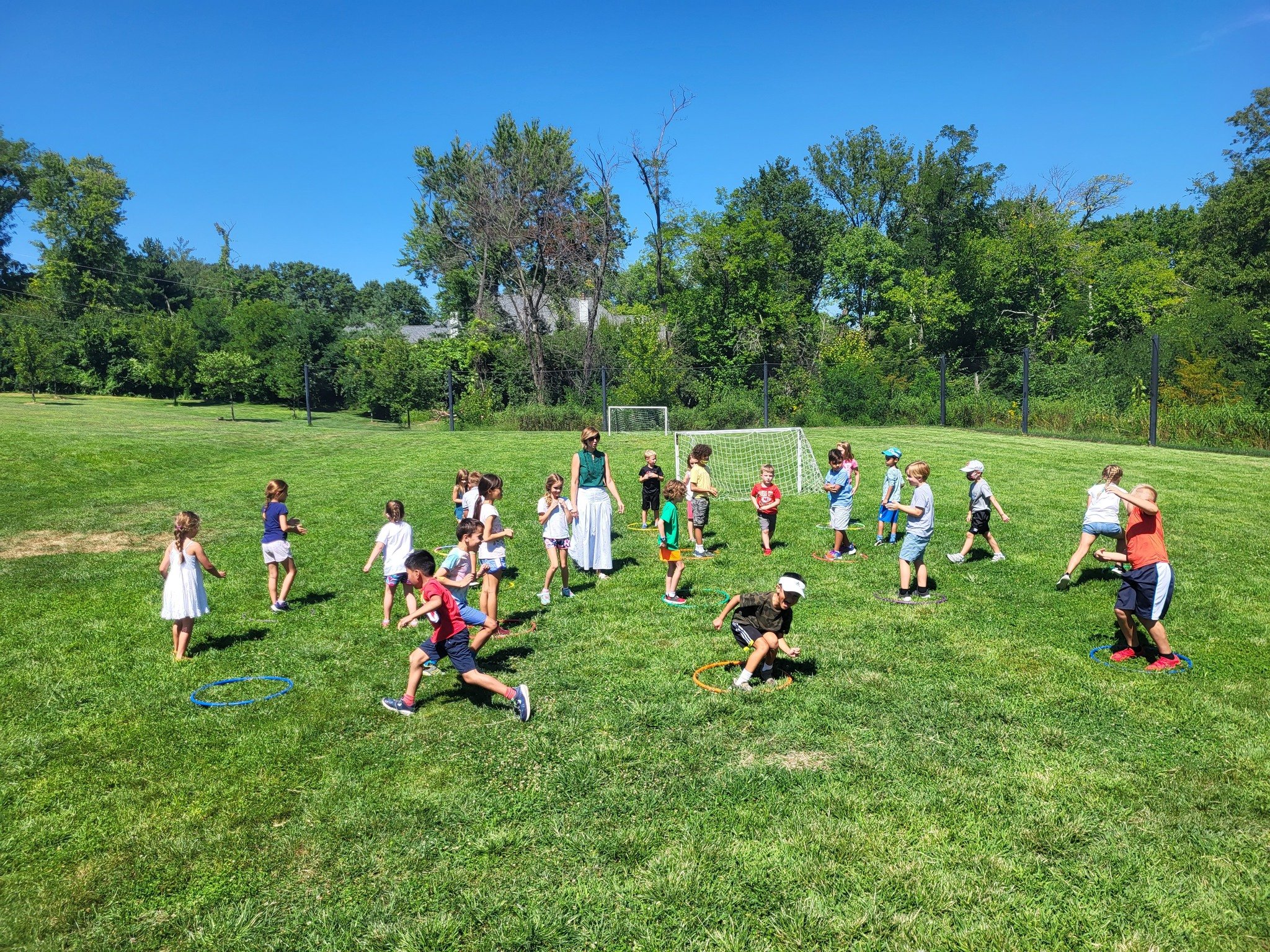 Not only does our physical campus reflect our environmental concern, but our Montessori philosophy and pedagogy also reinforces our efforts. The knowledge that we are interconnected beings in a larger ecosystem of the classroom, society, and the world (including the natural world) is built into the culture and lessons of the Montessori classroom. Montessori philosophy deeply values the natural world and offers that perspective to the child through engaging lessons in botany, zoology, and ecology. A Montessori environment contains many plants and animals to observe, care for and from which to learn. Currently, our classrooms contain a variety of pets including a bearded dragon, hamsters, guinea pigs, a hedgehog and fish, to name a few. Children participate in the research of and care for these animals, preparing a suitable habitat and ensuring their nutritional needs are met. The children also tend to a myriad of types of plants within the prepared environment. Through these daily interactions, children learn the various needs of living things around them and recognize their place in a vast network of interconnected living and non-living elements.
Not only does our physical campus reflect our environmental concern, but our Montessori philosophy and pedagogy also reinforces our efforts. The knowledge that we are interconnected beings in a larger ecosystem of the classroom, society, and the world (including the natural world) is built into the culture and lessons of the Montessori classroom. Montessori philosophy deeply values the natural world and offers that perspective to the child through engaging lessons in botany, zoology, and ecology. A Montessori environment contains many plants and animals to observe, care for and from which to learn. Currently, our classrooms contain a variety of pets including a bearded dragon, hamsters, guinea pigs, a hedgehog and fish, to name a few. Children participate in the research of and care for these animals, preparing a suitable habitat and ensuring their nutritional needs are met. The children also tend to a myriad of types of plants within the prepared environment. Through these daily interactions, children learn the various needs of living things around them and recognize their place in a vast network of interconnected living and non-living elements.
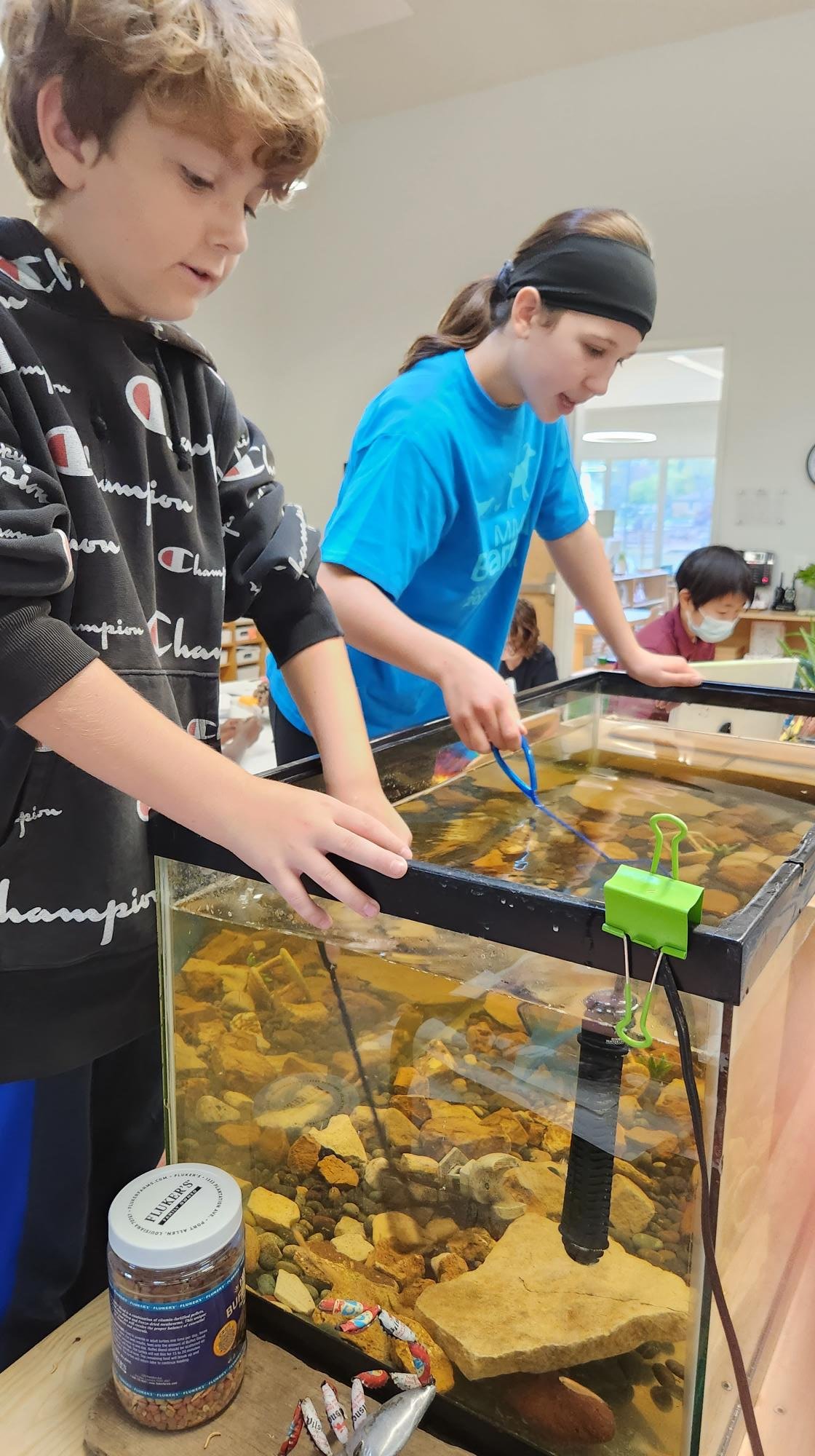 In addition to the Montessori lessons and physical environment of the classroom, the Montessori approach naturally fosters responsible and thoughtful behavior in the children toward the world around them. On-going “Grace and Courtesy” lessons demonstrate to the children how to engage appropriately with their peers in their community and care for the entirety of the prepared environment (read more about “Grace and Courtesy” in
In addition to the Montessori lessons and physical environment of the classroom, the Montessori approach naturally fosters responsible and thoughtful behavior in the children toward the world around them. On-going “Grace and Courtesy” lessons demonstrate to the children how to engage appropriately with their peers in their community and care for the entirety of the prepared environment (read more about “Grace and Courtesy” in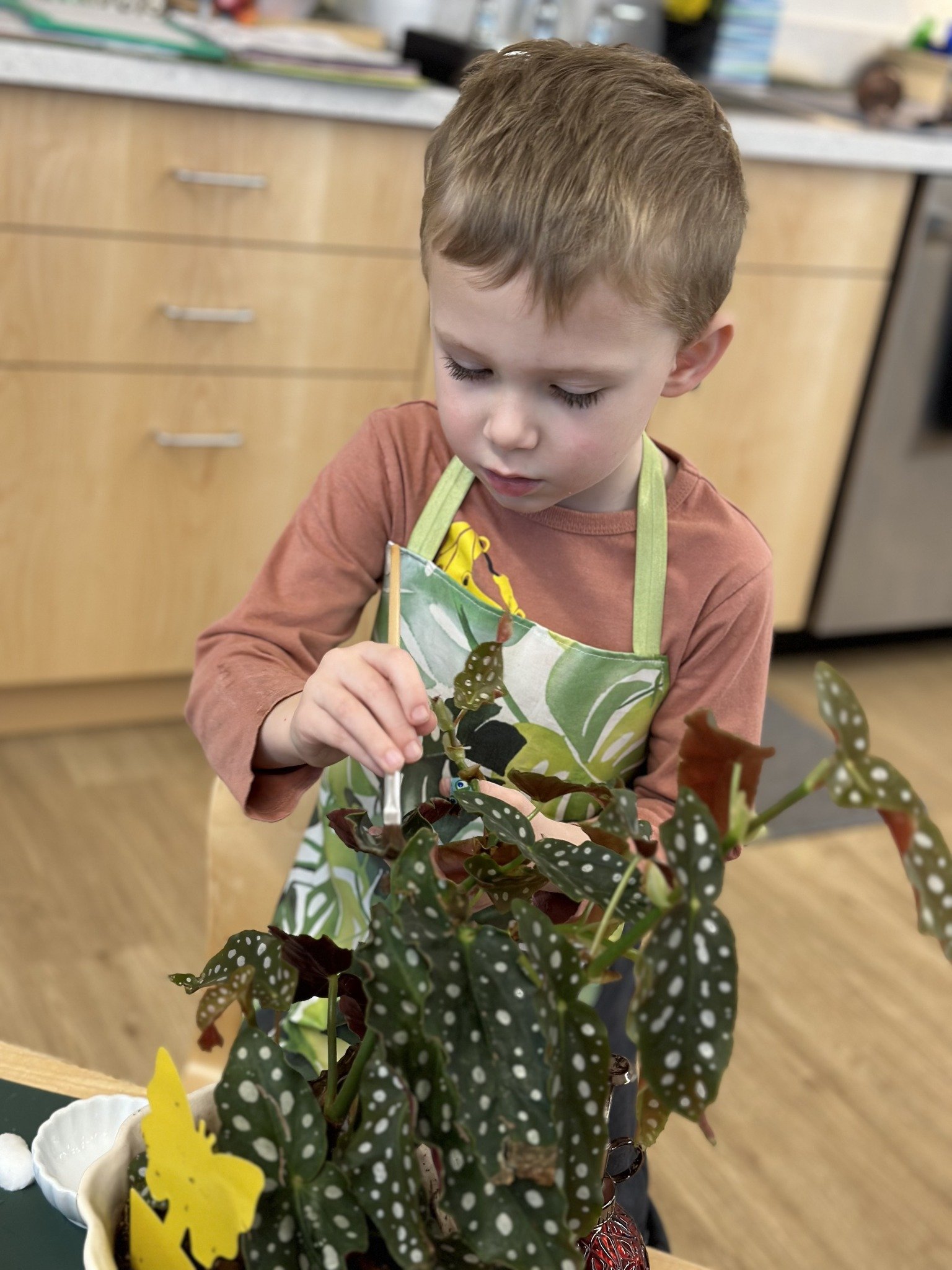
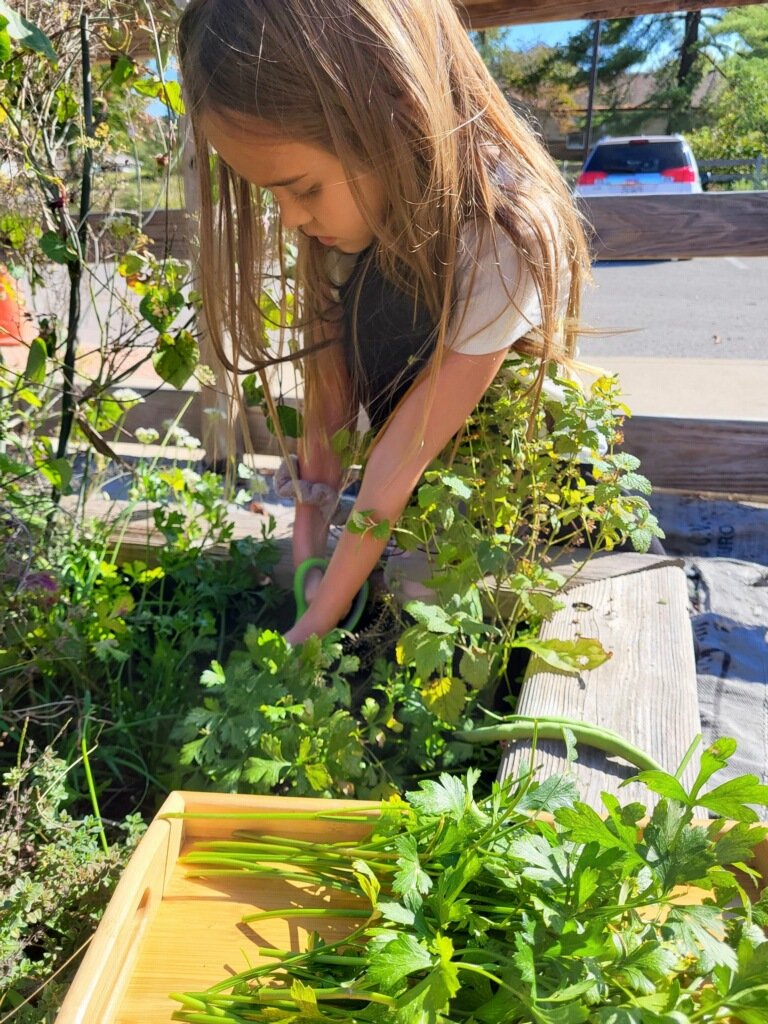 In part due to the inspiration of our elementary children who have grown up learning such Montessori principles and practices, we challenged ourselves to take even more practical steps in our care for the earth, formalizing our commitment into strategic goals. Missouri Green Schools and Green Schools Quest provided us that framework and recognition to guide us further in our pursuit of ecological justice.
In part due to the inspiration of our elementary children who have grown up learning such Montessori principles and practices, we challenged ourselves to take even more practical steps in our care for the earth, formalizing our commitment into strategic goals. Missouri Green Schools and Green Schools Quest provided us that framework and recognition to guide us further in our pursuit of ecological justice.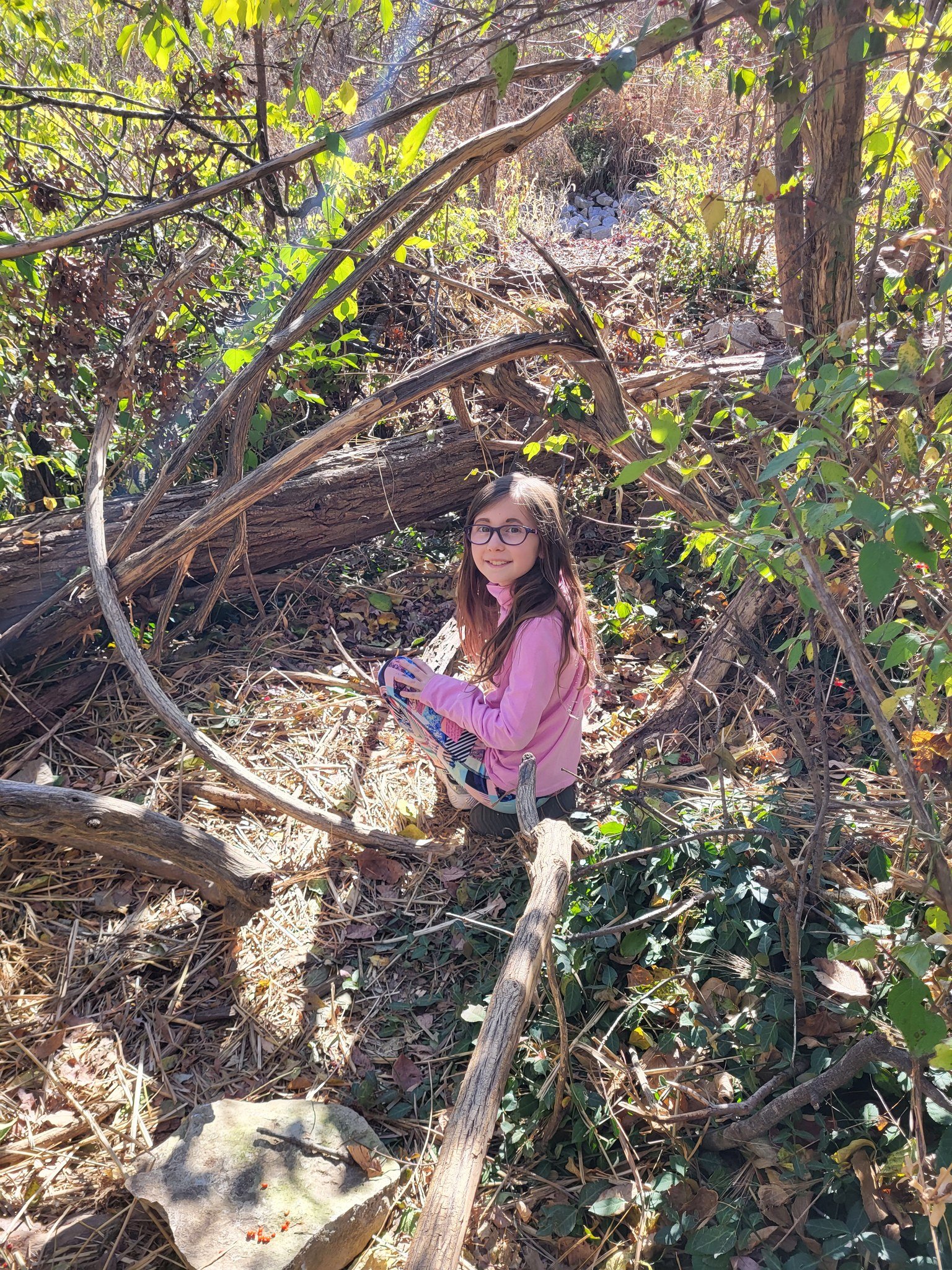
 Our Green Schools Quest Green Mentor, Benjamin Winkler, has been incredibly helpful in raising awareness and educating our community about proper waste diversion. He conducted a waste audit with the elementary children, helping them recognize what was in their classroom waste bins and how they could improve their sorting habits. He also presented an entertaining puppet show to the Children’s Houses and hosted other fun activities to educate and inspire the elementary children.
Our Green Schools Quest Green Mentor, Benjamin Winkler, has been incredibly helpful in raising awareness and educating our community about proper waste diversion. He conducted a waste audit with the elementary children, helping them recognize what was in their classroom waste bins and how they could improve their sorting habits. He also presented an entertaining puppet show to the Children’s Houses and hosted other fun activities to educate and inspire the elementary children.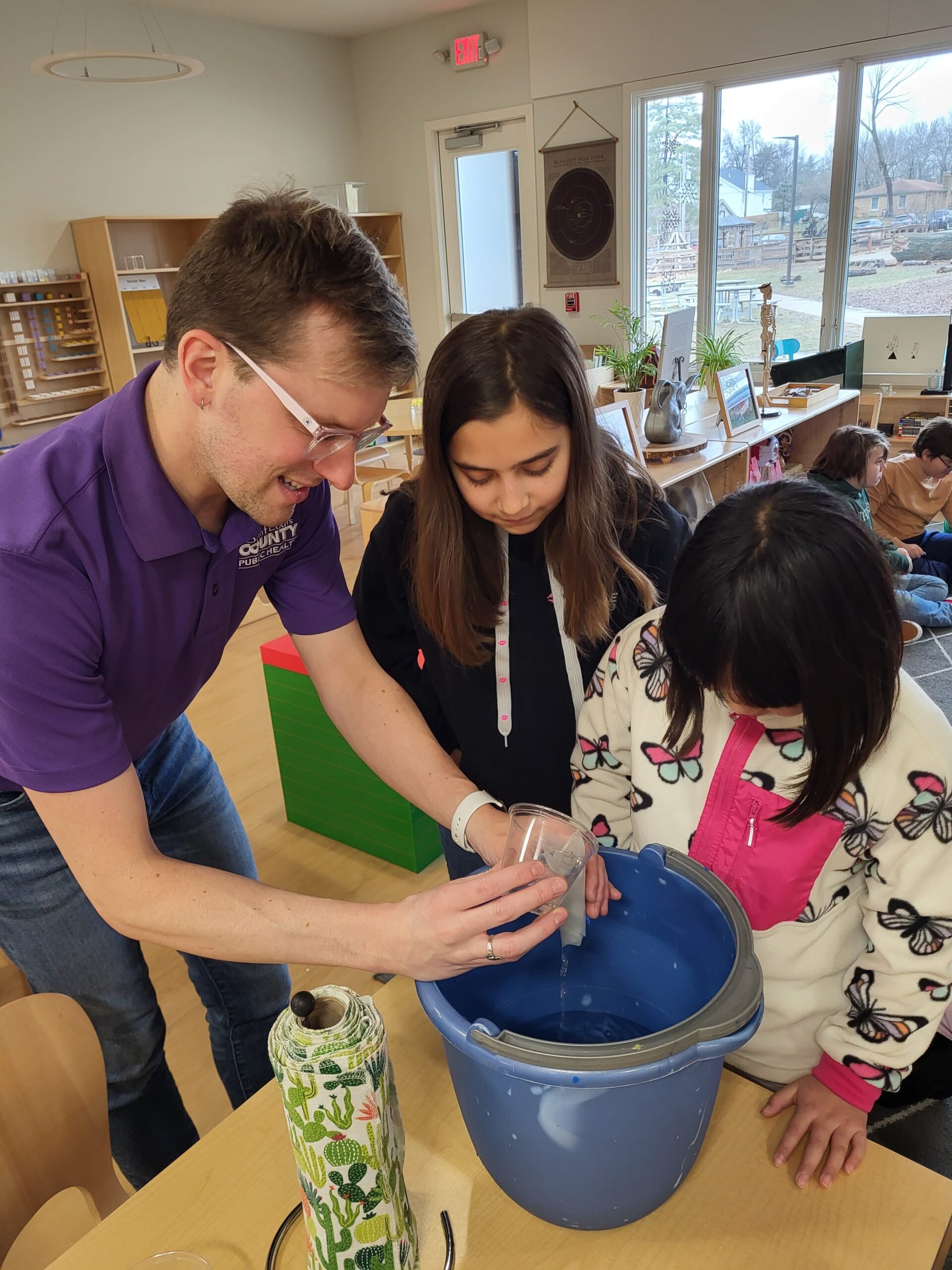
 Our self-proclaimed Green Schools Quest challenge this year is to recycle more and recycle better. We’ve upped our recycling game by engaging in the
Our self-proclaimed Green Schools Quest challenge this year is to recycle more and recycle better. We’ve upped our recycling game by engaging in the 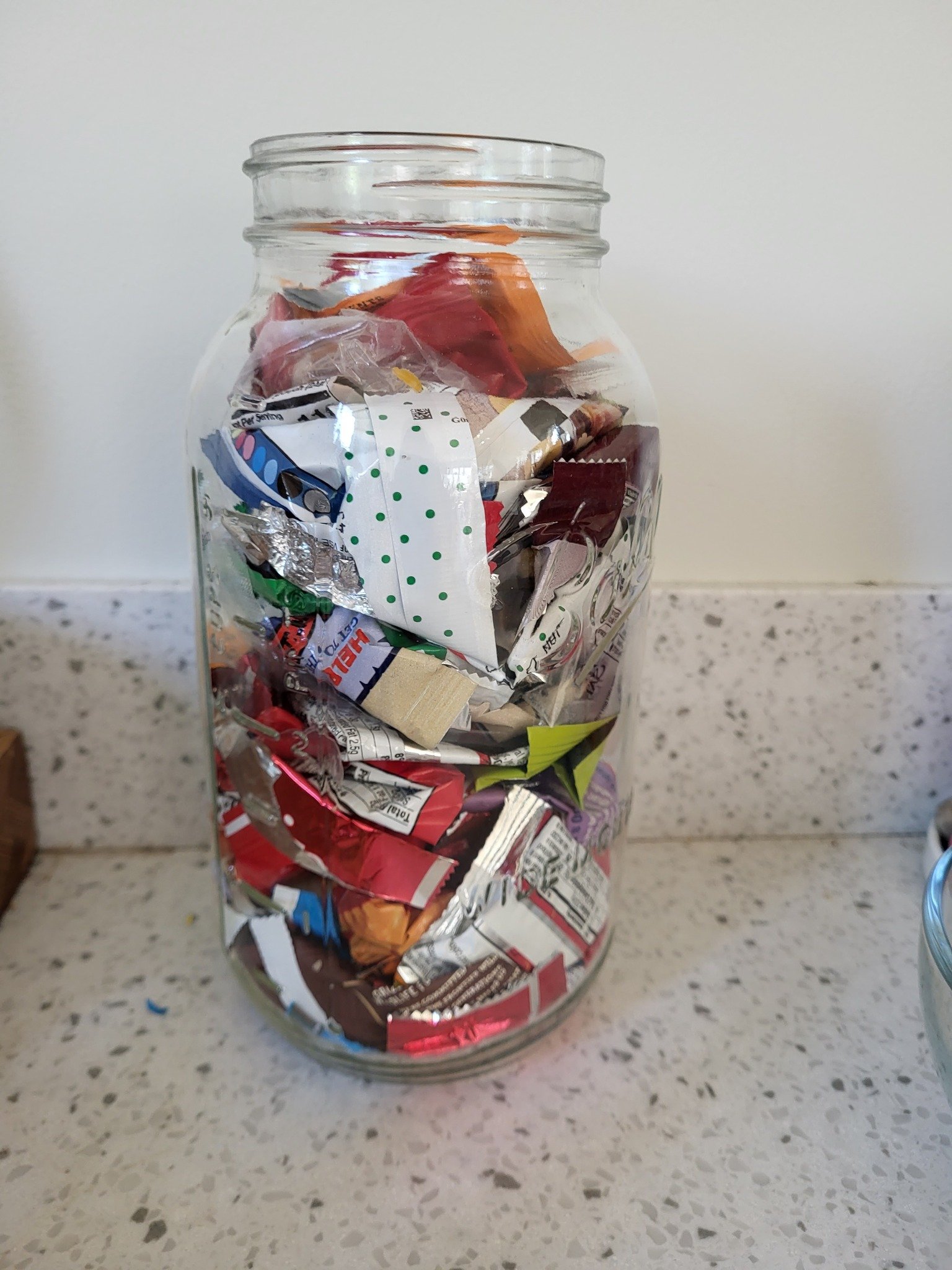

 Our VdM children continue to inspire us, and we hope you feel inspired too! Look for a community eco event coming this Spring, as we’d love to continue to involve our whole community in our quest for sustainability at VdM. If you’d like more information about our Green Initiatives or desire to support our efforts on campus, please reach out to Martha Erickson (marthae@villadimaria.org). Together we can be a part of forming the next generation into responsible humans that care for the environment, their communities, and the world.
Our VdM children continue to inspire us, and we hope you feel inspired too! Look for a community eco event coming this Spring, as we’d love to continue to involve our whole community in our quest for sustainability at VdM. If you’d like more information about our Green Initiatives or desire to support our efforts on campus, please reach out to Martha Erickson (marthae@villadimaria.org). Together we can be a part of forming the next generation into responsible humans that care for the environment, their communities, and the world.
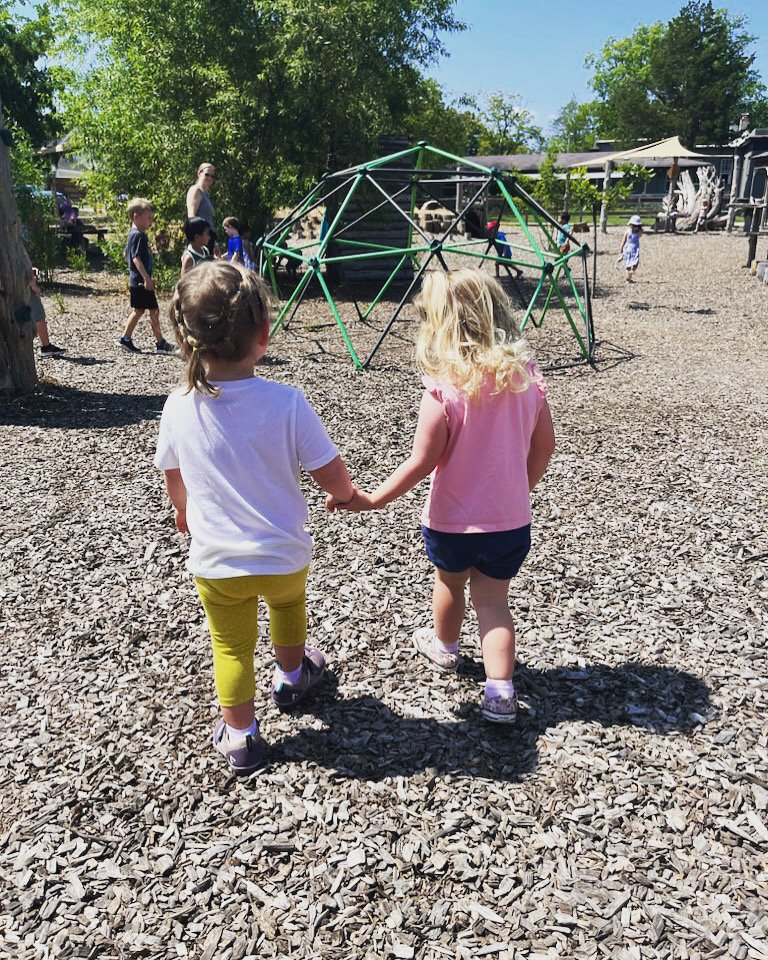 Ever wonder how a classroom of 28 (or more) children, each engaged in their own activity, remains a calm and orderly environment? How do Montessori guides elicit appropriate behavior in their students? Lessons in Grace and Courtesy (another Montessori Buzzword!) account for much of this reality. Today, we’ll share with you what we mean by “grace and courtesy” in a Montessori classroom.
Ever wonder how a classroom of 28 (or more) children, each engaged in their own activity, remains a calm and orderly environment? How do Montessori guides elicit appropriate behavior in their students? Lessons in Grace and Courtesy (another Montessori Buzzword!) account for much of this reality. Today, we’ll share with you what we mean by “grace and courtesy” in a Montessori classroom.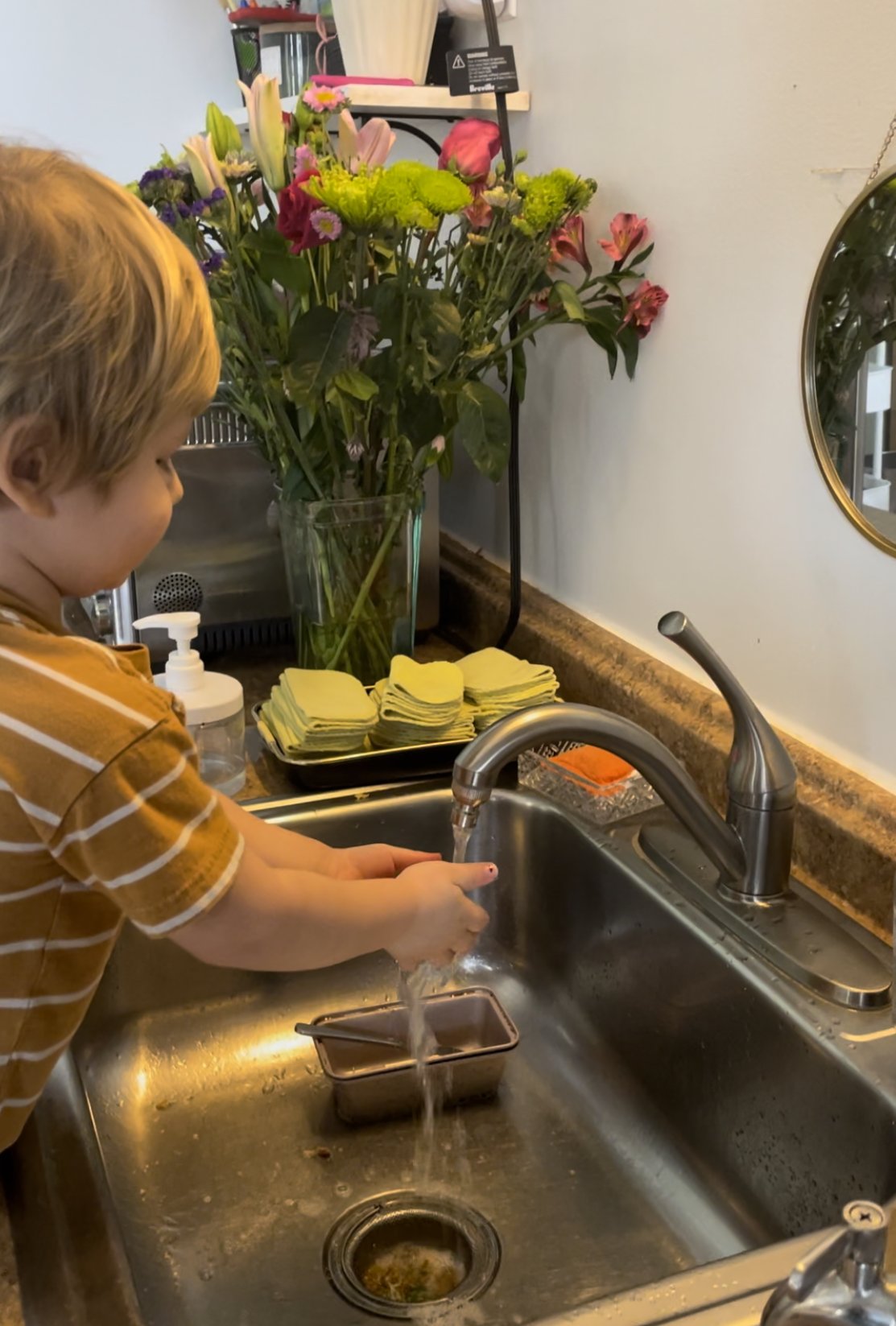 Grace describes the harmony of our own mind and body. Courtesy describes the extension of that grace to others. Through Grace and Courtesy lessons, guides demonstrate and model how to handle certain situations that naturally occur in the classroom environment, which include language and movement.
Grace describes the harmony of our own mind and body. Courtesy describes the extension of that grace to others. Through Grace and Courtesy lessons, guides demonstrate and model how to handle certain situations that naturally occur in the classroom environment, which include language and movement.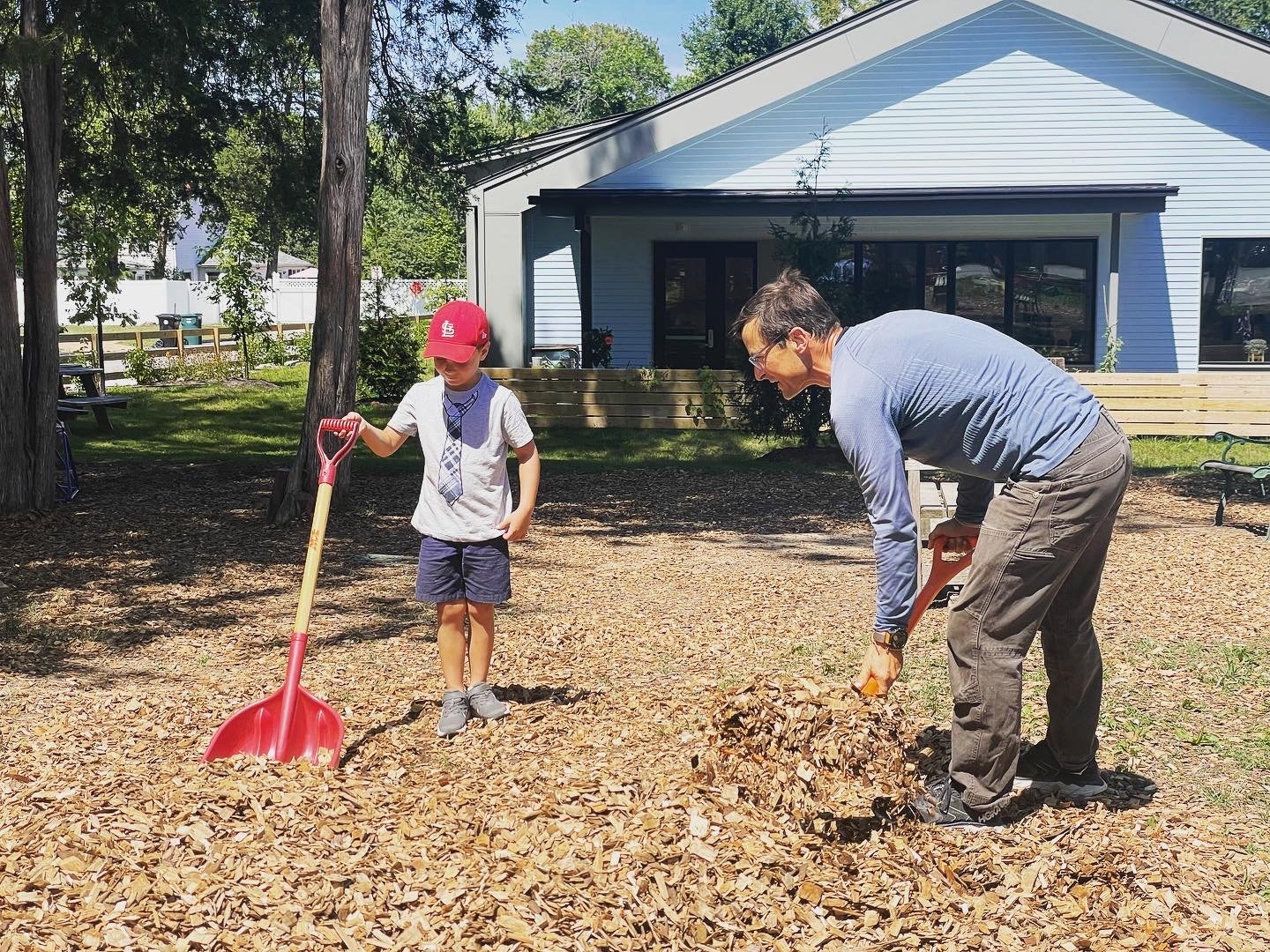 We will focus on the first plane of development in this blog post, which includes children from birth to six years old. Grace and Courtesy lessons occur in elementary classrooms as well, but take on particular nuances because of the differing developmental needs of the older child. We will look at that age group specifically in a future blog post.
We will focus on the first plane of development in this blog post, which includes children from birth to six years old. Grace and Courtesy lessons occur in elementary classrooms as well, but take on particular nuances because of the differing developmental needs of the older child. We will look at that age group specifically in a future blog post. Guides use Grace and Courtesy lessons to show children how to walk around a work rug, how to blow their nose, how to ask for help, or how to greet adults and each other. The lessons are narrow in focus and aim to introduce a specific skill so as not to confuse the child. For example, the guide would introduce separate lessons for offering assistance versus asking for help. Grace and Courtesy lessons are usually presented to a small group of children and at a neutral time after a particular behavior or language has been observed. The guide might notice an issue in the classroom and make a note to present that particular lesson at a later time.
Guides use Grace and Courtesy lessons to show children how to walk around a work rug, how to blow their nose, how to ask for help, or how to greet adults and each other. The lessons are narrow in focus and aim to introduce a specific skill so as not to confuse the child. For example, the guide would introduce separate lessons for offering assistance versus asking for help. Grace and Courtesy lessons are usually presented to a small group of children and at a neutral time after a particular behavior or language has been observed. The guide might notice an issue in the classroom and make a note to present that particular lesson at a later time.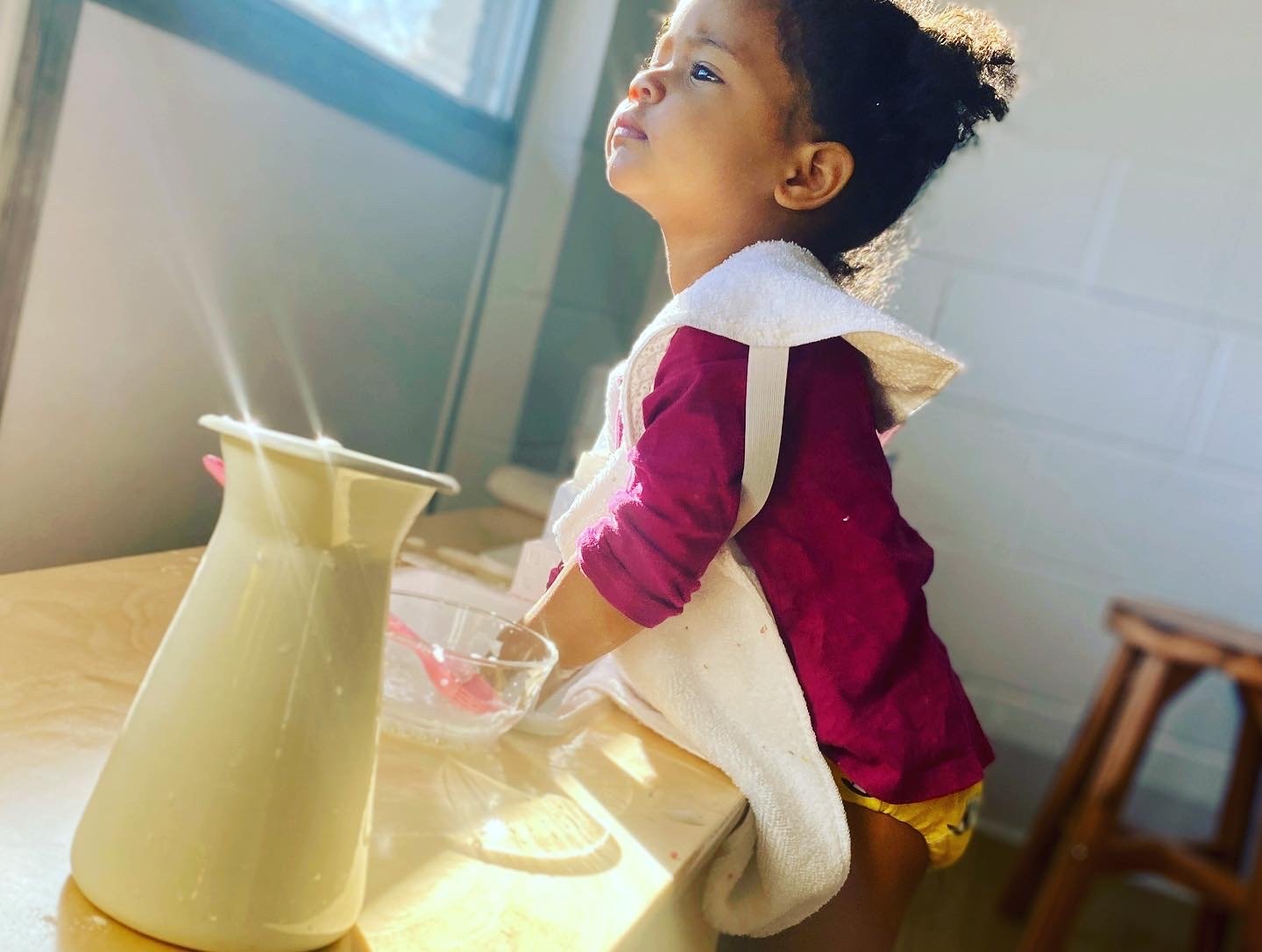 A lesson might look like this:1. The guide starts by inviting the children to the lesson, “I’m going to show you how to walk around a work rug.”2. The guide models for the child how to properly walk around the work rug. When the guide demonstrates the movement, they keep the words separate from the action. Because the child is in a sensitive period for language development, their brain will focus only on the words said and miss the action demonstrated, if the two are not separated. As Dr. Maria Montessori said,
A lesson might look like this:1. The guide starts by inviting the children to the lesson, “I’m going to show you how to walk around a work rug.”2. The guide models for the child how to properly walk around the work rug. When the guide demonstrates the movement, they keep the words separate from the action. Because the child is in a sensitive period for language development, their brain will focus only on the words said and miss the action demonstrated, if the two are not separated. As Dr. Maria Montessori said,
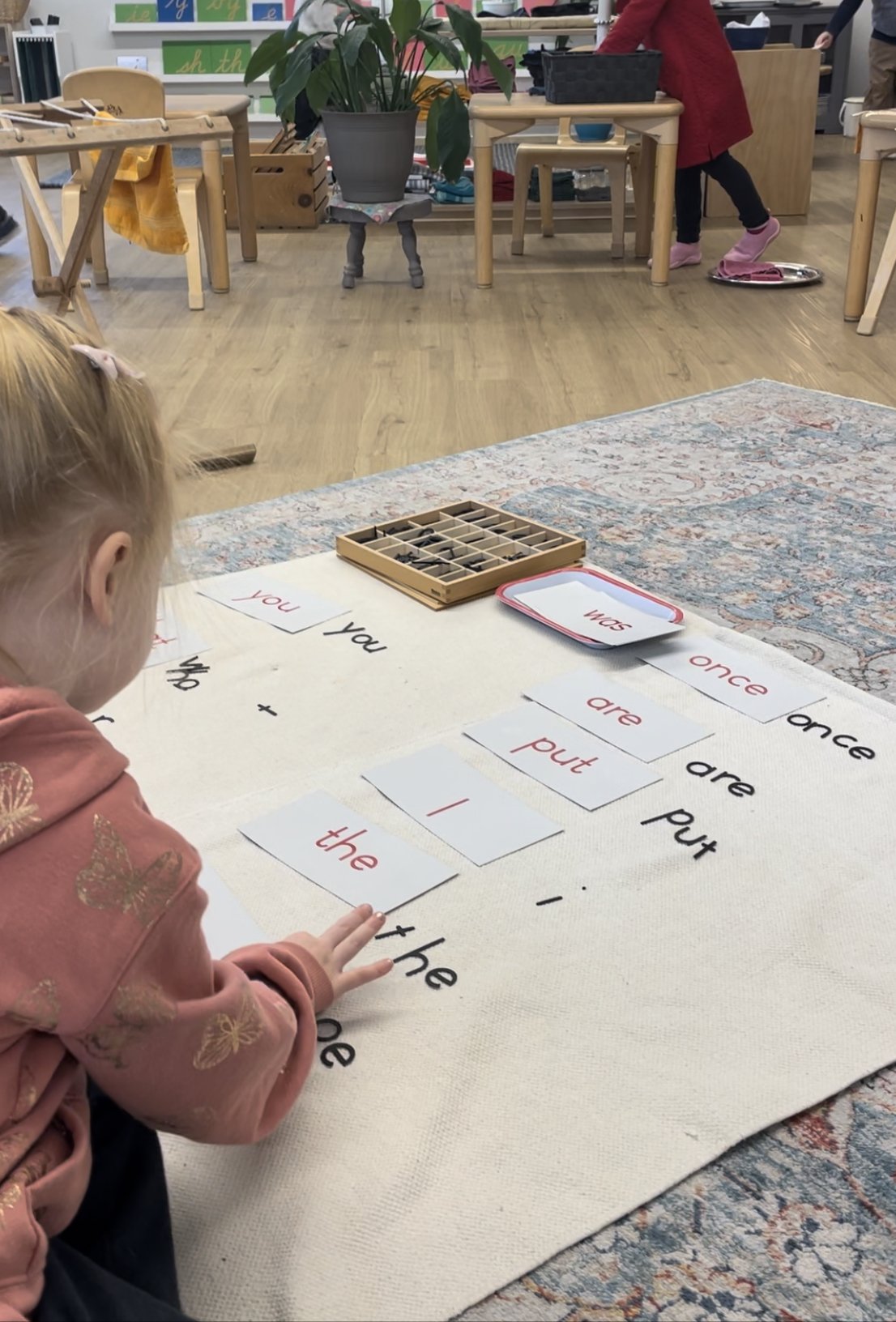 The guide does not remind the child to put this lesson into practice in a real-life situation. If pressure is applied to the child to perform these activities, children can develop negative feelings towards the lesson and avoid the behavior we seek. Ideally, the activity will be recalled spontaneously by the child when they notice what is required and are ready to perform the task. They may need the lesson presented again until they choose to demonstrate their knowledge, and the second presentation would be offered as if the first had never happened.
The guide does not remind the child to put this lesson into practice in a real-life situation. If pressure is applied to the child to perform these activities, children can develop negative feelings towards the lesson and avoid the behavior we seek. Ideally, the activity will be recalled spontaneously by the child when they notice what is required and are ready to perform the task. They may need the lesson presented again until they choose to demonstrate their knowledge, and the second presentation would be offered as if the first had never happened.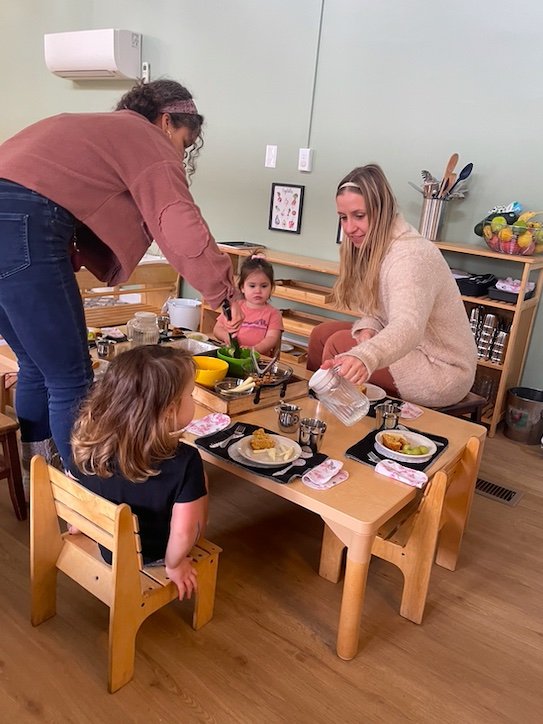 The guide always focuses on the positive behavior she wants to see in the child, as opposed to the negative. In the rug lesson above, the guide would be careful not to step on the rug in her modeling, as that is an action to be avoided. Children tend to copy what they see adults do; thus, guides always model the behavior and conduct they want to evoke in the child.
The guide always focuses on the positive behavior she wants to see in the child, as opposed to the negative. In the rug lesson above, the guide would be careful not to step on the rug in her modeling, as that is an action to be avoided. Children tend to copy what they see adults do; thus, guides always model the behavior and conduct they want to evoke in the child. These lessons can be implemented at home as well. Perhaps you notice the shoes are consistently scattered all over the mudroom and you’d like them to be placed on the shoe rack instead. With your young child, you could take them aside at some neutral time and tell them, “I’m going to show you how to put your shoes on the shoe rack.” Then demonstrate the action you’d like them to practice. Start with your shoes on your feet, model taking them off and placing them nicely on the shoe rack. Ask your child if they’d like to try. It’s fine for them to say no. Watch and see if this positive behavior starts to show up more in their day-to-day routine and make sure you model this action consistently for them, as well.
These lessons can be implemented at home as well. Perhaps you notice the shoes are consistently scattered all over the mudroom and you’d like them to be placed on the shoe rack instead. With your young child, you could take them aside at some neutral time and tell them, “I’m going to show you how to put your shoes on the shoe rack.” Then demonstrate the action you’d like them to practice. Start with your shoes on your feet, model taking them off and placing them nicely on the shoe rack. Ask your child if they’d like to try. It’s fine for them to say no. Watch and see if this positive behavior starts to show up more in their day-to-day routine and make sure you model this action consistently for them, as well.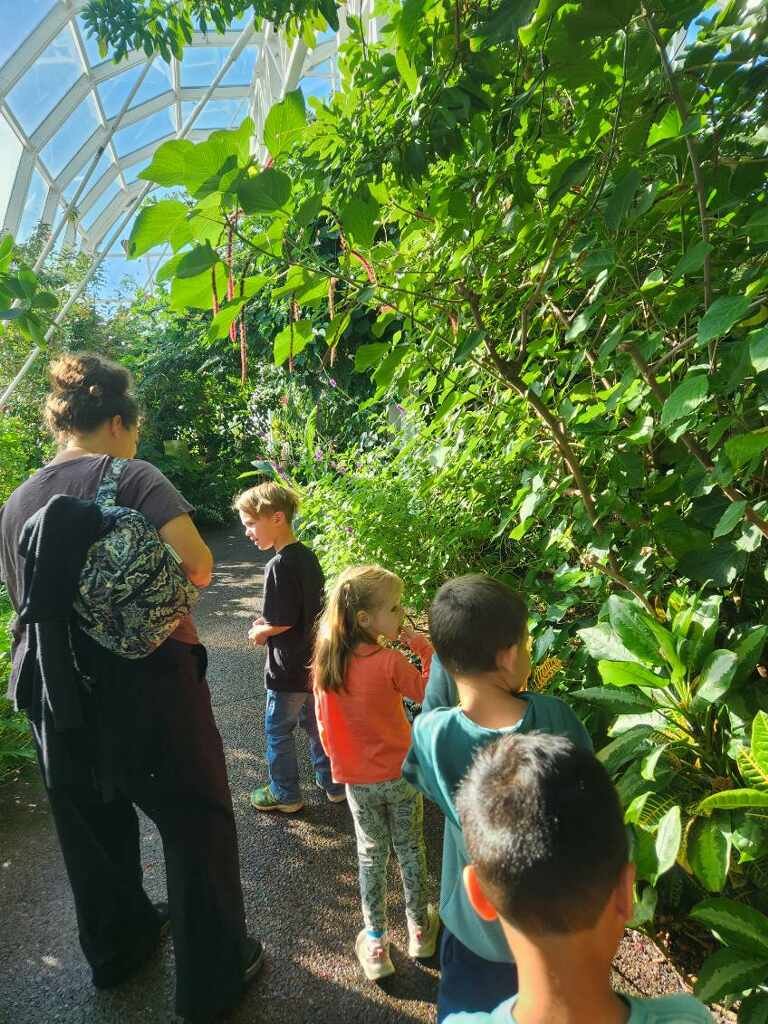 The child instinctively wants to be like the adults they are with and to do the right thing. These lessons give the child the opportunities to practice and perform these appropriate actions in their own time, without introducing shame. This brings the child feelings of security, competence, and joy to know what to expect and what to do in each situation in which they find themselves. As Dr. Montessori said,
The child instinctively wants to be like the adults they are with and to do the right thing. These lessons give the child the opportunities to practice and perform these appropriate actions in their own time, without introducing shame. This brings the child feelings of security, competence, and joy to know what to expect and what to do in each situation in which they find themselves. As Dr. Montessori said,


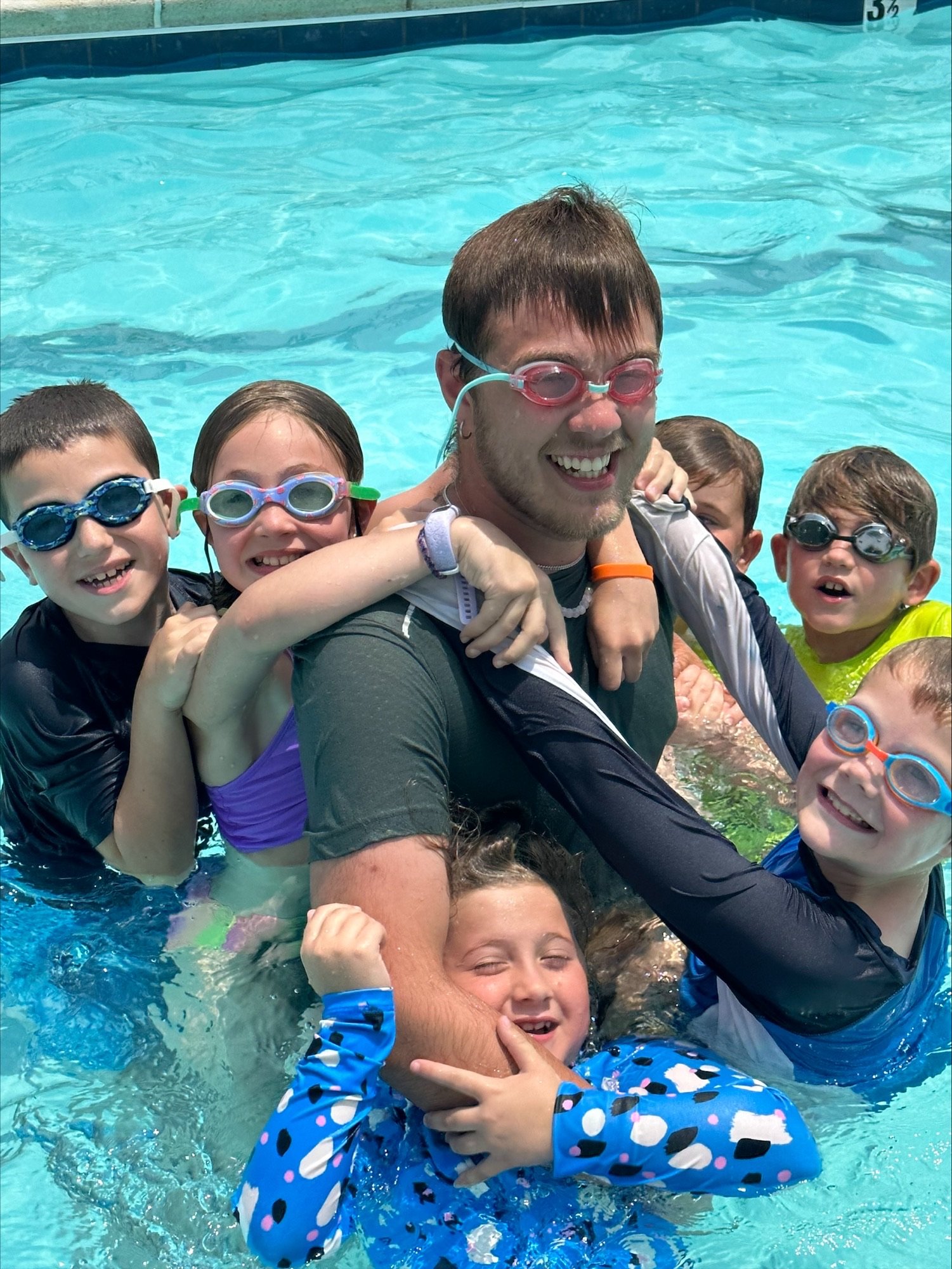

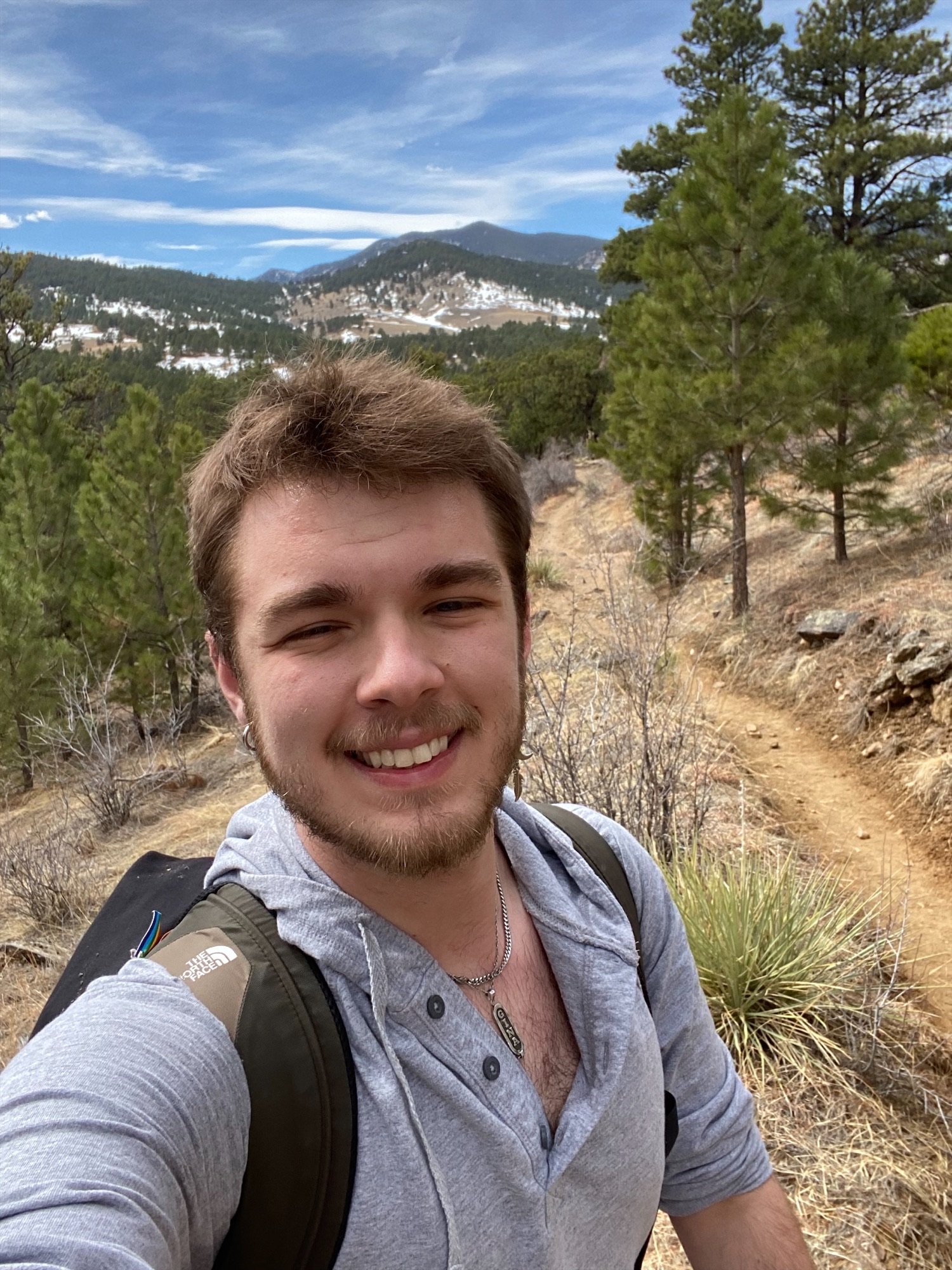
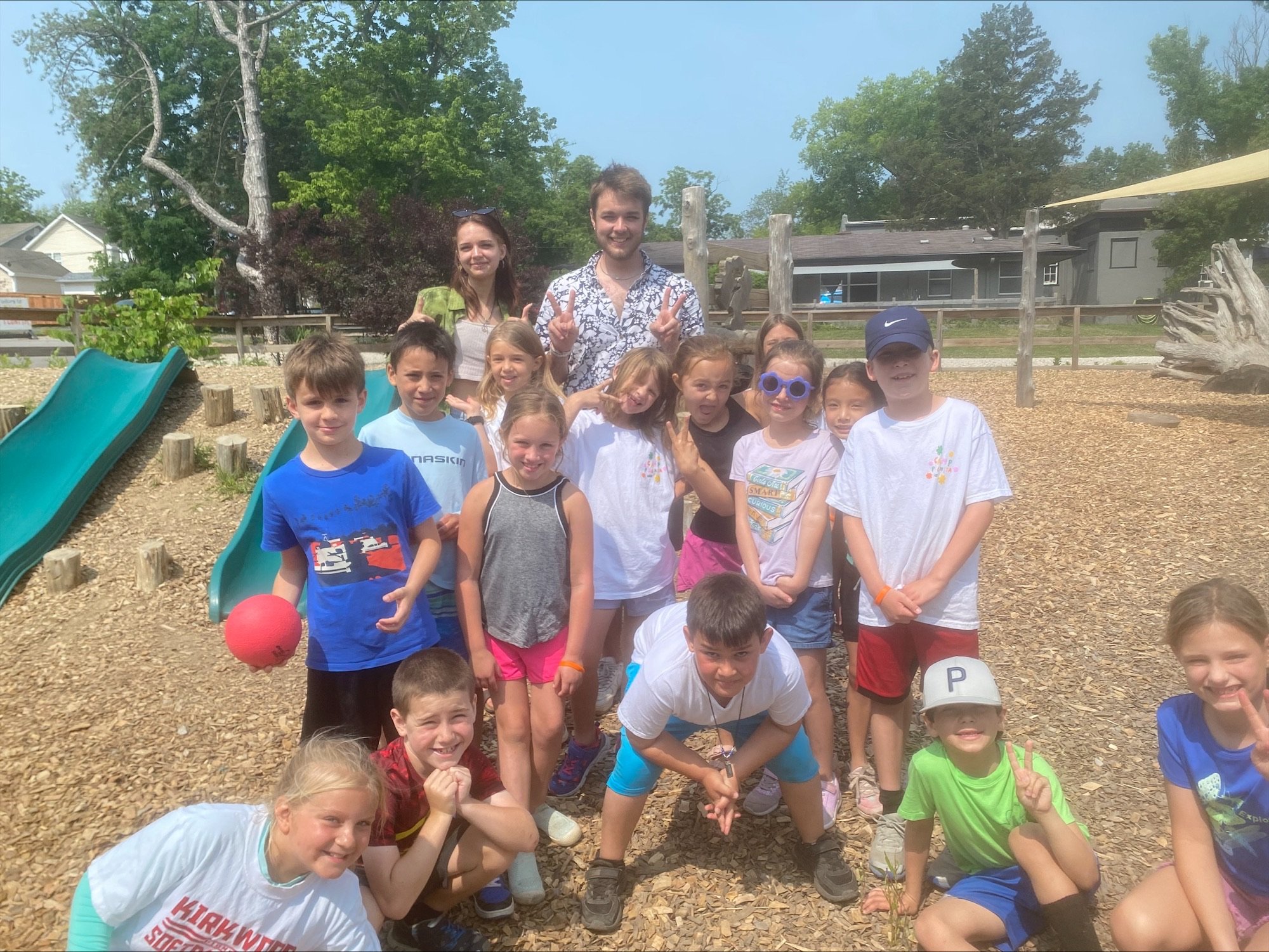

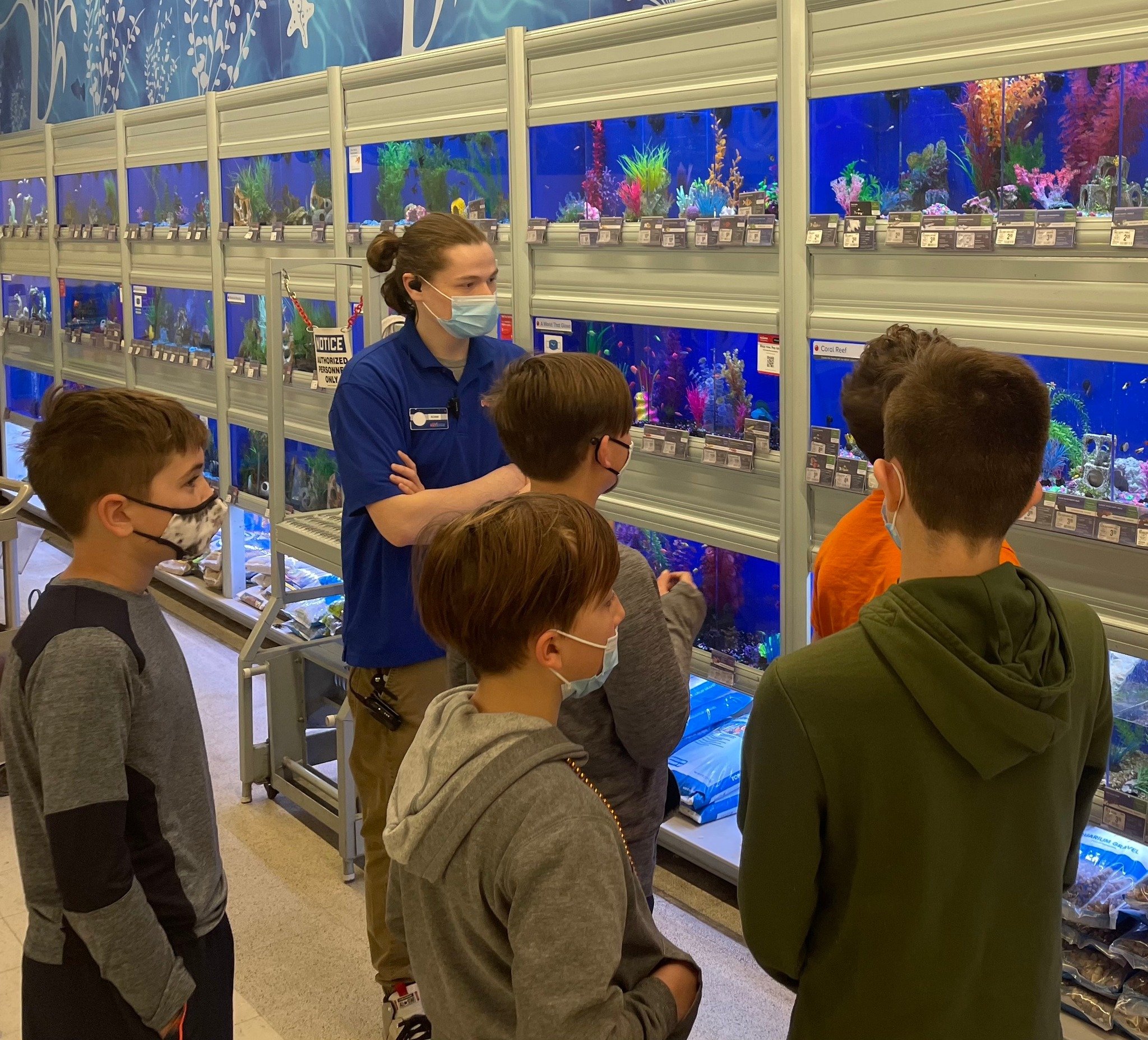 If you have an elementary child at a Montessori school or if you spend any time on our socials, you probably have heard or seen the phrase “Going Out”. And does the Montessori lingo never end?! It is probably one of the things students most look forward to about being in elementary. “I get to go explore outside of the classroom!!” Besides being a lot of fun, these opportunities for Going Out serve many purposes for the elementary-age child. Today, let’s deep dive into one of the most-loved, and perhaps most-unique, aspects of the Montessori Elementary classroom, the Going Out.
If you have an elementary child at a Montessori school or if you spend any time on our socials, you probably have heard or seen the phrase “Going Out”. And does the Montessori lingo never end?! It is probably one of the things students most look forward to about being in elementary. “I get to go explore outside of the classroom!!” Besides being a lot of fun, these opportunities for Going Out serve many purposes for the elementary-age child. Today, let’s deep dive into one of the most-loved, and perhaps most-unique, aspects of the Montessori Elementary classroom, the Going Out.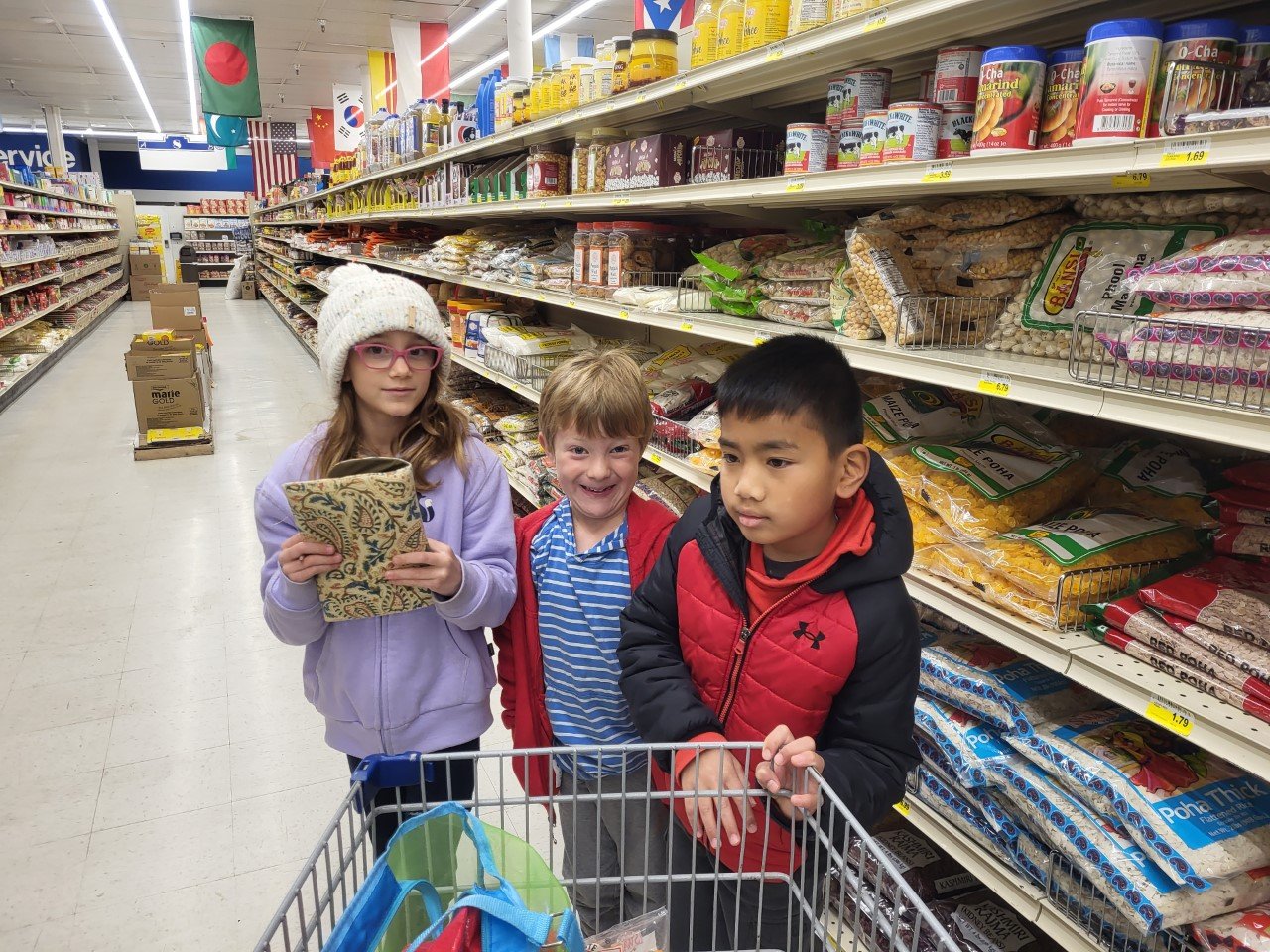 Going Out is a critical component of the Montessori Elementary classroom (grades 1-6). The Elementary child is in the 2nd plane of development (age 6-12 years) and therefore has unique proclivities and needs. If you don’t know about Montessori’s planes of development, check out the blog post entitled, “Montessori Theory: The Four Planes of Development”. The rational mind of the 2nd plane child is ready to dive into the “Why” behind everything! Why is the sun warm? Why do we have rules in a community? Why do I have to listen to you? Why does my family make different decisions than yours? In the classroom, the child explores their questions through research, reports and larger projects. The Montessori guide connects the child to materials and books in the classroom to further fuel interests, but they must go beyond the classroom to fully satisfy their need for answers. Going Out provides an opportunity for the child to dive further into the research process by visiting a local museum, zoo, library, and the like, to gain real-world knowledge that could not possibly exist in the classroom. Additionally, the classroom guide might connect the child with an expert in the field for an interview.
Going Out is a critical component of the Montessori Elementary classroom (grades 1-6). The Elementary child is in the 2nd plane of development (age 6-12 years) and therefore has unique proclivities and needs. If you don’t know about Montessori’s planes of development, check out the blog post entitled, “Montessori Theory: The Four Planes of Development”. The rational mind of the 2nd plane child is ready to dive into the “Why” behind everything! Why is the sun warm? Why do we have rules in a community? Why do I have to listen to you? Why does my family make different decisions than yours? In the classroom, the child explores their questions through research, reports and larger projects. The Montessori guide connects the child to materials and books in the classroom to further fuel interests, but they must go beyond the classroom to fully satisfy their need for answers. Going Out provides an opportunity for the child to dive further into the research process by visiting a local museum, zoo, library, and the like, to gain real-world knowledge that could not possibly exist in the classroom. Additionally, the classroom guide might connect the child with an expert in the field for an interview. A second reason for Going Outs is that the child emerges as a social being in the 2nd plane. In the first plane, the child is experiencing their own personal development (learning to walk, talk, and gaining functional independence), but as they enter the 2nd plane there becomes an acute awareness of the people around them and a desire to relate and to connect. The child becomes fascinated by community dynamics, how to belong, and the expectations and guidelines of each community member. Desire outstrips ability at this early social stage and, at first, the child needs a lot of guidance and support from classroom adults to navigate the misunderstandings and disagreements that naturally arise. The social neophyte requires experience in the real world to witness civil adult interaction and to practice taking part in their culture. The child needs opportunities to pay at a cash register, ask for help from the librarian or store clerk, navigate their way around town, and learn the various expectations for behavior in different venues (concert hall vs. basketball stadium). Going Out is a perfect way for our Elementary children to practice how to interact in their society and to develop their emerging social instinct.
A second reason for Going Outs is that the child emerges as a social being in the 2nd plane. In the first plane, the child is experiencing their own personal development (learning to walk, talk, and gaining functional independence), but as they enter the 2nd plane there becomes an acute awareness of the people around them and a desire to relate and to connect. The child becomes fascinated by community dynamics, how to belong, and the expectations and guidelines of each community member. Desire outstrips ability at this early social stage and, at first, the child needs a lot of guidance and support from classroom adults to navigate the misunderstandings and disagreements that naturally arise. The social neophyte requires experience in the real world to witness civil adult interaction and to practice taking part in their culture. The child needs opportunities to pay at a cash register, ask for help from the librarian or store clerk, navigate their way around town, and learn the various expectations for behavior in different venues (concert hall vs. basketball stadium). Going Out is a perfect way for our Elementary children to practice how to interact in their society and to develop their emerging social instinct. Some might say, isn’t Going Out like a field trip? While both experiences take the child outside the classroom, field trips are generally for the whole classroom and are planned by the teacher. For example, the class might attend the symphony or museum exhibit, but those trips are organized and led by adults. Going Out is different in that it is planned and carried out by small groups of students with minimal assistance by the adults. The children gain experience with phone conversations and email correspondence as they plan their Going Out, and they must engage with and navigate their way using maps to find the best route to their location. While at the location, they are responsible for leading the way and communicating with shop owners, docents, etc. Chaperones are present to give support when needed but they allow space for the child to learn from their experience, and even from their mistakes when safe to do so. For example, a chaperone driver will follow directions from the child, even if it means taking a wrong turn, so that the child can have the experience of solving the problem of potentially getting lost.
Some might say, isn’t Going Out like a field trip? While both experiences take the child outside the classroom, field trips are generally for the whole classroom and are planned by the teacher. For example, the class might attend the symphony or museum exhibit, but those trips are organized and led by adults. Going Out is different in that it is planned and carried out by small groups of students with minimal assistance by the adults. The children gain experience with phone conversations and email correspondence as they plan their Going Out, and they must engage with and navigate their way using maps to find the best route to their location. While at the location, they are responsible for leading the way and communicating with shop owners, docents, etc. Chaperones are present to give support when needed but they allow space for the child to learn from their experience, and even from their mistakes when safe to do so. For example, a chaperone driver will follow directions from the child, even if it means taking a wrong turn, so that the child can have the experience of solving the problem of potentially getting lost.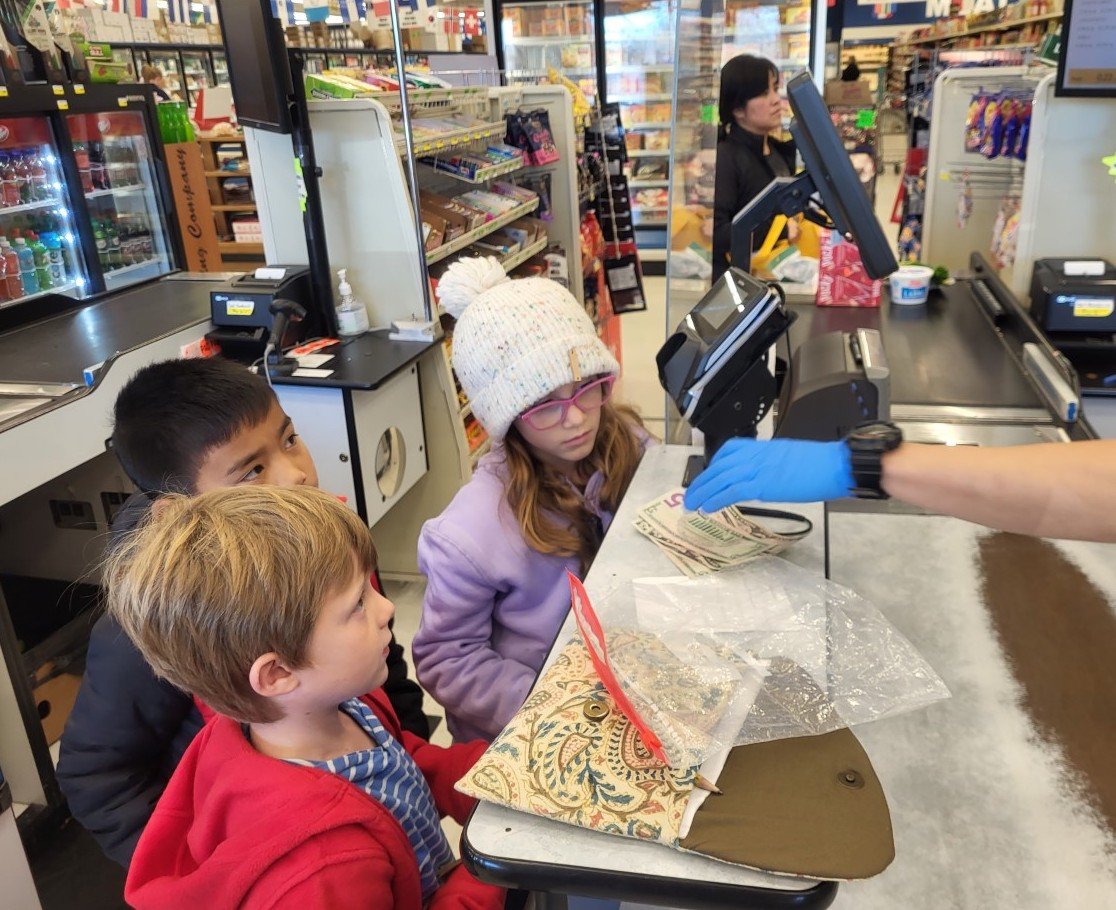 We are so lucky to have the supportive parent community and staff that expands our ability to take students on Going Outs. These experiences deepen the learning initiated in the classroom and foster the social development of the 2nd plane child.
We are so lucky to have the supportive parent community and staff that expands our ability to take students on Going Outs. These experiences deepen the learning initiated in the classroom and foster the social development of the 2nd plane child.







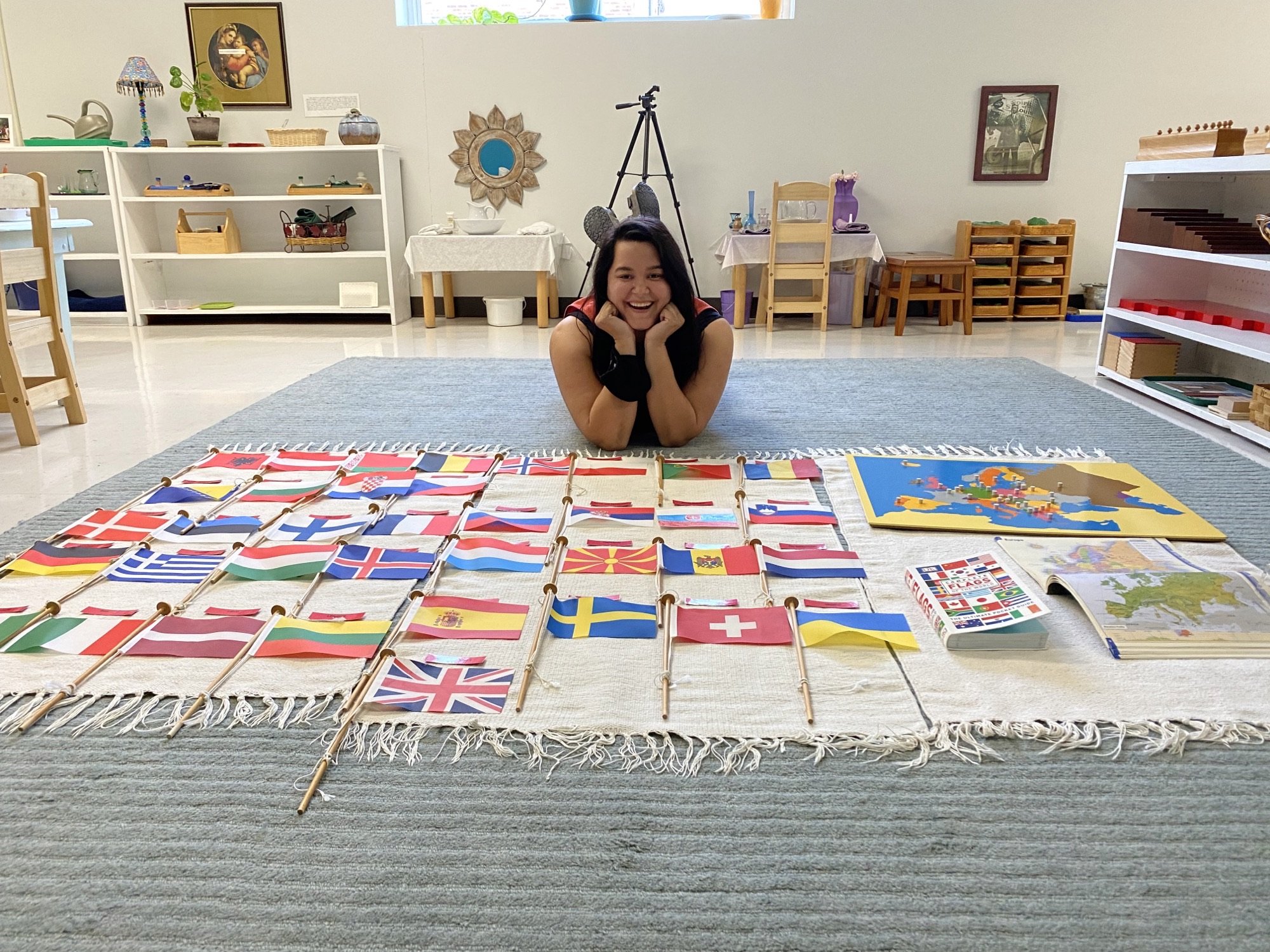
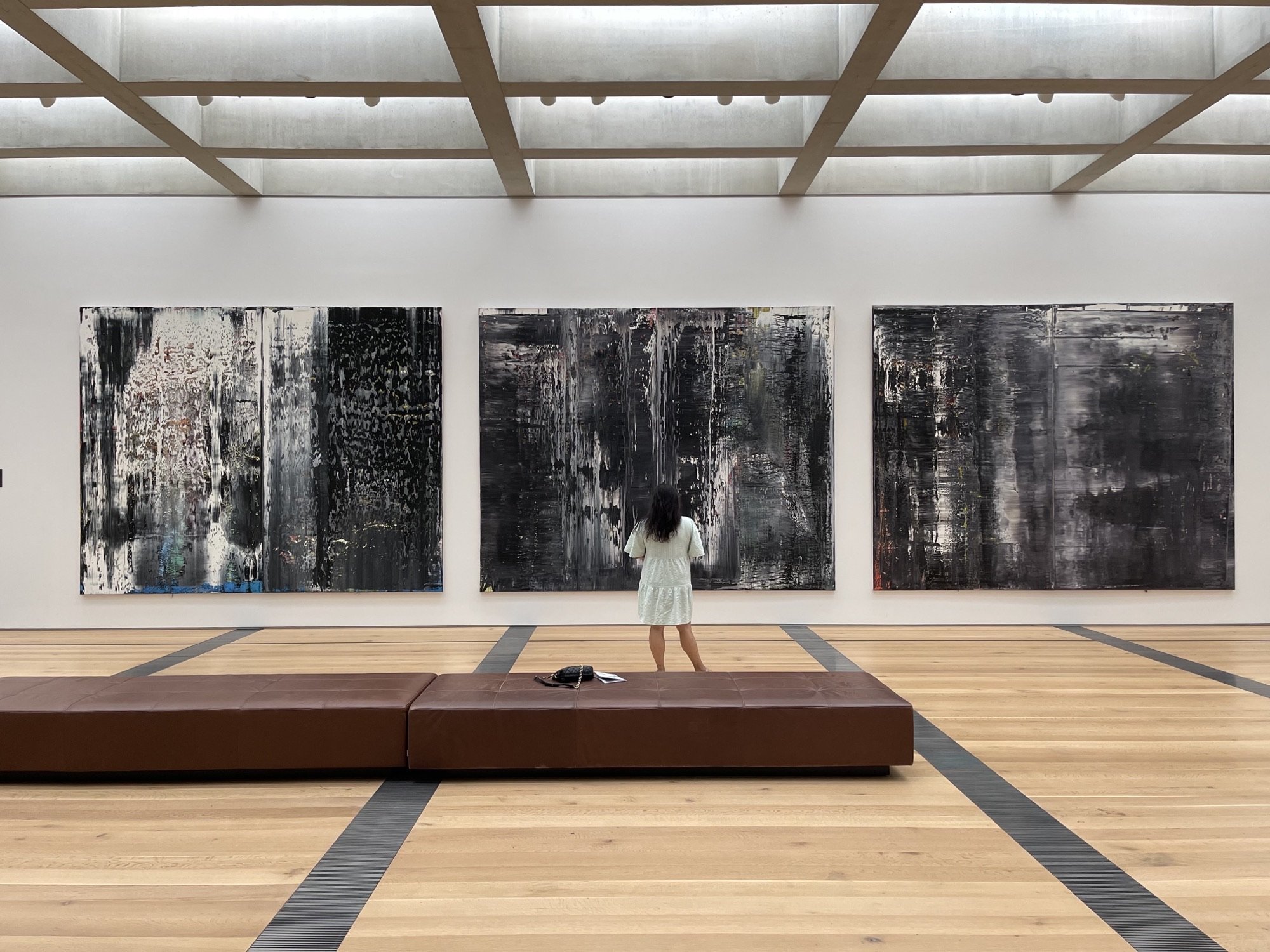
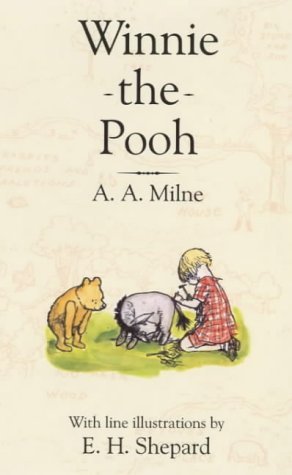











 As you consider these universal human tendencies, which ones do you notice most in yourself and your child? As you become aware of the tendencies operating in your daily life, how can you set up your own environment and schedule to facilitate their expression for you and your child?
As you consider these universal human tendencies, which ones do you notice most in yourself and your child? As you become aware of the tendencies operating in your daily life, how can you set up your own environment and schedule to facilitate their expression for you and your child? Dr. Maria Montessori believed that educators have the responsibility to understand universal human tendencies in order to best guide the child’s self-construction. When we embrace these tendencies in our own environments, we promote the flourishing of each child and help them realize their fullest potential in the world.
Dr. Maria Montessori believed that educators have the responsibility to understand universal human tendencies in order to best guide the child’s self-construction. When we embrace these tendencies in our own environments, we promote the flourishing of each child and help them realize their fullest potential in the world.

 At Villa di Maria, we’re not hiding the fact that we love Montessori and all the good things it offers children. We get to see the method in action every day and the joy it brings each student. Sometimes families come to us with misconceptions about the Montessori approach. They’ve heard things that don’t sit well with them or prompt skepticism. We love when people bring their questions to us because we know Montessori is up to the task and we relish an opportunity to discuss our favorite topic, Montessori education!
At Villa di Maria, we’re not hiding the fact that we love Montessori and all the good things it offers children. We get to see the method in action every day and the joy it brings each student. Sometimes families come to us with misconceptions about the Montessori approach. They’ve heard things that don’t sit well with them or prompt skepticism. We love when people bring their questions to us because we know Montessori is up to the task and we relish an opportunity to discuss our favorite topic, Montessori education! In this post we’ll address some of the myths people encounter about Montessori schools and students. We hope that it leads you to look again and consider all that this unique approach has to offer. Everyone is welcome, whether you know alot about Montessori or nothing at all!
In this post we’ll address some of the myths people encounter about Montessori schools and students. We hope that it leads you to look again and consider all that this unique approach has to offer. Everyone is welcome, whether you know alot about Montessori or nothing at all!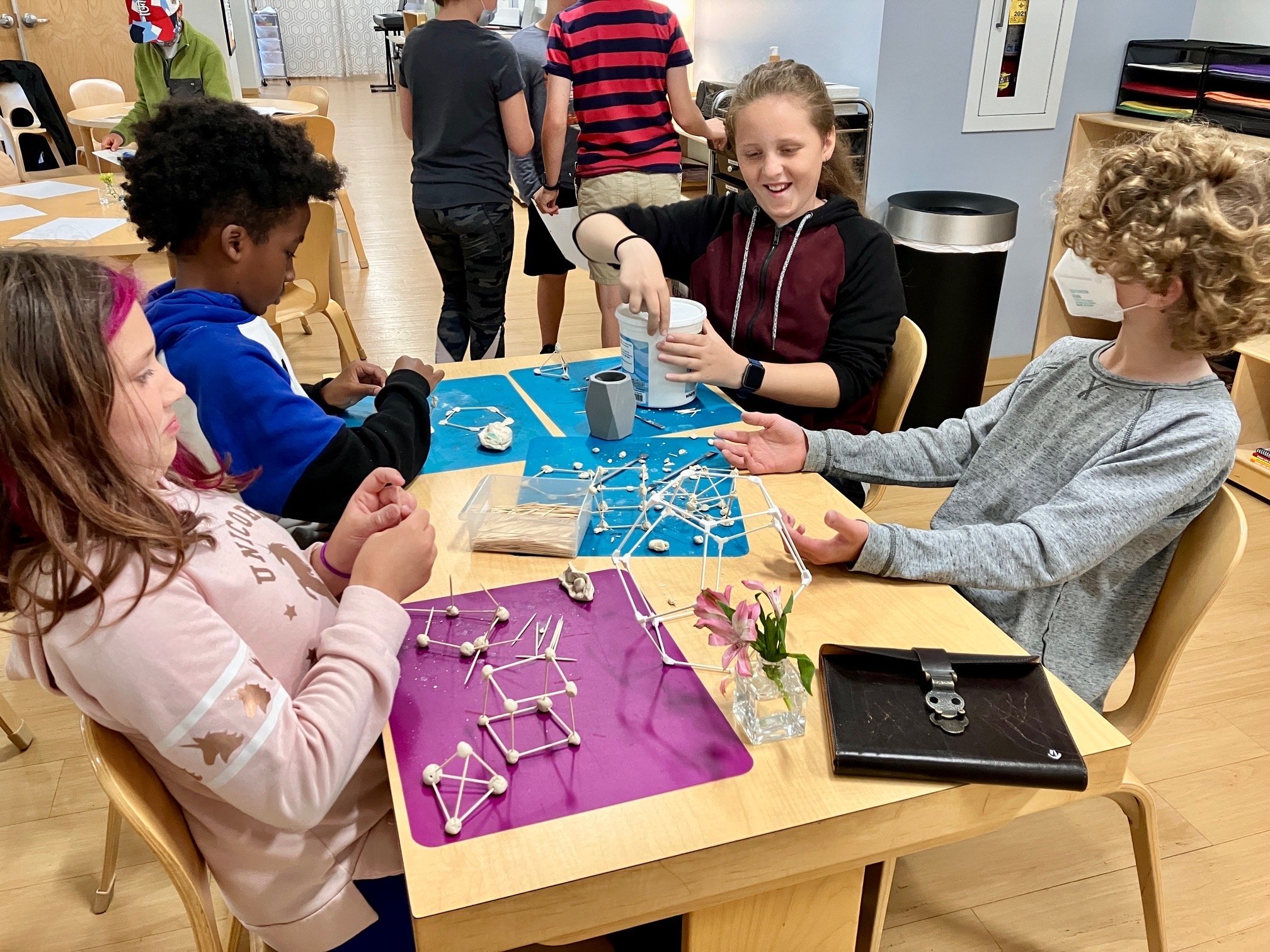
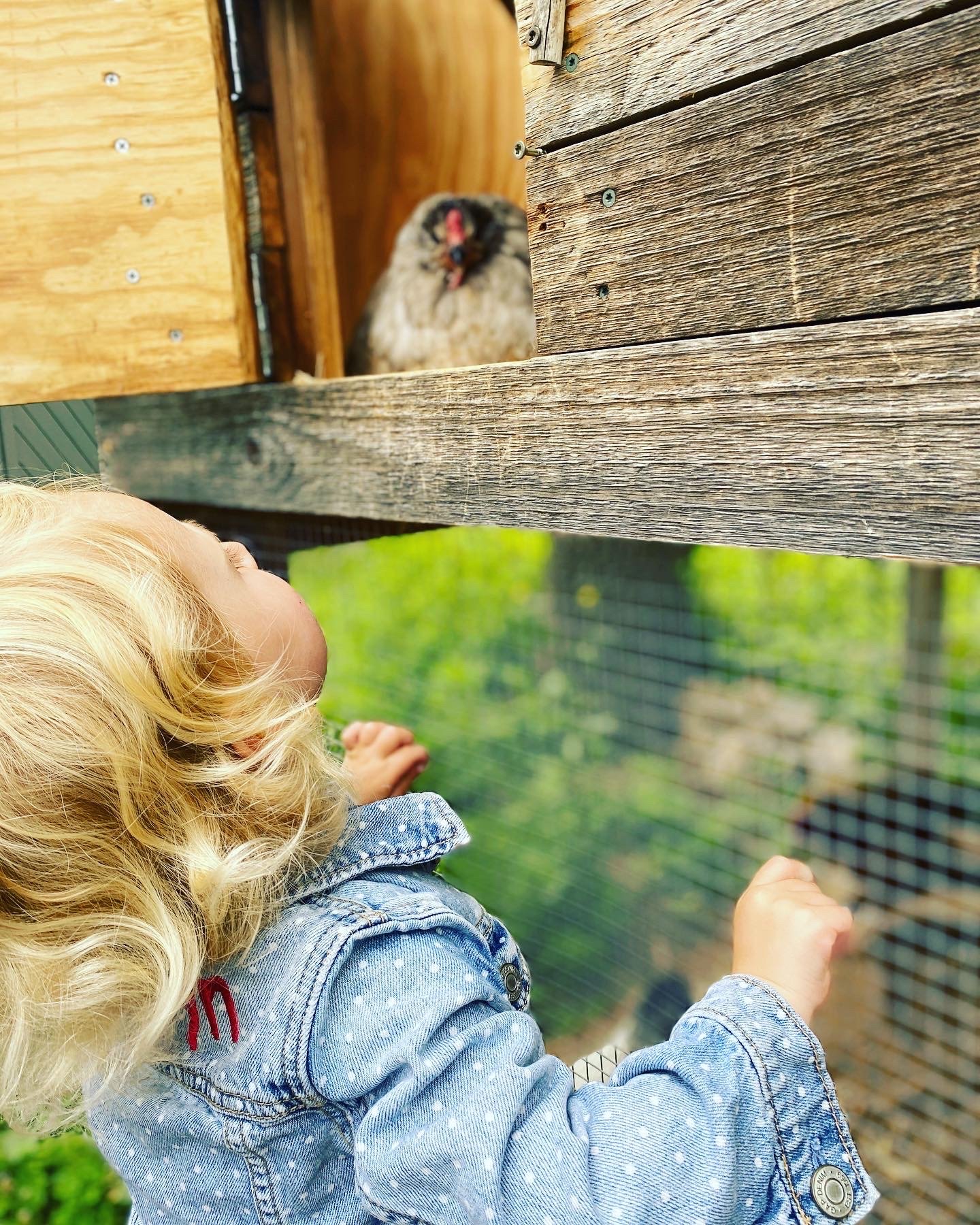
 What about homework?Though Montessori doesn't usually assign homework, through the development of self-management skills in the classroom (choosing their own work, etc.), students have no trouble managing homework in high school or college. Montessori students are used to arriving at their own understanding through manipulation of concrete materials and thus are better prepared to learn in any context throughout their lives. VdM has heard from many of our alums that they found it quite easy to transition to a traditional school experience, though they miss the Montessori setting! In the months to come, we’ll hear from some of these former students on the blog to learn how Montessori prepared them for life after VdM.
What about homework?Though Montessori doesn't usually assign homework, through the development of self-management skills in the classroom (choosing their own work, etc.), students have no trouble managing homework in high school or college. Montessori students are used to arriving at their own understanding through manipulation of concrete materials and thus are better prepared to learn in any context throughout their lives. VdM has heard from many of our alums that they found it quite easy to transition to a traditional school experience, though they miss the Montessori setting! In the months to come, we’ll hear from some of these former students on the blog to learn how Montessori prepared them for life after VdM.

 In Elementary, guides utilize tools such as the work journal and the weekly conference to hold students accountable for their use of work time. Elementary students record their work choices and the duration spent on each activity throughout the work periods (morning and afternoon) in their work journals. The guide and student then meet each week to review the work in their journals and reflect together on the use of the work periods to cover all subject areas of the classroom. They also set goals for the following week and make plans for improvement and growth.
In Elementary, guides utilize tools such as the work journal and the weekly conference to hold students accountable for their use of work time. Elementary students record their work choices and the duration spent on each activity throughout the work periods (morning and afternoon) in their work journals. The guide and student then meet each week to review the work in their journals and reflect together on the use of the work periods to cover all subject areas of the classroom. They also set goals for the following week and make plans for improvement and growth.

 We hope addressing these commonly heard Montessori myths prompts you to further explore your own questions about how best to achieve a holistic, child-centered approach to education. We believe Montessori best fits the developmental needs of the child at each age and stage of development and we’d love to talk to you more about how! Reach out to our staff to talk more or peruse our rich resource of blog posts. Here’s a good place to start:
We hope addressing these commonly heard Montessori myths prompts you to further explore your own questions about how best to achieve a holistic, child-centered approach to education. We believe Montessori best fits the developmental needs of the child at each age and stage of development and we’d love to talk to you more about how! Reach out to our staff to talk more or peruse our rich resource of blog posts. Here’s a good place to start:

 Traditionally, graduation opens with an address by their guide, Ms. Rebecca. This year Rebecca framed the event in terms of “superpowers” the students possessed. She shared how each individual used their special powers for the good of VdM to improve our community during their time here. She called on them to continue to develop and carry these superpowers into their next endeavors.
Traditionally, graduation opens with an address by their guide, Ms. Rebecca. This year Rebecca framed the event in terms of “superpowers” the students possessed. She shared how each individual used their special powers for the good of VdM to improve our community during their time here. She called on them to continue to develop and carry these superpowers into their next endeavors. The highlight of the ceremony is the presentation of the students’ speeches. Upper Elementary guides offer editing assistance during the writing process, but the words and ideas come authentically from the students. Each sixth year is asked to describe their journey at VdM in terms of the metaphor that best frames their experience and describes their unique strengths and weaknesses during their time at VdM. This year students chose metaphors such as video gaming, the journey of the hero in a novel, cooking, and many more!
The highlight of the ceremony is the presentation of the students’ speeches. Upper Elementary guides offer editing assistance during the writing process, but the words and ideas come authentically from the students. Each sixth year is asked to describe their journey at VdM in terms of the metaphor that best frames their experience and describes their unique strengths and weaknesses during their time at VdM. This year students chose metaphors such as video gaming, the journey of the hero in a novel, cooking, and many more! It is a treat to hear the unique style and expression in each speech, revealing the personality of the speaker. Many students shared about the challenges the pandemic brought into their lives, as they had to learn from home for a portion of their career at VdM. As the VdM community takes in these speeches, we bask in amazement at how far each child has come in their self-awareness, emotional intelligence, writing ability and confidence to speak with such poise in front of a large crowd. Each sixth-year student spoke with an eloquence and calm beyond their years!
It is a treat to hear the unique style and expression in each speech, revealing the personality of the speaker. Many students shared about the challenges the pandemic brought into their lives, as they had to learn from home for a portion of their career at VdM. As the VdM community takes in these speeches, we bask in amazement at how far each child has come in their self-awareness, emotional intelligence, writing ability and confidence to speak with such poise in front of a large crowd. Each sixth-year student spoke with an eloquence and calm beyond their years! 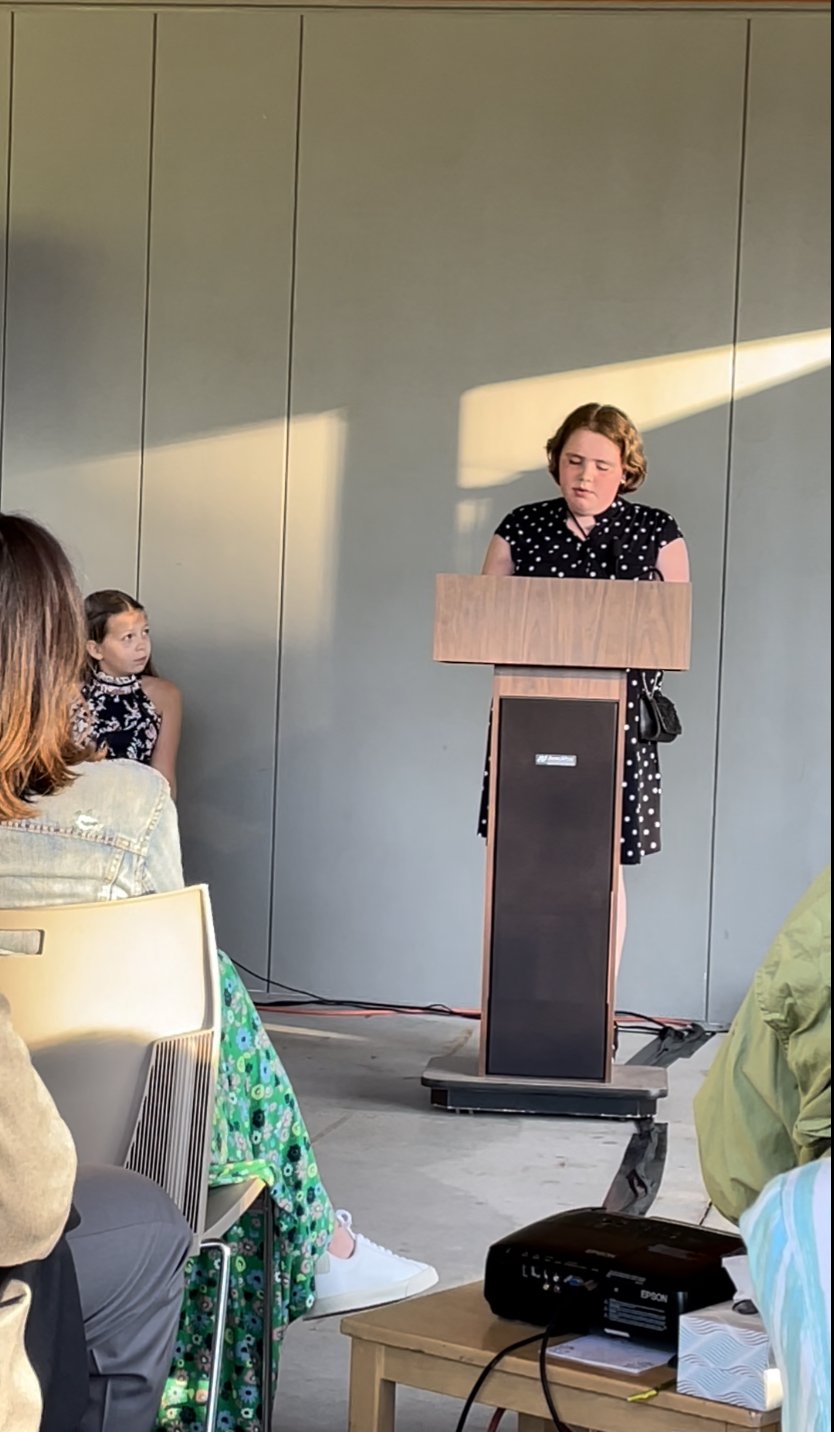 Next come the fifth-year dedications—fifth-year students share their own short speeches about the graduates. Many of the fifth- and sixth-year students have long and meaningful friendships that go back to their shared time in the Children’s House. During the dedication speeches, the fifth years share their memories about their older classmates with humor, fondness and admiration.
Next come the fifth-year dedications—fifth-year students share their own short speeches about the graduates. Many of the fifth- and sixth-year students have long and meaningful friendships that go back to their shared time in the Children’s House. During the dedication speeches, the fifth years share their memories about their older classmates with humor, fondness and admiration.  After speeches comes the photo slideshow of each graduate from infancy to present day. Many “awws” were heard as the crowd enjoyed cute baby photos of the now-12-year-olds standing before them.
After speeches comes the photo slideshow of each graduate from infancy to present day. Many “awws” were heard as the crowd enjoyed cute baby photos of the now-12-year-olds standing before them.
 Finally, diplomas are awarded by the Head of School. Handshakes, hugs and high fives are shared by their teachers and fellow graduates as tears and applause flow from the audience.
Finally, diplomas are awarded by the Head of School. Handshakes, hugs and high fives are shared by their teachers and fellow graduates as tears and applause flow from the audience.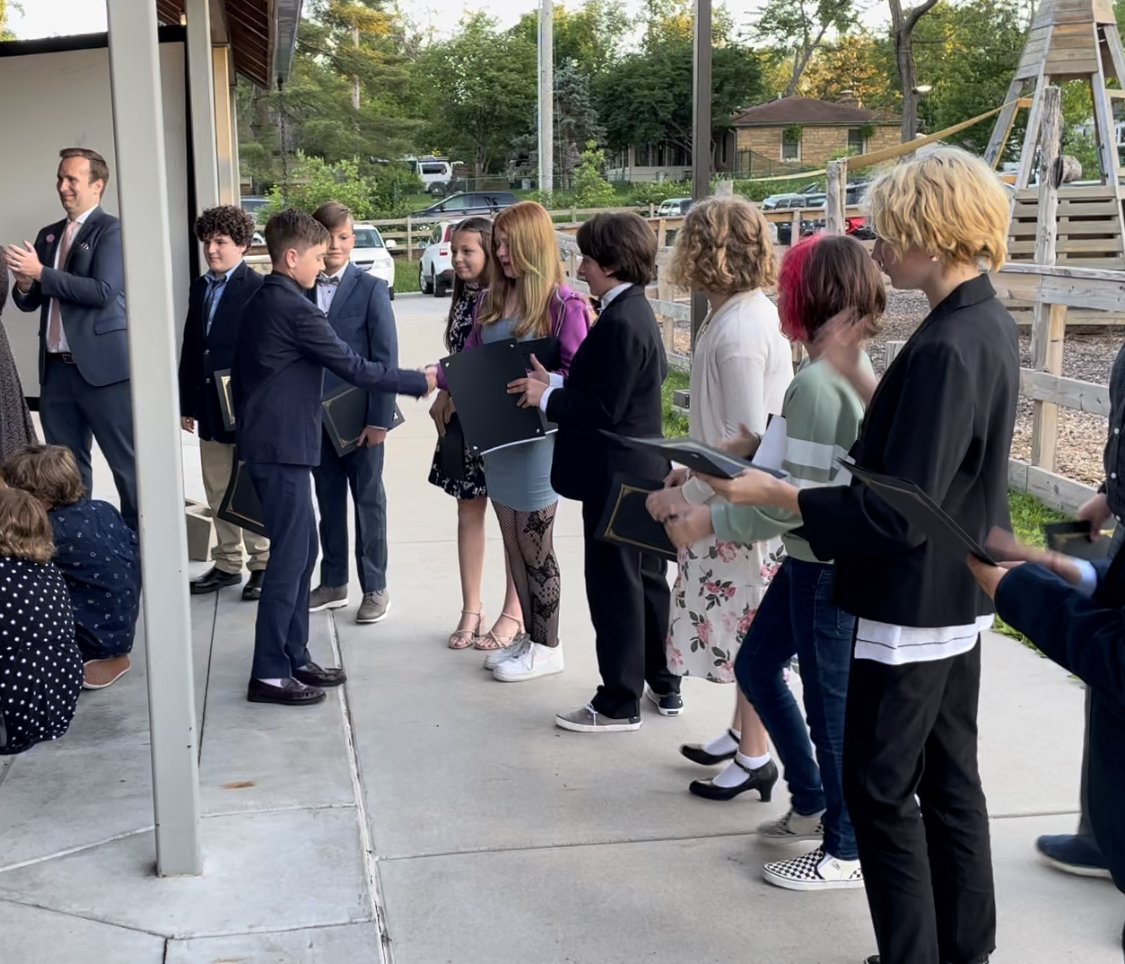 As we say goodbye to some of our favorite people, we do so with great joy and pride, knowing they will carry their unique superpowers and growing self-assuredness into the world with them to make it a better place. Thank you, graduates, for how you have shaped and led our community at VdM this year. We look forward to seeing your faces again and hearing of new adventures when you come back to visit!!
As we say goodbye to some of our favorite people, we do so with great joy and pride, knowing they will carry their unique superpowers and growing self-assuredness into the world with them to make it a better place. Thank you, graduates, for how you have shaped and led our community at VdM this year. We look forward to seeing your faces again and hearing of new adventures when you come back to visit!!
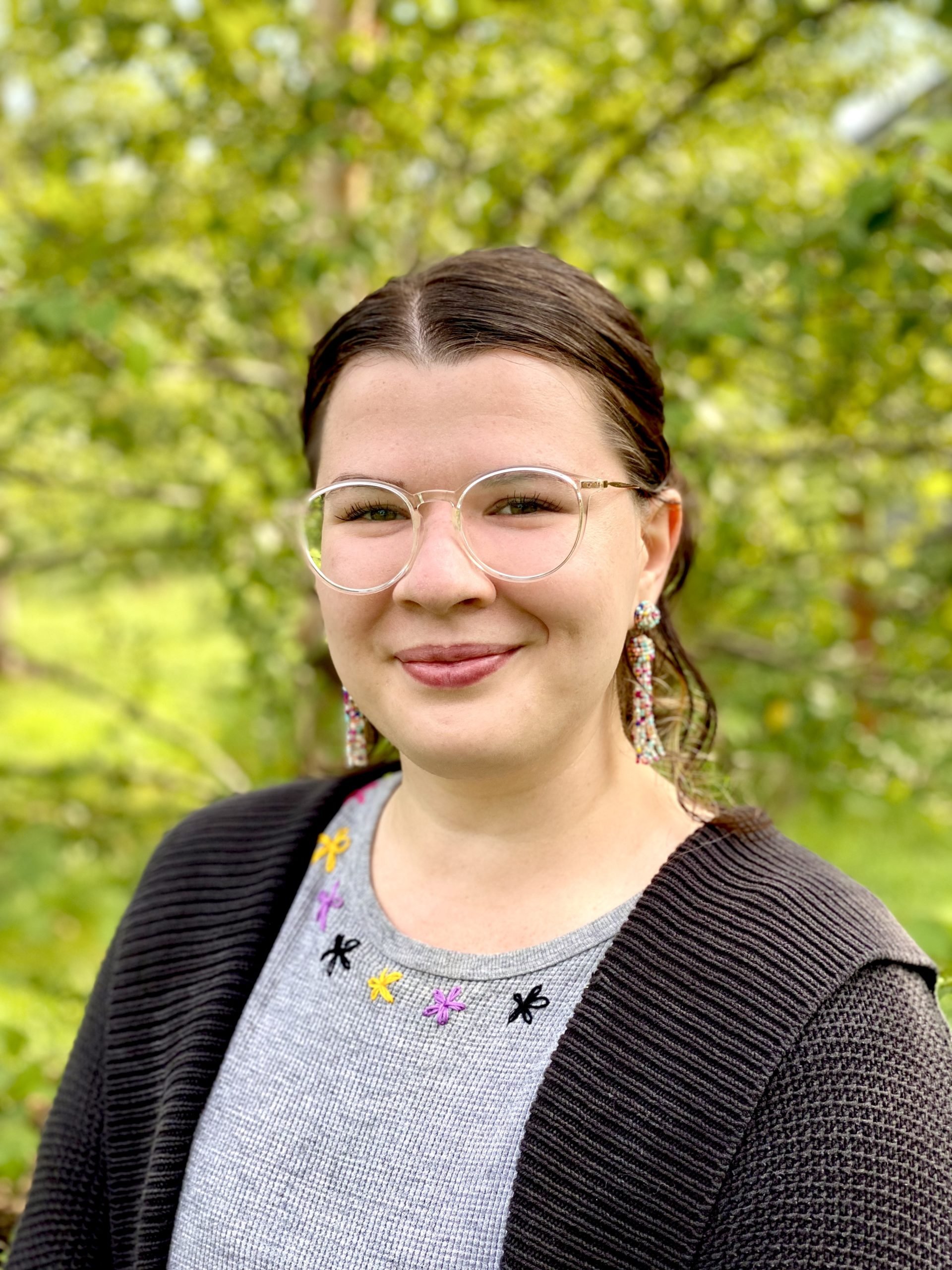

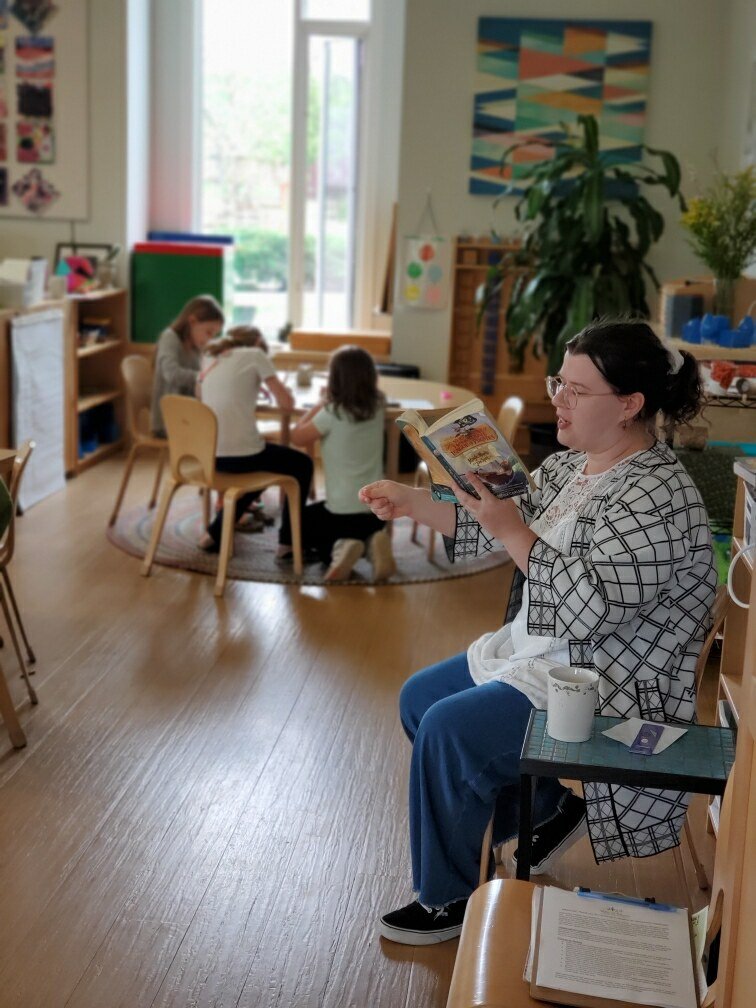

 While we (shamelessly) love to show off our school and community in the Villa di Maria blog, we are also here to spread the word about Montessori beyond our campus—demystifying and celebrating the Montessori method of education in the hopes that more people will discover its benefits for children and families.
While we (shamelessly) love to show off our school and community in the Villa di Maria blog, we are also here to spread the word about Montessori beyond our campus—demystifying and celebrating the Montessori method of education in the hopes that more people will discover its benefits for children and families. You’ve seen our recent posts from our 101 series, where we breakdown some of the terminology you might find in a Montessori school. This week, we’ll kick off another series, all about Montessori theory. In our Theory series, we’ll dive deep into the foundational principles of the Montessori method and take a look at how these theories come into practice in the school setting. We’ll start today with “The Four Planes of Development.” The work of the Montessori guide, the organization of the Montessori classroom, the design and function of Montessori materials—everything about the Montessori method—it all comes down to the four planes.
You’ve seen our recent posts from our 101 series, where we breakdown some of the terminology you might find in a Montessori school. This week, we’ll kick off another series, all about Montessori theory. In our Theory series, we’ll dive deep into the foundational principles of the Montessori method and take a look at how these theories come into practice in the school setting. We’ll start today with “The Four Planes of Development.” The work of the Montessori guide, the organization of the Montessori classroom, the design and function of Montessori materials—everything about the Montessori method—it all comes down to the four planes. The four planes of development are 6-year stages of child development, from birth to adulthood. In her research and work with children, Dr. Maria Montessori observed that children and adolescents develop through natural stages which can be defined by specific characteristics and developmental needs: birth to age 6; ages 6 to 12; ages 12 to 18, and ages 18 to 24. Dr. Montessori believed it was crucial to serve the specific developmental characteristics and needs of children in each plane, to allow them to move with strength into each following plane and prepare them for adulthood.
The four planes of development are 6-year stages of child development, from birth to adulthood. In her research and work with children, Dr. Maria Montessori observed that children and adolescents develop through natural stages which can be defined by specific characteristics and developmental needs: birth to age 6; ages 6 to 12; ages 12 to 18, and ages 18 to 24. Dr. Montessori believed it was crucial to serve the specific developmental characteristics and needs of children in each plane, to allow them to move with strength into each following plane and prepare them for adulthood.
 Montessori education is designed to follow children through these planes—through their natural patterns of development. Montessori classroom environments intentionally foster the natural characteristics of each plane. Montessori guides receive rigorous training to facilitate each child’s incredible journey through each plane by meeting and challenging their academic, social, and emotional needs.
Montessori education is designed to follow children through these planes—through their natural patterns of development. Montessori classroom environments intentionally foster the natural characteristics of each plane. Montessori guides receive rigorous training to facilitate each child’s incredible journey through each plane by meeting and challenging their academic, social, and emotional needs.





 Isn’t this what we want for our kids, to reach adulthood with the independence, security, and wholeness to make the world a better place? It’s what Dr. Montessori wanted and why she devoted her life to understanding child development and promoting better education for children. Because of her knowledge of the four planes, children at Villa di Maria get to experience the fullness and beauty of each plane in our classrooms from ages 14 months to 12 years and emerge from VdM in strength to enter adolescence and adulthood.References: “From Childhood to Adolescence” by Dr. Maria Montessori
Isn’t this what we want for our kids, to reach adulthood with the independence, security, and wholeness to make the world a better place? It’s what Dr. Montessori wanted and why she devoted her life to understanding child development and promoting better education for children. Because of her knowledge of the four planes, children at Villa di Maria get to experience the fullness and beauty of each plane in our classrooms from ages 14 months to 12 years and emerge from VdM in strength to enter adolescence and adulthood.References: “From Childhood to Adolescence” by Dr. Maria Montessori

 Montessori is grounded in two very important principles: the natural patterns of child development and child-led progress. Montessori believes each child progresses within general time frames (the Planes of Development), but at their own unique pace. From a Montessori perspective, formal test-taking does not give a complete picture of a child’s progression. A Montessori education is about more than what can be shown on a test. It is about leading each child toward the fulfillment of their highest potential in every aspect of their person, academically, socially, and emotionally—about giving each child a vision for life.
Montessori is grounded in two very important principles: the natural patterns of child development and child-led progress. Montessori believes each child progresses within general time frames (the Planes of Development), but at their own unique pace. From a Montessori perspective, formal test-taking does not give a complete picture of a child’s progression. A Montessori education is about more than what can be shown on a test. It is about leading each child toward the fulfillment of their highest potential in every aspect of their person, academically, socially, and emotionally—about giving each child a vision for life. This calling goes beyond preparing children to simply memorize and regurgitate material for an exam. Instead, the Montessori approach measures progress (a.k.a. assesses children) consistently throughout their time in the classroom environment. Montessori guides use a variety of methods to help each child meet their developmental milestones and master the academic curriculum and social skills appropriate for their age group.
This calling goes beyond preparing children to simply memorize and regurgitate material for an exam. Instead, the Montessori approach measures progress (a.k.a. assesses children) consistently throughout their time in the classroom environment. Montessori guides use a variety of methods to help each child meet their developmental milestones and master the academic curriculum and social skills appropriate for their age group. One way guides assess a student is through observation. In a Montessori classroom the guide carefully, deliberately, and objectively observes the children. This is an active, daily practice—they are watching and learning about each child as they practice their lessons every day. Allowing each child the time they need, the guide notices, listens—waits for indication that the child is progressing in the comprehension of, ease with, and precision in their work. Guides make themselves available for questions or requests for assistance and are ready to re-present a lesson (or a certain part of difficulty) as needed. And when a child has mastered a lesson, guides offer the next lesson in the sequence.
One way guides assess a student is through observation. In a Montessori classroom the guide carefully, deliberately, and objectively observes the children. This is an active, daily practice—they are watching and learning about each child as they practice their lessons every day. Allowing each child the time they need, the guide notices, listens—waits for indication that the child is progressing in the comprehension of, ease with, and precision in their work. Guides make themselves available for questions or requests for assistance and are ready to re-present a lesson (or a certain part of difficulty) as needed. And when a child has mastered a lesson, guides offer the next lesson in the sequence. Assessment is also integrated into the lessons offered by the guide. For every child, at the start of a new lesson, the guide reviews the previous lesson content to “test” what students remember and to build upon that knowledge. Throughout the day, the guides might also unexpectedly join a student at work to ask them questions about their activity—a sort of Montessori pop quiz. “I see you working on the area of a circle. Do you remember what we call the outside edge of the circle?”
Assessment is also integrated into the lessons offered by the guide. For every child, at the start of a new lesson, the guide reviews the previous lesson content to “test” what students remember and to build upon that knowledge. Throughout the day, the guides might also unexpectedly join a student at work to ask them questions about their activity—a sort of Montessori pop quiz. “I see you working on the area of a circle. Do you remember what we call the outside edge of the circle?” At the Elementary level, the weekly conference is introduced. Guides check children’s work and note if lessons have been revisited, and if so, whether they are doing so correctly. Guides note whether a child is avoiding certain lessons and make a plan with the child for completion. They also make children aware of the state and national standards society expects them to know by certain grade levels. Children are actively engaged in their own assessments and are motivated (or redirected) to focus their work where needed.
At the Elementary level, the weekly conference is introduced. Guides check children’s work and note if lessons have been revisited, and if so, whether they are doing so correctly. Guides note whether a child is avoiding certain lessons and make a plan with the child for completion. They also make children aware of the state and national standards society expects them to know by certain grade levels. Children are actively engaged in their own assessments and are motivated (or redirected) to focus their work where needed. In the Upper Elementary we add in one more layer of assessment—the annual standardized test. The primary purpose of the test on our campus is to provide students the opportunity to develop the formal testing skills, as well as a test-taking comfort level they will almost certainly need as they grow older.
In the Upper Elementary we add in one more layer of assessment—the annual standardized test. The primary purpose of the test on our campus is to provide students the opportunity to develop the formal testing skills, as well as a test-taking comfort level they will almost certainly need as they grow older. At Villa di Maria, we love that students are not limited to learning only what the state requires. State standards are the baseline, but most students go beyond and learn about anything they are interested in. The universe is the limit to their learning!
At Villa di Maria, we love that students are not limited to learning only what the state requires. State standards are the baseline, but most students go beyond and learn about anything they are interested in. The universe is the limit to their learning! Montessori Model United Nations, affectionately known as MMUN, is a special journey for our sixth-year students, which culminates in a five-day trip to New York City for an international conference. Similar to traditional Model UN programs, each student assumes the role of delegate for a chosen nation and proposes solutions to complex global issues from their nation’s point of view.
Montessori Model United Nations, affectionately known as MMUN, is a special journey for our sixth-year students, which culminates in a five-day trip to New York City for an international conference. Similar to traditional Model UN programs, each student assumes the role of delegate for a chosen nation and proposes solutions to complex global issues from their nation’s point of view. 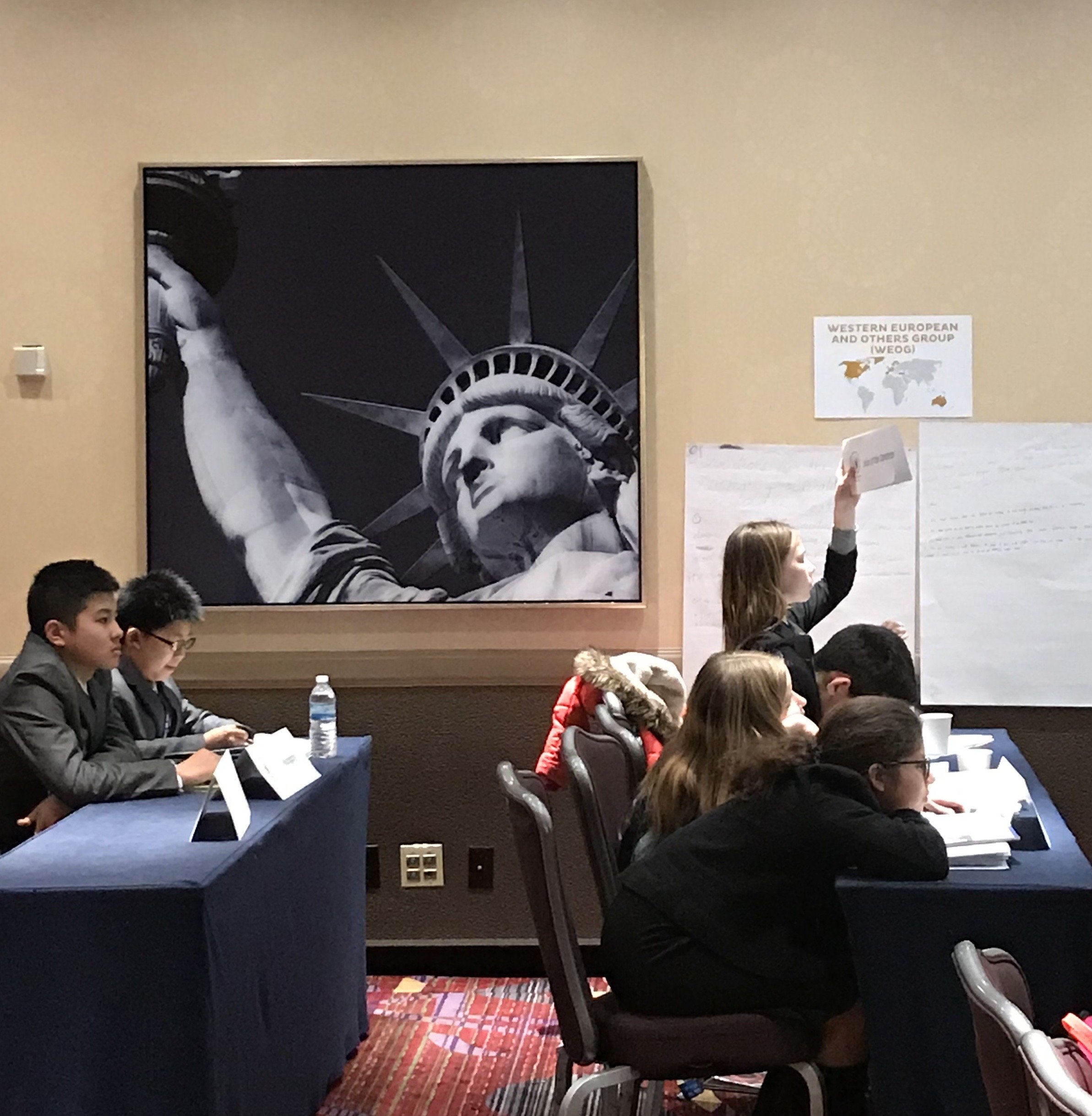
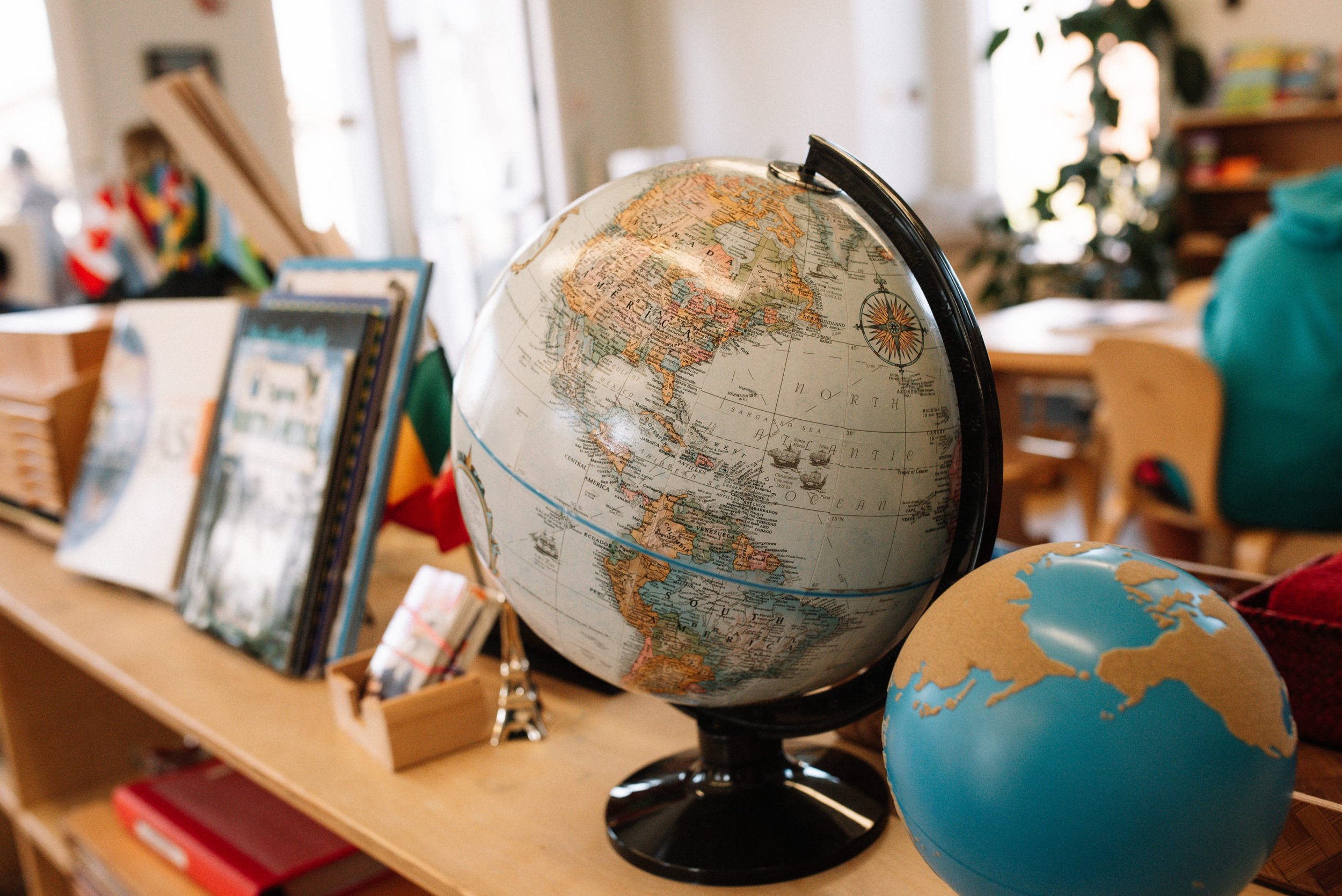
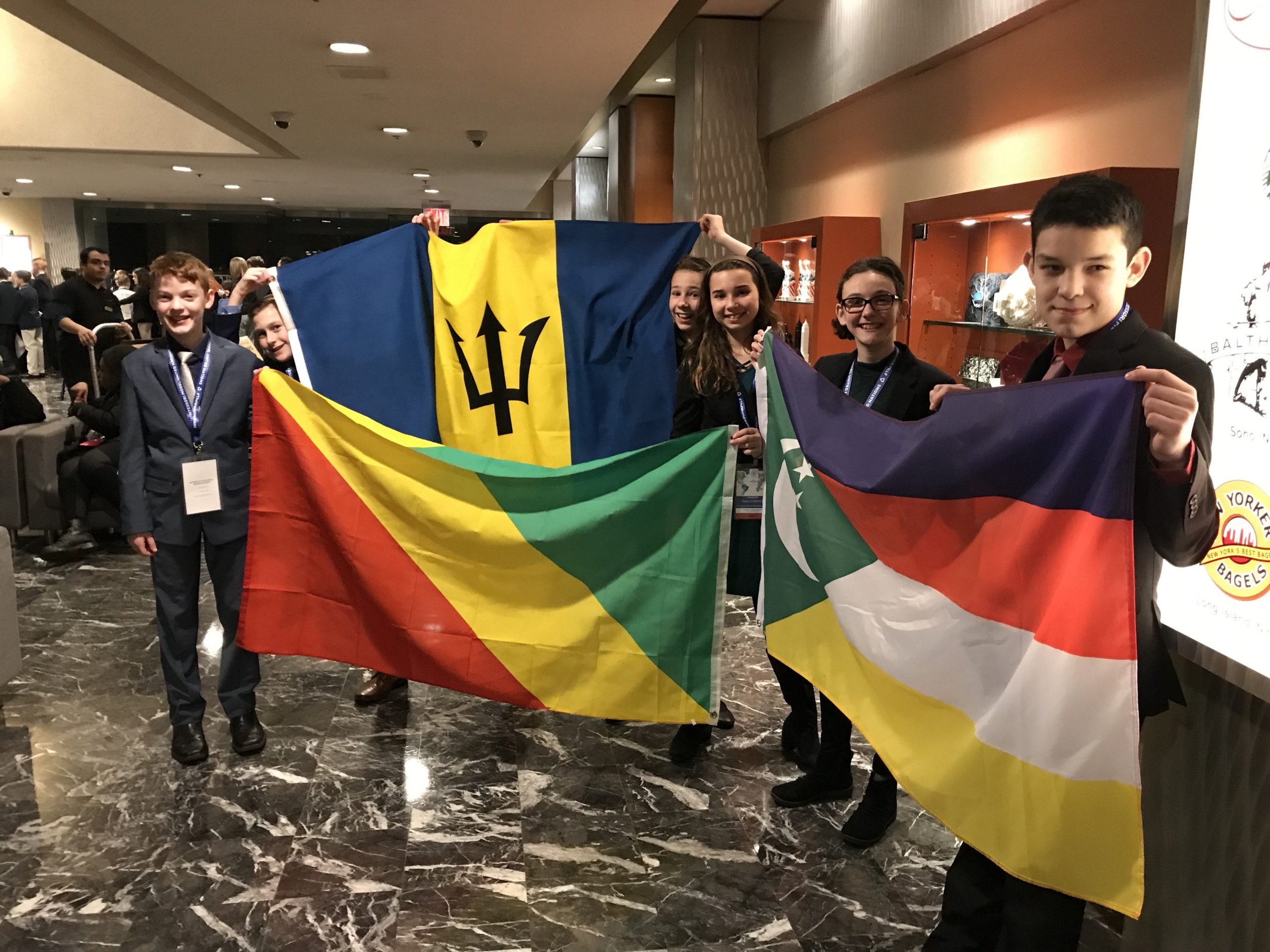 Delegates are assigned to UN Committees, which address complex issues like food security, fair trade, nuclear disarmament, xenophobia, poverty, and climate change. Their research now becomes focused on their particular topic. Students work to gain an understanding not only of the subject itself but also of their nations' approach to that subject. Our emerging adolescents must consider their own perspectives on these issues, and then do the challenging work to consider differing perspectives of others. During this process, the students' empathy for others and awareness of themselves as global citizens grow immensely.
Delegates are assigned to UN Committees, which address complex issues like food security, fair trade, nuclear disarmament, xenophobia, poverty, and climate change. Their research now becomes focused on their particular topic. Students work to gain an understanding not only of the subject itself but also of their nations' approach to that subject. Our emerging adolescents must consider their own perspectives on these issues, and then do the challenging work to consider differing perspectives of others. During this process, the students' empathy for others and awareness of themselves as global citizens grow immensely.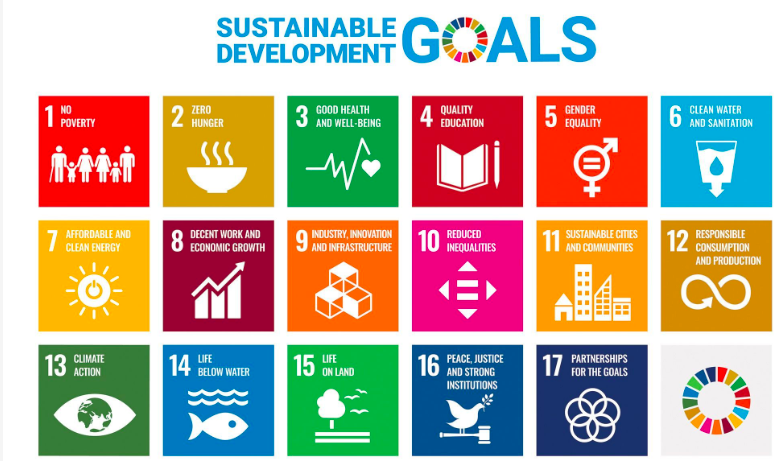 As does their research skillset: synthesizing information from multiple sources, evaluating websites for bias and authenticity, supporting claims with evidence, and always citing sources.
As does their research skillset: synthesizing information from multiple sources, evaluating websites for bias and authenticity, supporting claims with evidence, and always citing sources.
 To ease their apprehension, our delegates rehearse often with one another, offering feedback and support. And as a dress rehearsal, each delegate distills their position paper into a one-minute speech designed to inform an audience of their families and classroom peers about their issue and compel them to support the proposed solutions.
To ease their apprehension, our delegates rehearse often with one another, offering feedback and support. And as a dress rehearsal, each delegate distills their position paper into a one-minute speech designed to inform an audience of their families and classroom peers about their issue and compel them to support the proposed solutions.
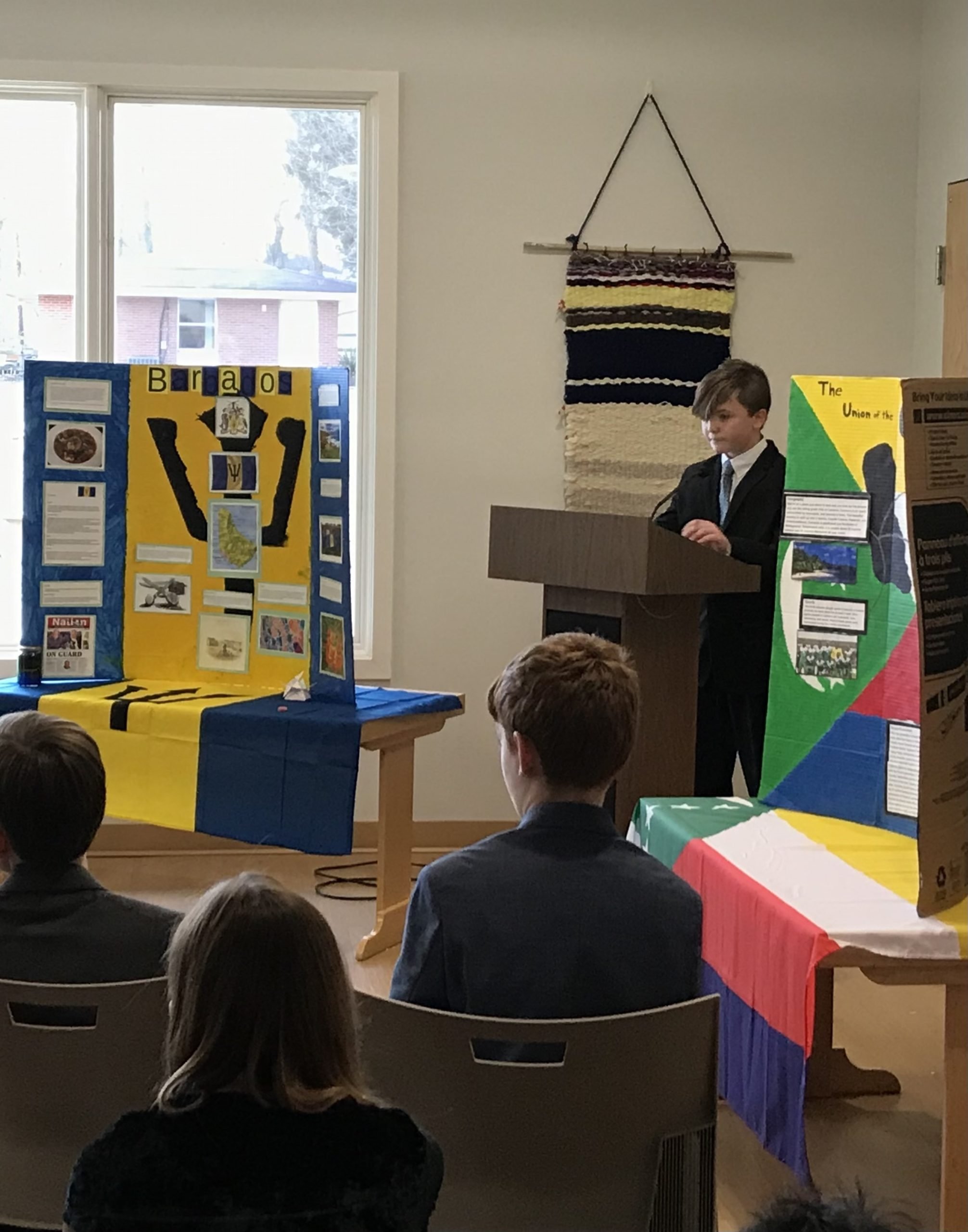 By the time they arrive in NYC, they are ready to deliver their speech with confidence.
By the time they arrive in NYC, they are ready to deliver their speech with confidence.
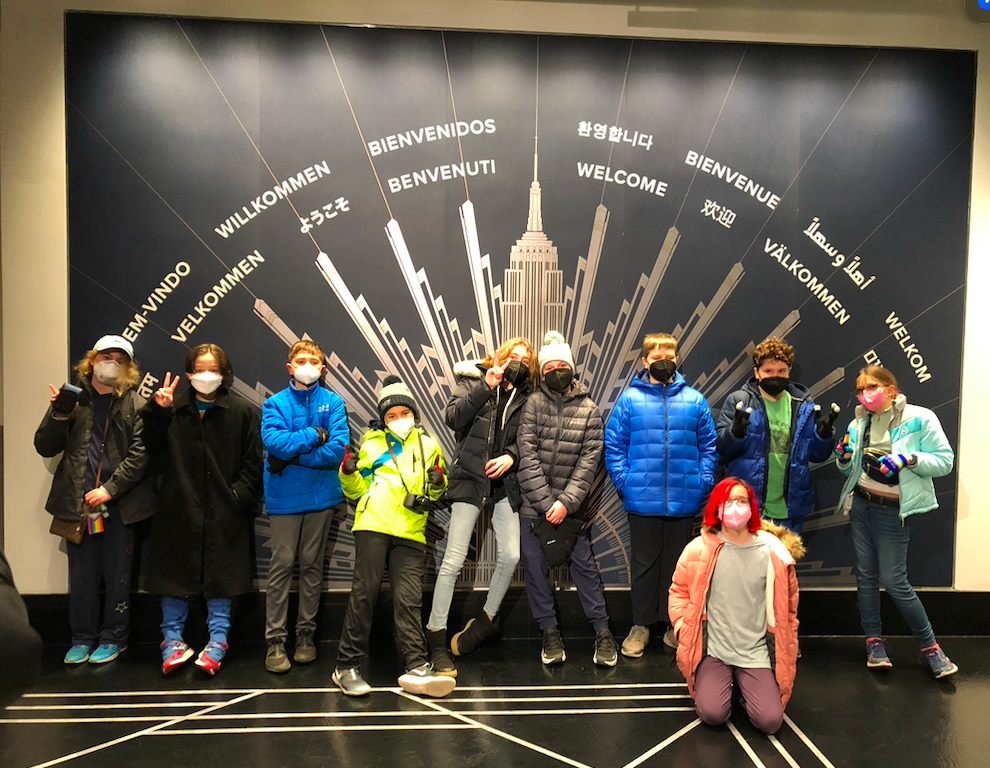
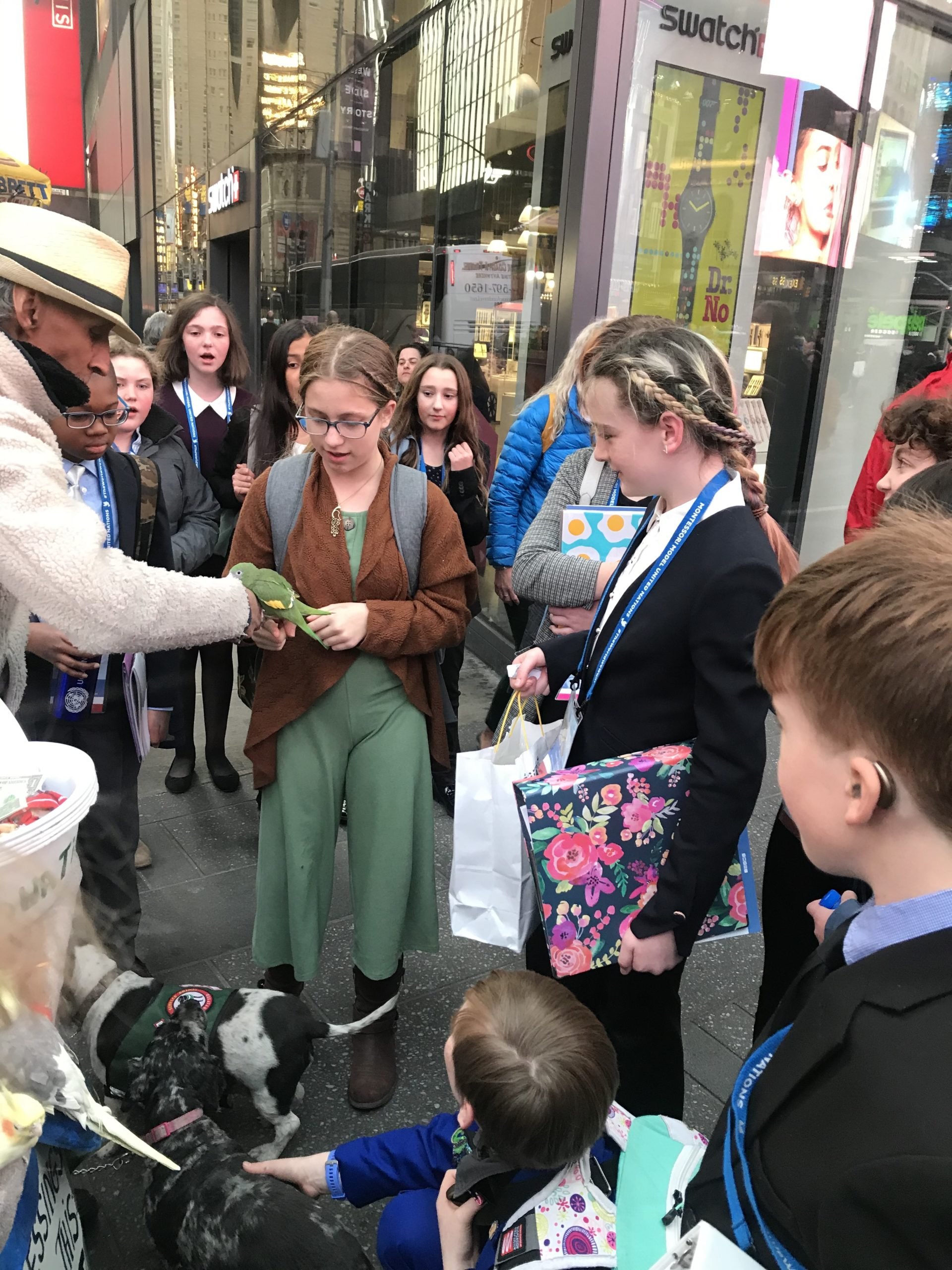
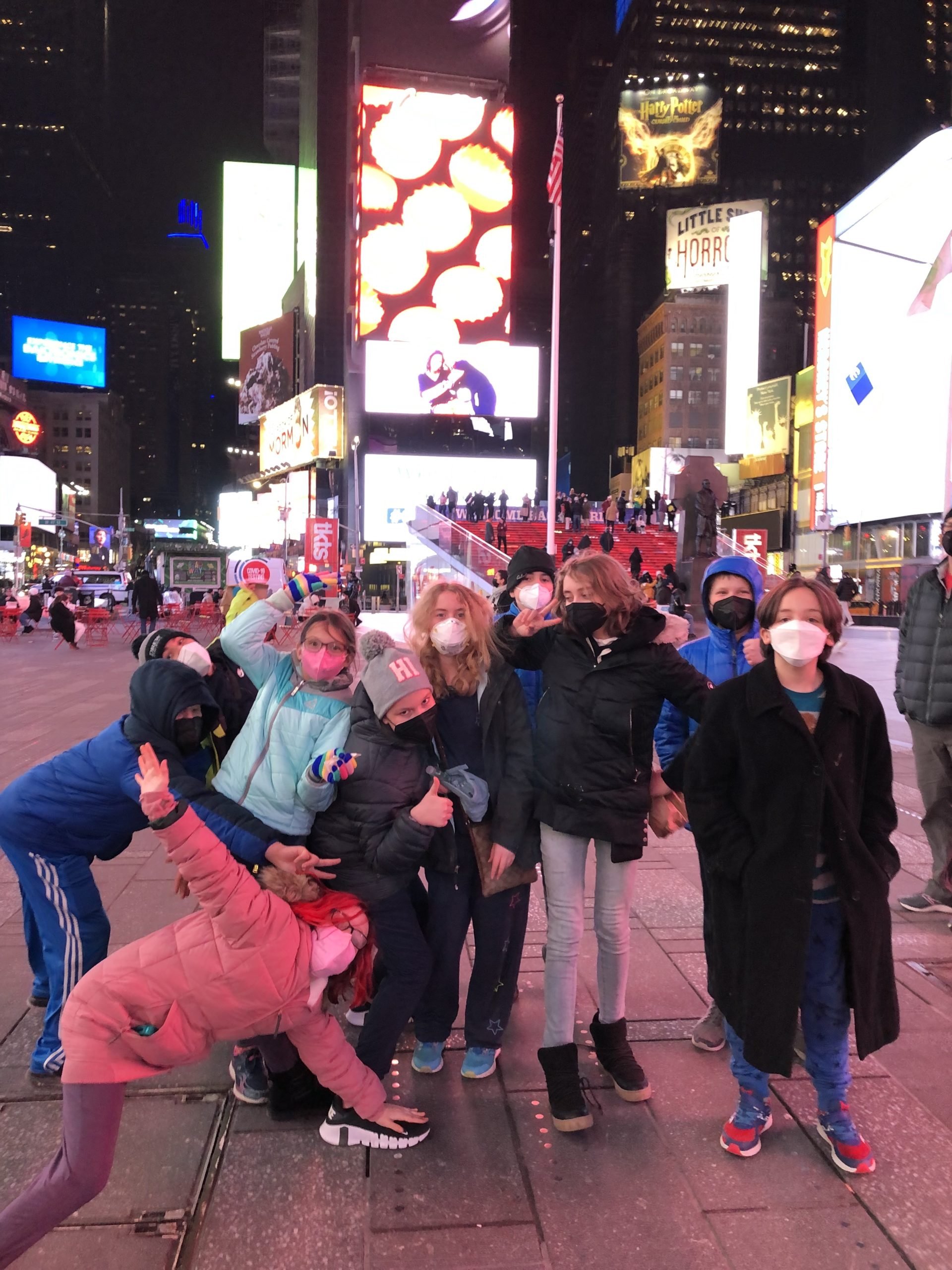
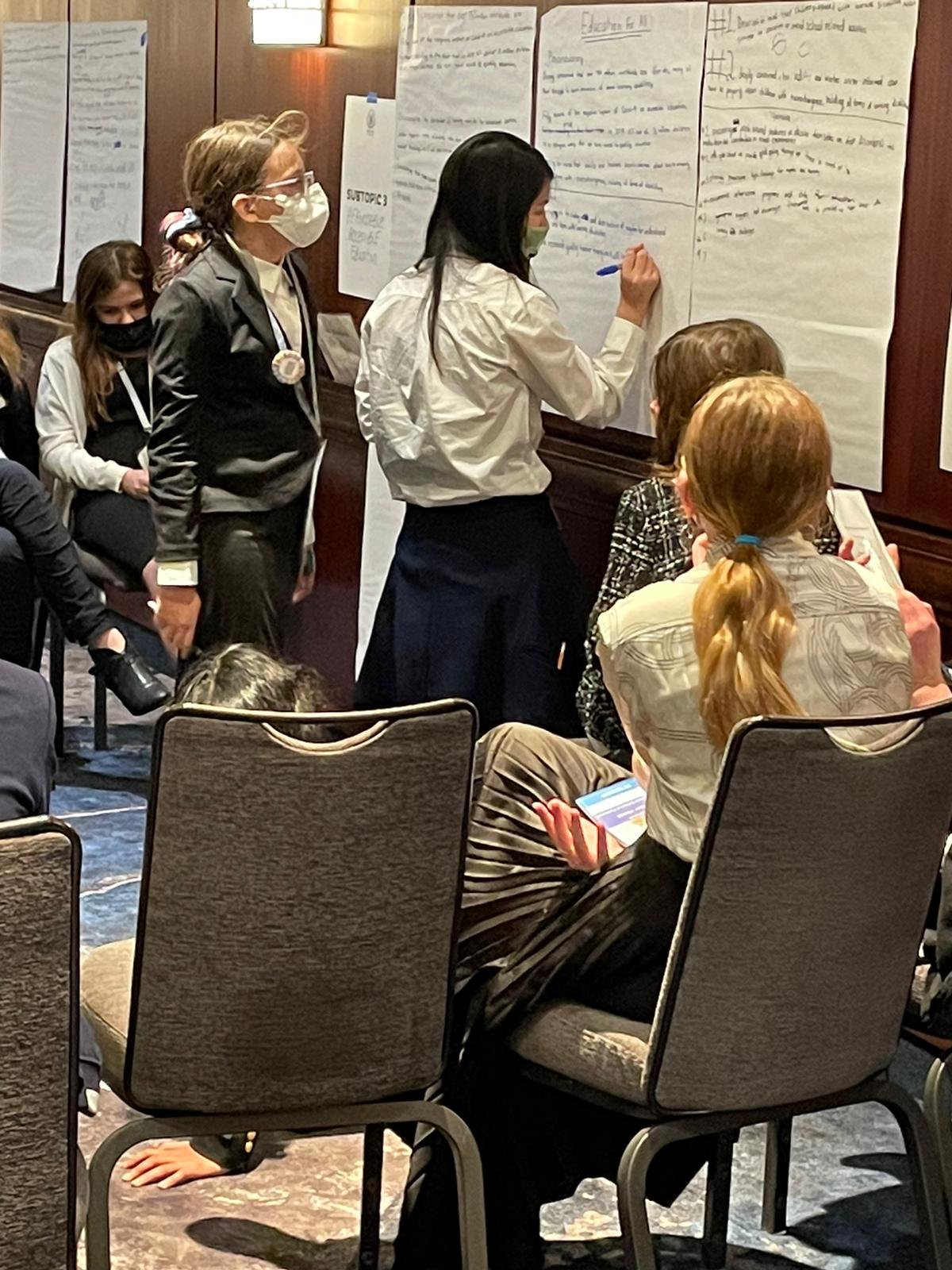
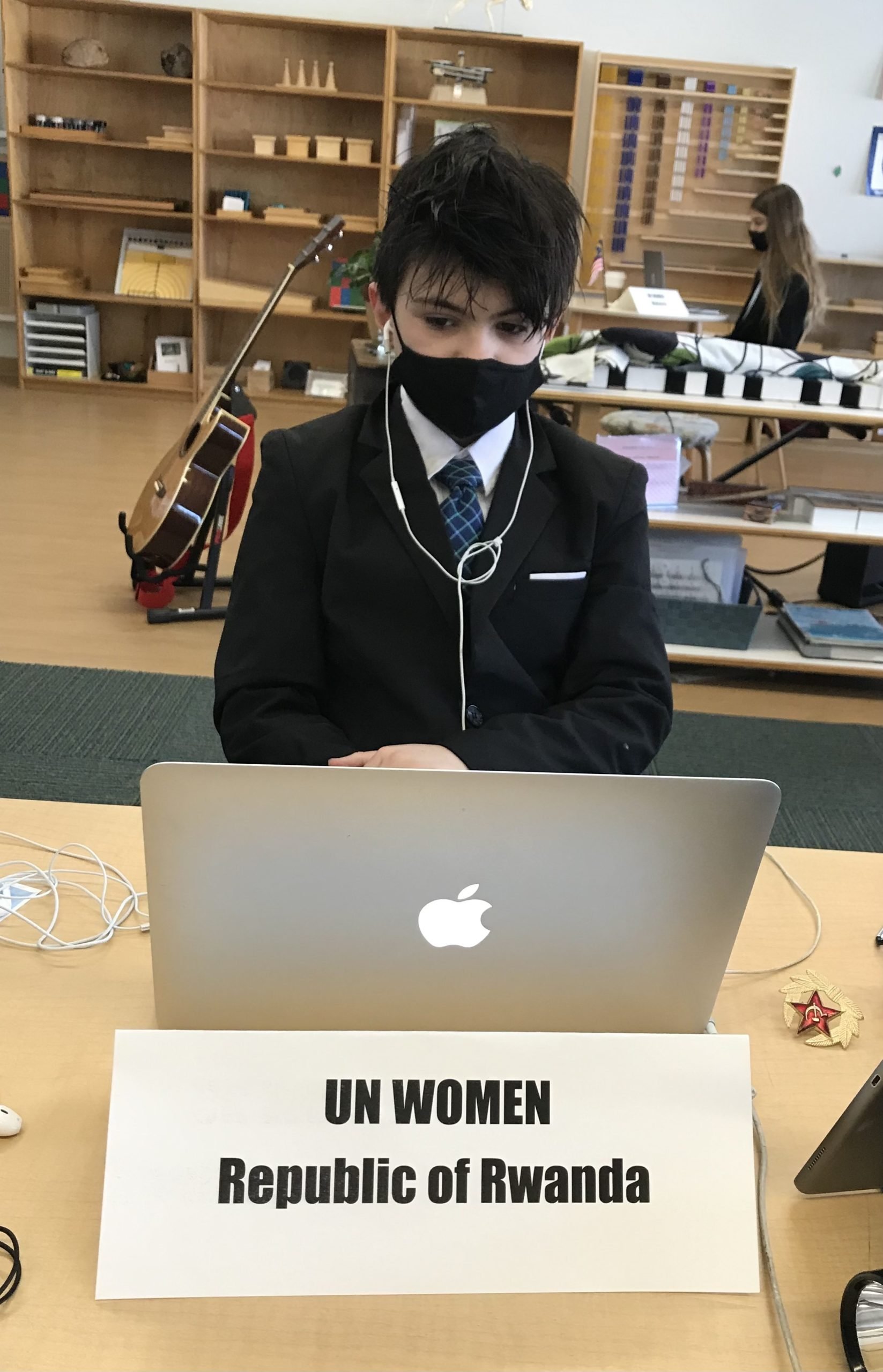
 Delegates definitely stand a little taller upon their return from the conference, a combination of feeling more independent, feeling proud and inspired by their work at the conference, and a new awareness of their role as a global citizen.
Delegates definitely stand a little taller upon their return from the conference, a combination of feeling more independent, feeling proud and inspired by their work at the conference, and a new awareness of their role as a global citizen.



 Here's Chung Yi giving a lesson on colors in Mandarin. It is so exciting to be able to offer a bilingual experience to children!Welcome, Chung Yi, we're so glad you're here!
Here's Chung Yi giving a lesson on colors in Mandarin. It is so exciting to be able to offer a bilingual experience to children!Welcome, Chung Yi, we're so glad you're here!


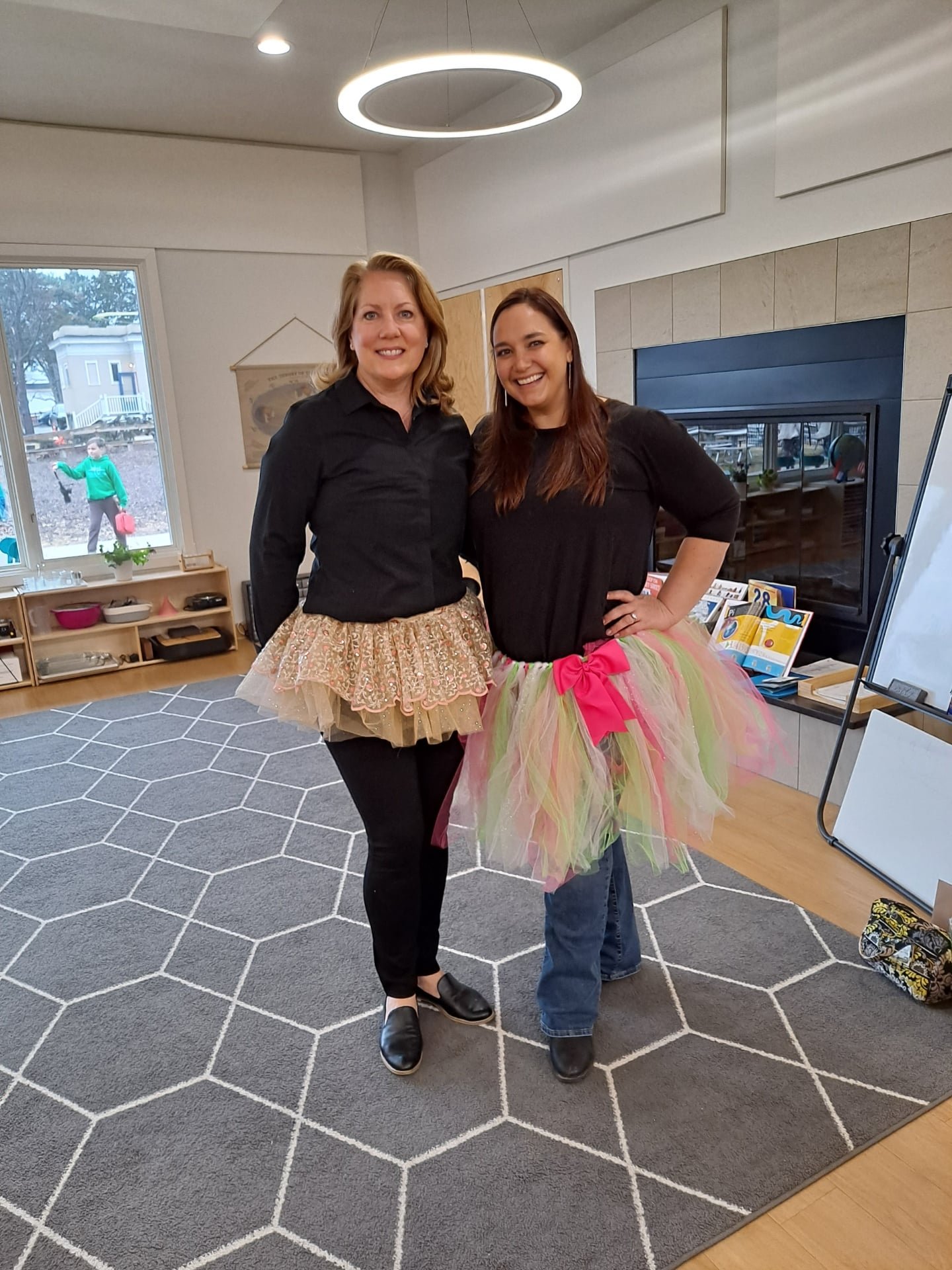


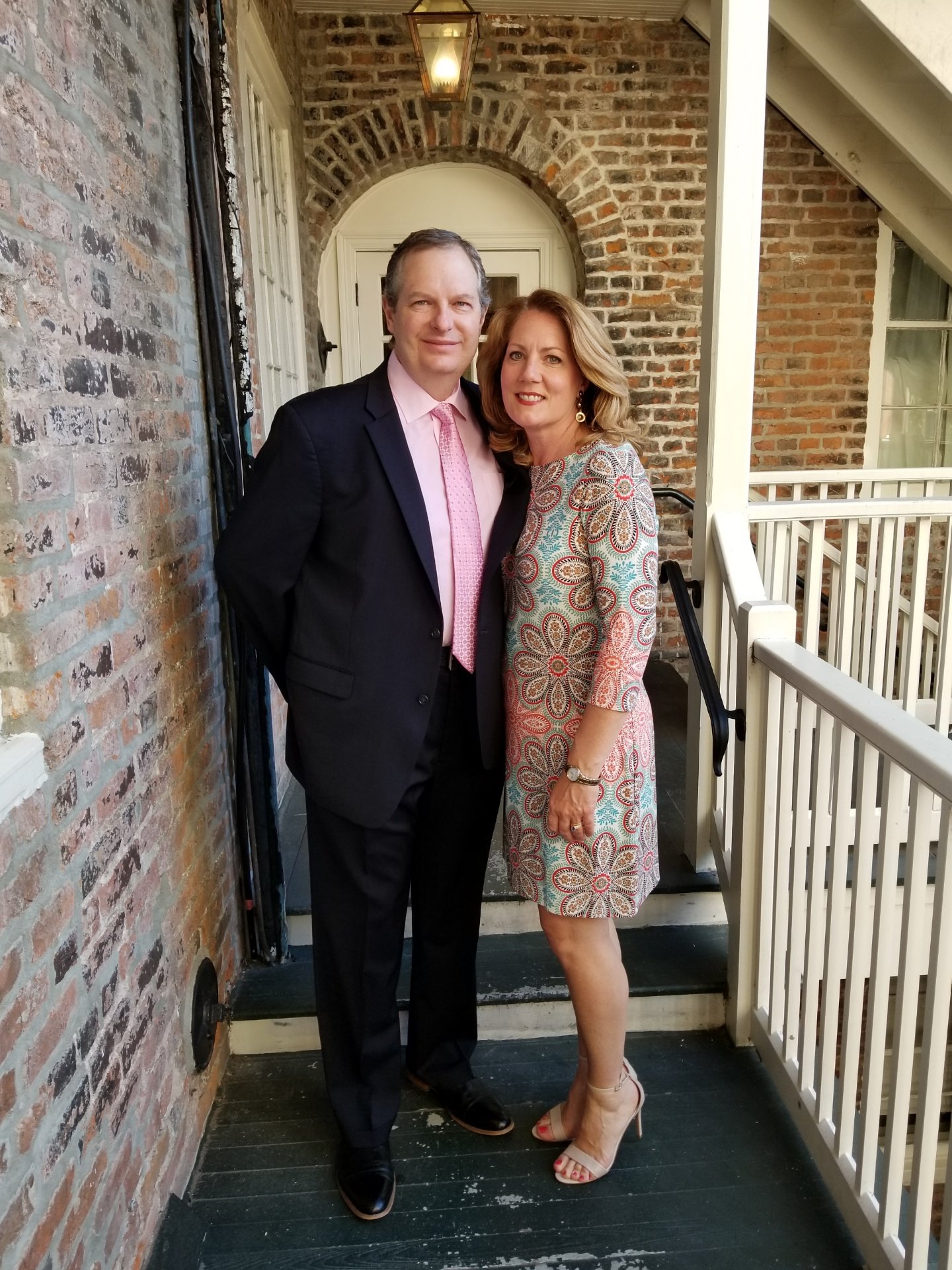


 We Montessorians sometimes use terminology that’s unfamiliar to folks more accustomed to a traditional school model, and this can lead to a bit of a mystification around the philosophy. It can even lead to the notion that Montessori schools are out of reach for the general population—that the methods in a Montessori school are too specialized, too… strange.
We Montessorians sometimes use terminology that’s unfamiliar to folks more accustomed to a traditional school model, and this can lead to a bit of a mystification around the philosophy. It can even lead to the notion that Montessori schools are out of reach for the general population—that the methods in a Montessori school are too specialized, too… strange. In fact, the concepts of Montessori, and the vocabulary we use to describe those concepts, were borne from Dr. Maria Montessori’s education, research, and maybe most importantly, her observations of real children at work. In other words, Montessori concepts and vocabulary are rooted in the natural processes of child development, and these concepts are very familiar, even intuitive, to anyone who lives or works with children. In our Montessori 101 series, we’ll demystify Montessori vocabulary and explore the concepts that inform it. This week, we’ll unpack what we mean by an “environment,” as opposed to a “classroom”.
In fact, the concepts of Montessori, and the vocabulary we use to describe those concepts, were borne from Dr. Maria Montessori’s education, research, and maybe most importantly, her observations of real children at work. In other words, Montessori concepts and vocabulary are rooted in the natural processes of child development, and these concepts are very familiar, even intuitive, to anyone who lives or works with children. In our Montessori 101 series, we’ll demystify Montessori vocabulary and explore the concepts that inform it. This week, we’ll unpack what we mean by an “environment,” as opposed to a “classroom”. Montessori often compares human development to the growth of a plant. The plant has everything it needs to grow within itself; it only requires the proper environment (soil, water, sunlight, warmth). Similarly, humans require certain environmental factors to mature and flourish. We know infants require consistent positive interaction with caregivers in order to form attachment and one day function in society. Babies need freedom of movement in order to learn to walk. They need to hear their native language to be able to develop language themselves. Amazingly, typically developing little humans acquire the abilities to walk and speak without any formal instruction! Movement and language develop organically in an environment rich with stimuli and interaction.
Montessori often compares human development to the growth of a plant. The plant has everything it needs to grow within itself; it only requires the proper environment (soil, water, sunlight, warmth). Similarly, humans require certain environmental factors to mature and flourish. We know infants require consistent positive interaction with caregivers in order to form attachment and one day function in society. Babies need freedom of movement in order to learn to walk. They need to hear their native language to be able to develop language themselves. Amazingly, typically developing little humans acquire the abilities to walk and speak without any formal instruction! Movement and language develop organically in an environment rich with stimuli and interaction.
 As children develop, they require a developing set of stimuli to aid them toward their full potential. Dr. Montessori observed that children pass through four stages of development from birth to adulthood. She called these stages, “The Four Planes of Development.” An in-depth look into the four planes of development is coming to the blog very soon—for now, the takeaway is this: the characteristics of children change from plane to plane; and each plane of development requires a particular environment and trained adult suited to the needs of that plane.
As children develop, they require a developing set of stimuli to aid them toward their full potential. Dr. Montessori observed that children pass through four stages of development from birth to adulthood. She called these stages, “The Four Planes of Development.” An in-depth look into the four planes of development is coming to the blog very soon—for now, the takeaway is this: the characteristics of children change from plane to plane; and each plane of development requires a particular environment and trained adult suited to the needs of that plane. In a Montessori school, classrooms (yes, we still call it a “classroom” sometimes!) are designed and thoughtfully prepared along the lines of the planes and sub-planes of development. Montessori divides the first plane into a sub-plane of zero-to-three years old and three-to-six years old—these are the Young Children’s Community (YCC) and the Children’s House. The YCC environment is designed to facilitate the natural work of the very young child: the construction of physical and biological independence. The YCC assists children as they learn to walk, talk, and perform activities independently. From ages to three through six, the Children’s House environment continues to foster the independence of the first-plane child.
In a Montessori school, classrooms (yes, we still call it a “classroom” sometimes!) are designed and thoughtfully prepared along the lines of the planes and sub-planes of development. Montessori divides the first plane into a sub-plane of zero-to-three years old and three-to-six years old—these are the Young Children’s Community (YCC) and the Children’s House. The YCC environment is designed to facilitate the natural work of the very young child: the construction of physical and biological independence. The YCC assists children as they learn to walk, talk, and perform activities independently. From ages to three through six, the Children’s House environment continues to foster the independence of the first-plane child. In the second plane of development, the sub-planes break down into six-to-nine years old and nine-to-twelve years old—Lower Elementary and Upper Elementary. In these environments children are offered materials and lessons to develop mental independence and a reasoning mind. The elementary environments also offer social opportunities as children become motivated to work and spend time with others. For this reason, the Montessori elementary environment provides larger work tables to accommodate groups of children. The elementary guide presents lessons to groups of children because of the intense drive to work with peers.
In the second plane of development, the sub-planes break down into six-to-nine years old and nine-to-twelve years old—Lower Elementary and Upper Elementary. In these environments children are offered materials and lessons to develop mental independence and a reasoning mind. The elementary environments also offer social opportunities as children become motivated to work and spend time with others. For this reason, the Montessori elementary environment provides larger work tables to accommodate groups of children. The elementary guide presents lessons to groups of children because of the intense drive to work with peers. A “classroom” connotes a room in which a class is held, where information is imparted from one person to another. Montessori doesn’t see education that way. In a Montessori school, we see the innate power children have to form themselves, as flowers do, given the appropriate surroundings—surroundings that meet the needs of the particular developmental stage. As Dr. Montessori said,
A “classroom” connotes a room in which a class is held, where information is imparted from one person to another. Montessori doesn’t see education that way. In a Montessori school, we see the innate power children have to form themselves, as flowers do, given the appropriate surroundings—surroundings that meet the needs of the particular developmental stage. As Dr. Montessori said,
 By calling the classroom an “environment,” Montessorians seek to give agency to the child in their process of formation. We see the trained adult as an important part of the environment, who guides the child in his journey toward becoming a fully formed adult.
By calling the classroom an “environment,” Montessorians seek to give agency to the child in their process of formation. We see the trained adult as an important part of the environment, who guides the child in his journey toward becoming a fully formed adult.







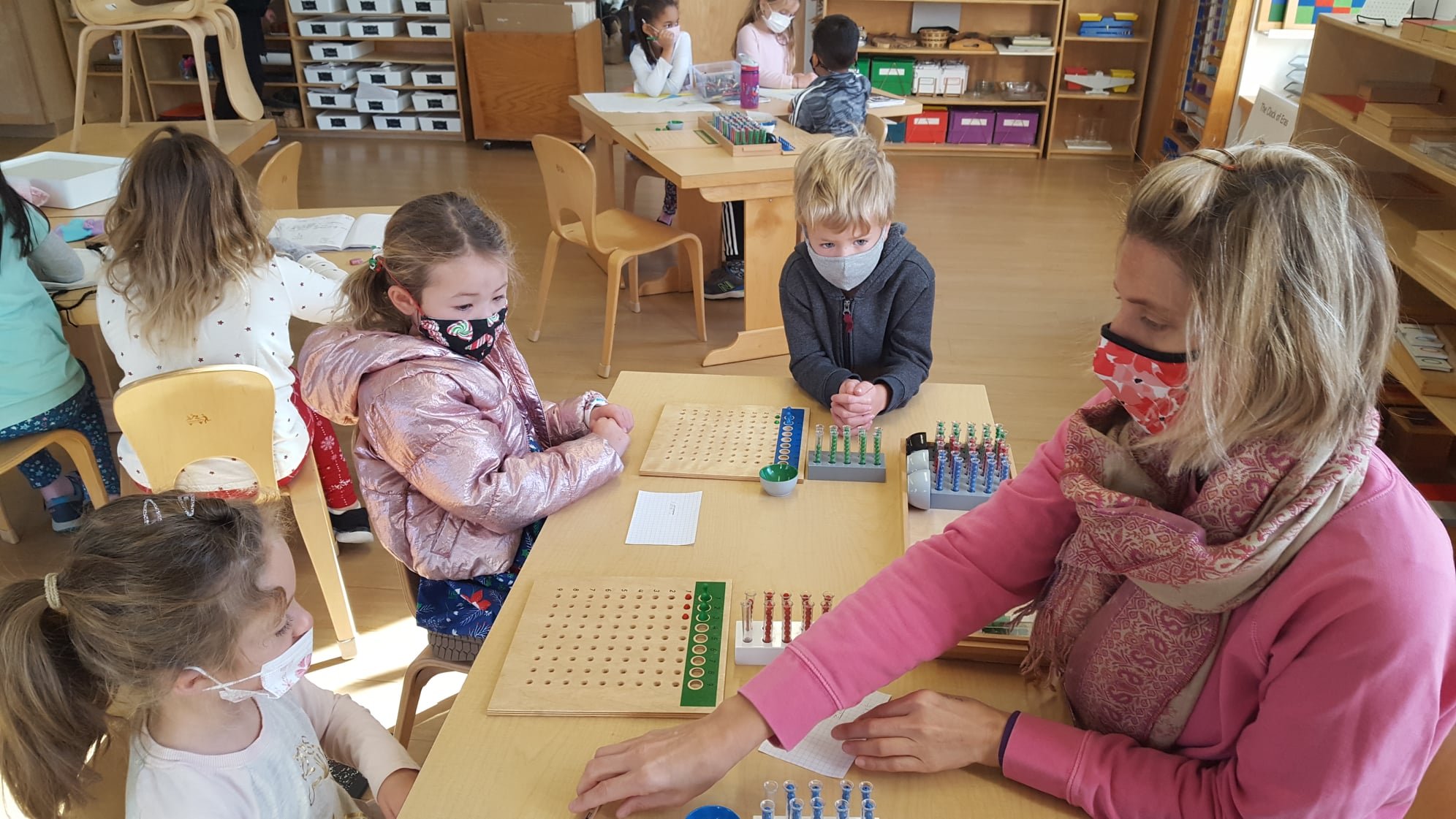

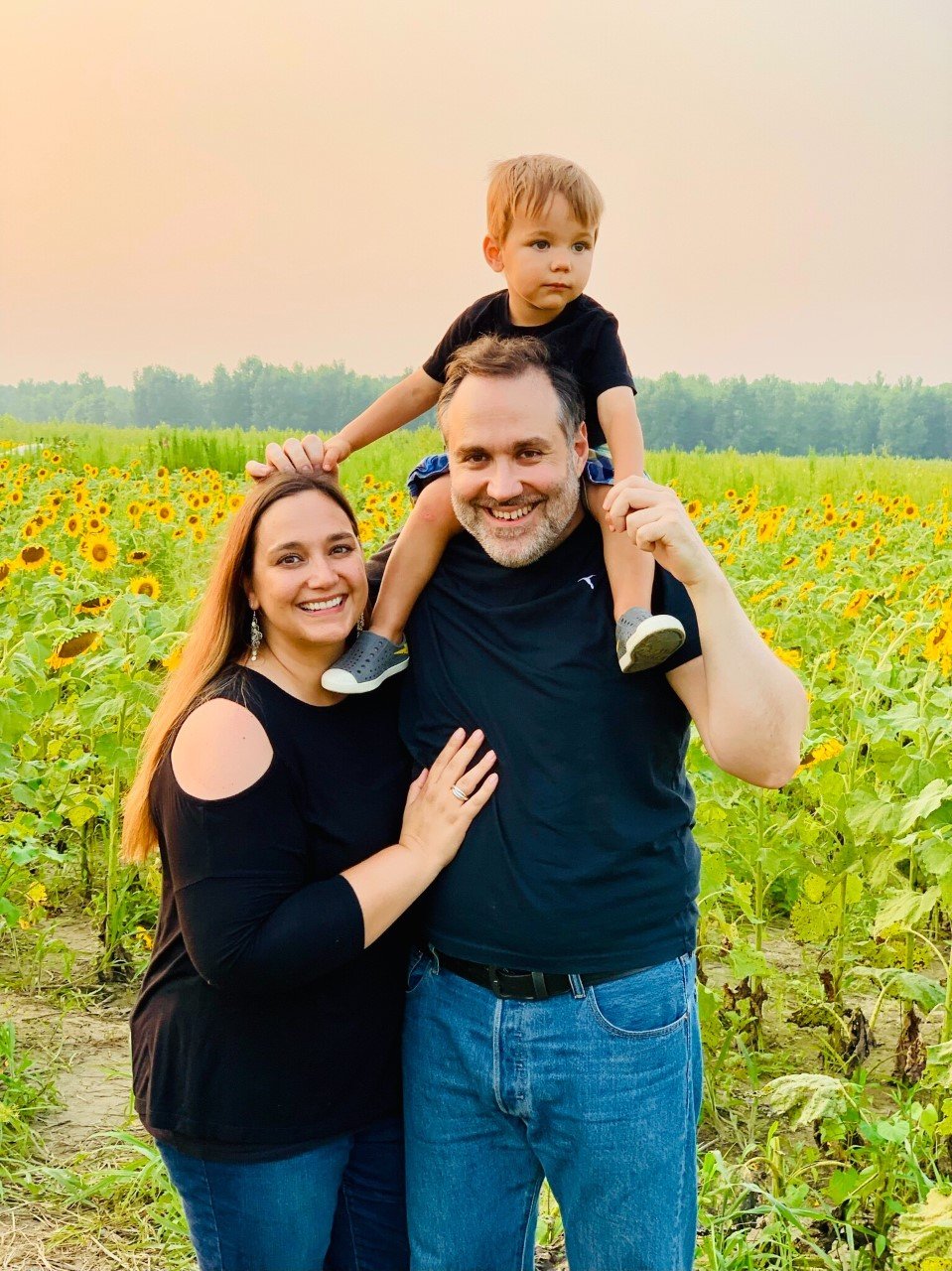
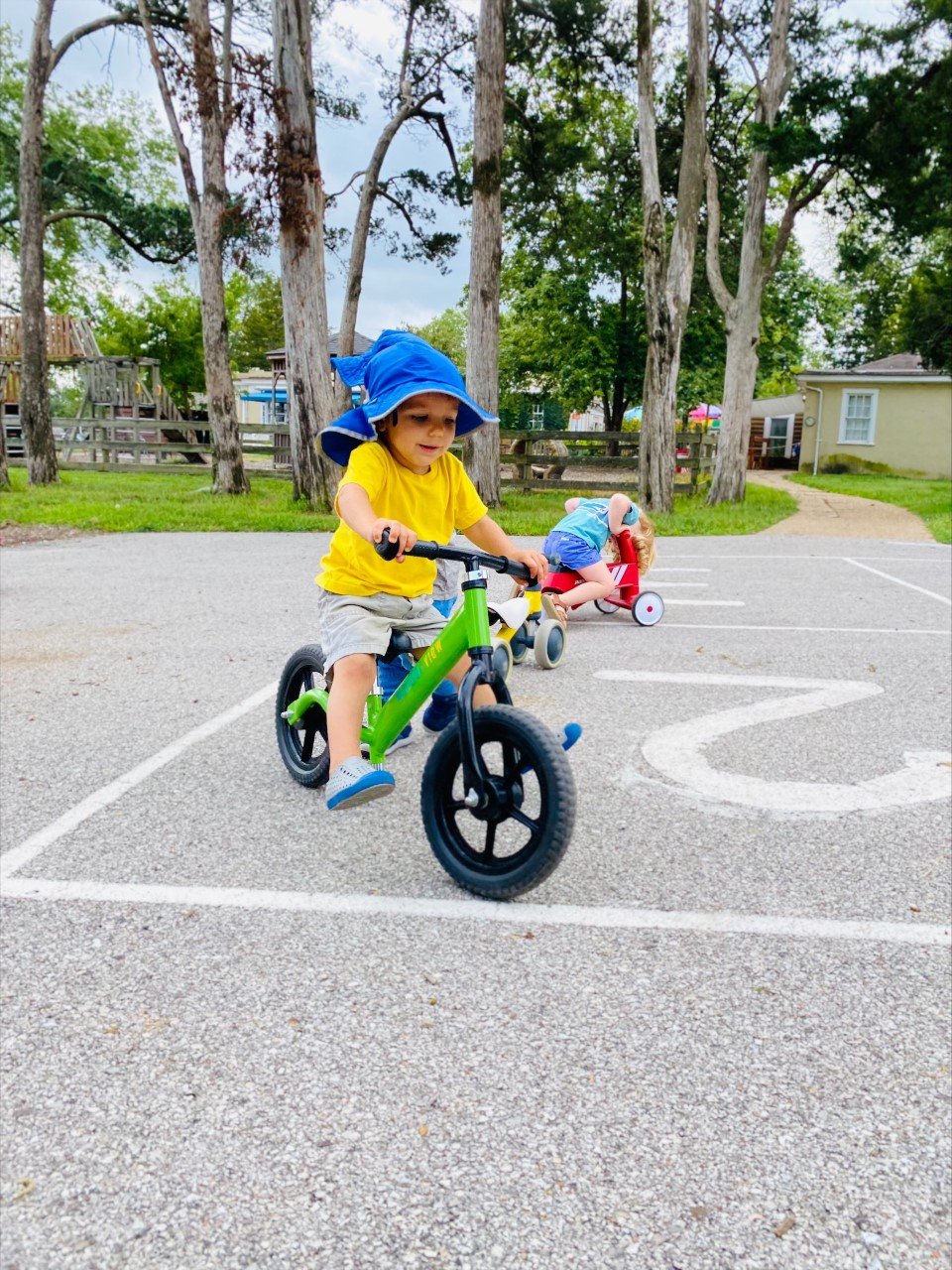

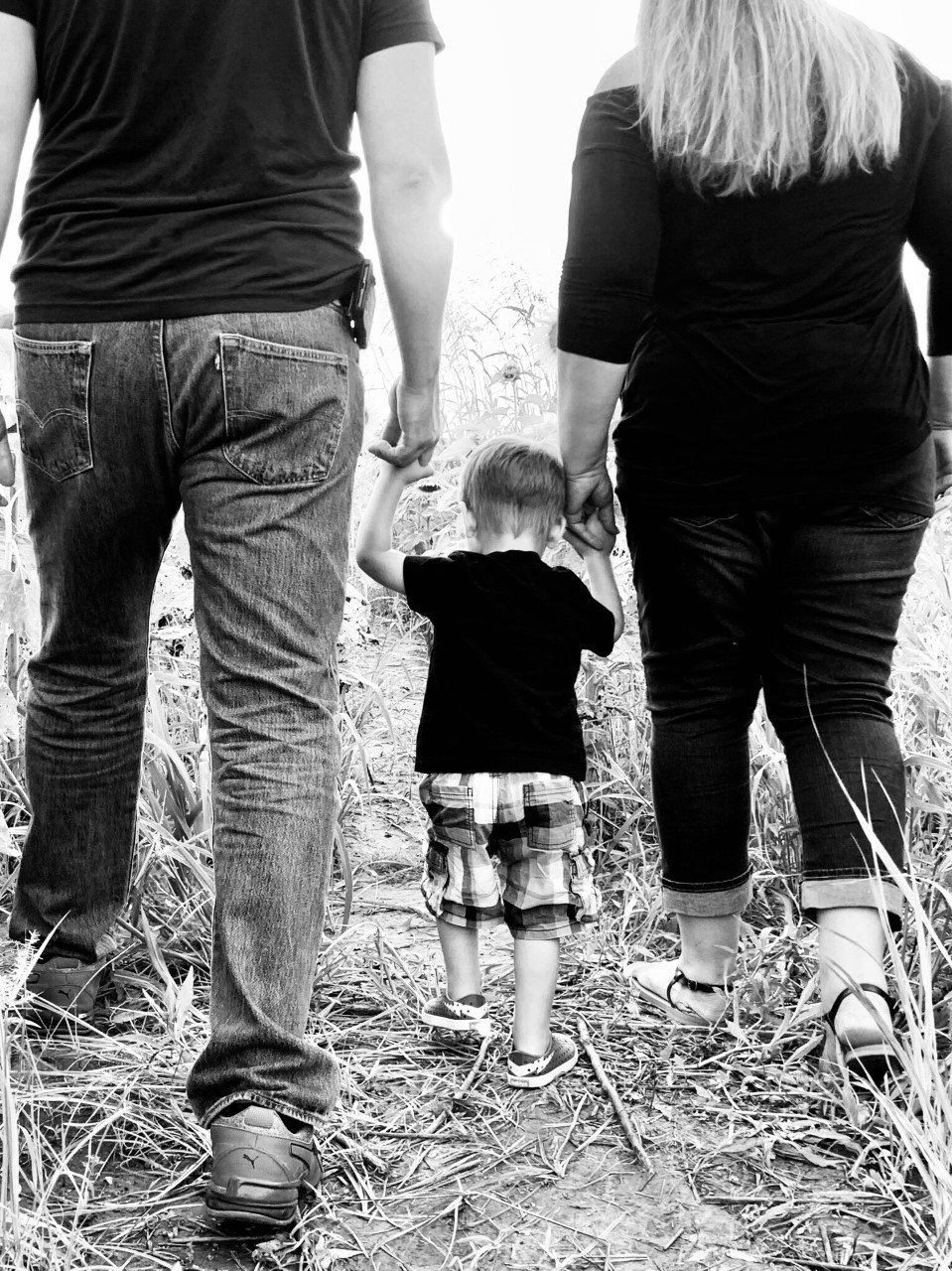

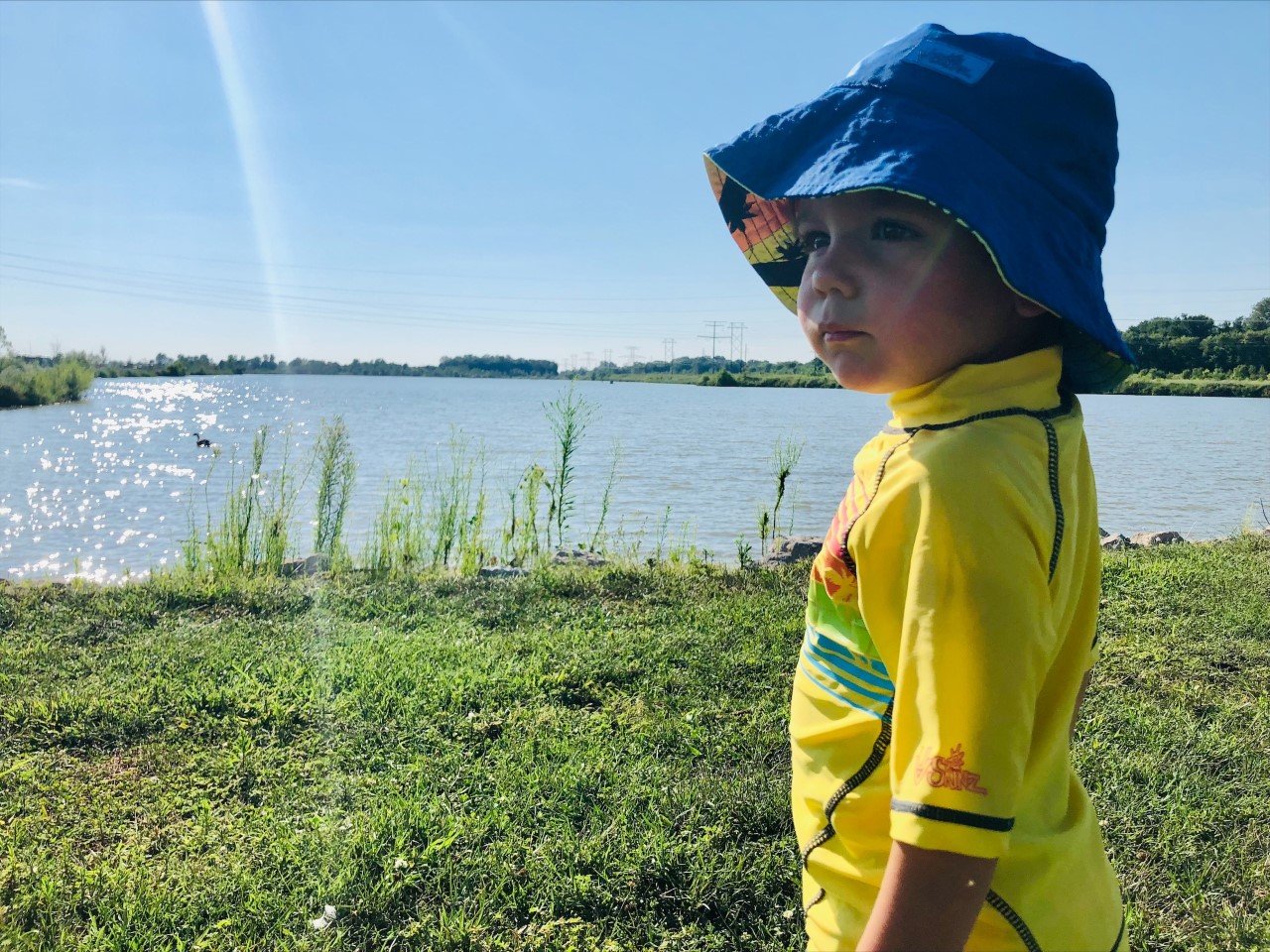


 In today’s world, emotional literacy and well-being are vital for the flourishing of our children and young adults. Montessori philosophy naturally fosters this because we care about the development of the whole child—their emotional, physical, social, and intellectual development.
In today’s world, emotional literacy and well-being are vital for the flourishing of our children and young adults. Montessori philosophy naturally fosters this because we care about the development of the whole child—their emotional, physical, social, and intellectual development. In a Montessori environment, children are encouraged to pursue their unique learning styles; they aren’t rushed to master content for tests; and there’s no pile-on homework after a long school day. Montessori does not arbitrarily confine students in a one-size-fits-all grade level. Instead it encourages children to explore and learn at their own pace—it keeps natural curiosity alive and fosters intrinsic motivation. Montessori develops intellectual tools that grant children the joy of being life-long learners.
In a Montessori environment, children are encouraged to pursue their unique learning styles; they aren’t rushed to master content for tests; and there’s no pile-on homework after a long school day. Montessori does not arbitrarily confine students in a one-size-fits-all grade level. Instead it encourages children to explore and learn at their own pace—it keeps natural curiosity alive and fosters intrinsic motivation. Montessori develops intellectual tools that grant children the joy of being life-long learners. Another way Montessori supports emotional well-being is through movement. In her work with children, Dr. Maria Montessori observed a need for movement and a drive to explore the world through the hands. We know from our own experience that we are connected body and mind. How we use our bodies affects our concentration, outlook, and emotions. Nutrition, sleep, and exercise (read, “movement”!) are critical in the development of strong mental health.
Another way Montessori supports emotional well-being is through movement. In her work with children, Dr. Maria Montessori observed a need for movement and a drive to explore the world through the hands. We know from our own experience that we are connected body and mind. How we use our bodies affects our concentration, outlook, and emotions. Nutrition, sleep, and exercise (read, “movement”!) are critical in the development of strong mental health. In the Montessori classroom, children choose where and with whom to sit—where their bodies are most comfortable working. Many of the materials in the classroom environment incorporate movement of the body. For example, children move around the classroom to gather the materials for work; they manipulate small beads to do division; they follow language commands that lead them around the environment; and they perform experiments with solids, liquids, and gasses. When children are allowed to move freely in their learning environment, we see the positive effects expressed in their enjoyment of work and their upbeat demeanor at school.
In the Montessori classroom, children choose where and with whom to sit—where their bodies are most comfortable working. Many of the materials in the classroom environment incorporate movement of the body. For example, children move around the classroom to gather the materials for work; they manipulate small beads to do division; they follow language commands that lead them around the environment; and they perform experiments with solids, liquids, and gasses. When children are allowed to move freely in their learning environment, we see the positive effects expressed in their enjoyment of work and their upbeat demeanor at school. In addition to movement, nature has a powerful effect on our mental health. Numerous studies including those cited
In addition to movement, nature has a powerful effect on our mental health. Numerous studies including those cited 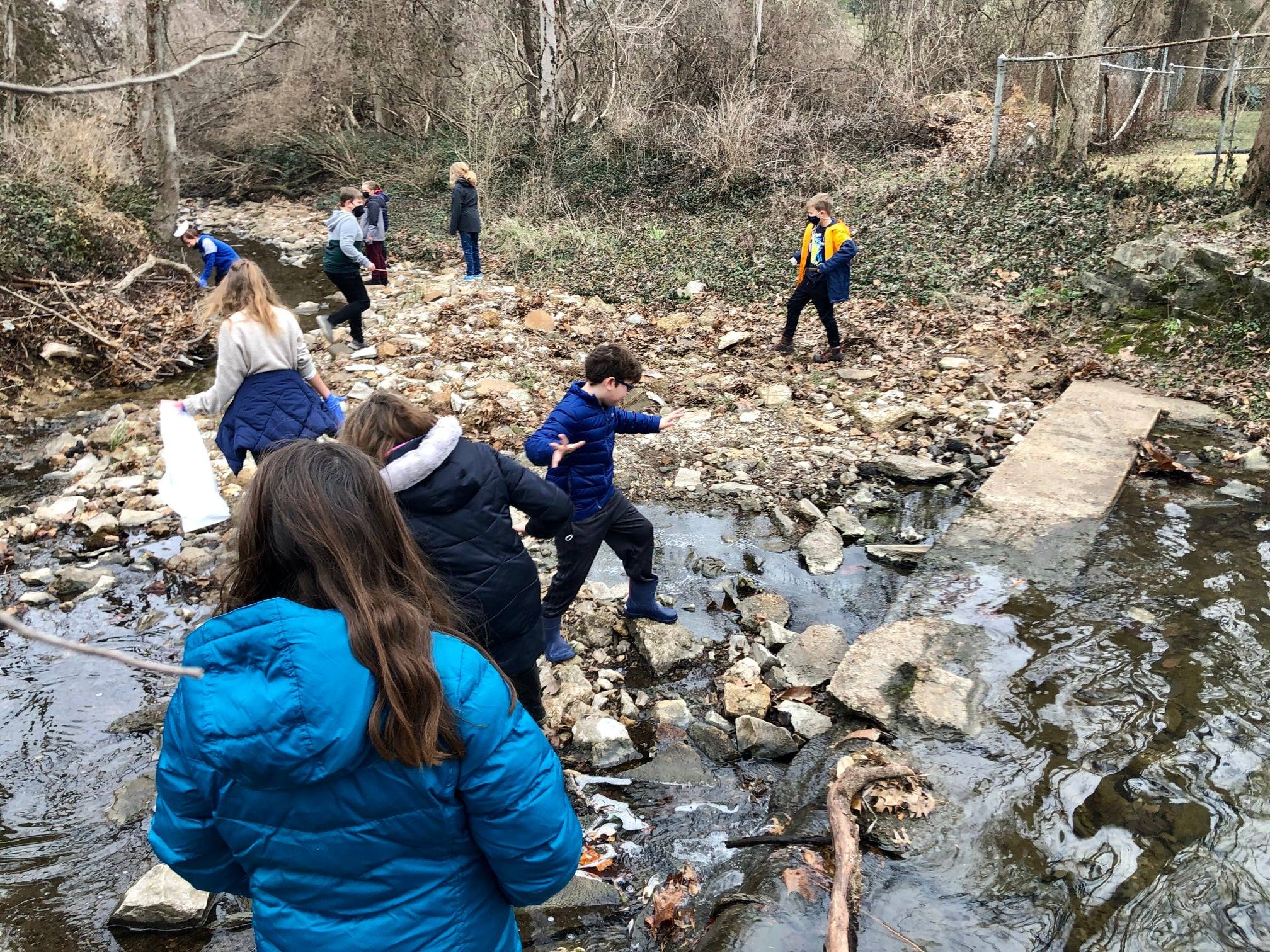 Finally, Montessori guides seamlessly weave techniques into their lessons that help children manage their challenging emotions. For example, guides model positive self-talk when a child is struggling to learn something new. They offer social scripts to help students navigate conflict; for instance, “I need some time alone before I’m ready to talk,” or “It made me feel... when you…” VdM guides employ specific lessons and work choices geared toward the development of emotional literacy as well. Some guides lead regular meditation practice, yoga, or teach breathing techniques to calm bodies and minds. Specific areas of the classroom environments are set up for children to practice calming techniques, such as a finger labyrinth or yoga poses.
Finally, Montessori guides seamlessly weave techniques into their lessons that help children manage their challenging emotions. For example, guides model positive self-talk when a child is struggling to learn something new. They offer social scripts to help students navigate conflict; for instance, “I need some time alone before I’m ready to talk,” or “It made me feel... when you…” VdM guides employ specific lessons and work choices geared toward the development of emotional literacy as well. Some guides lead regular meditation practice, yoga, or teach breathing techniques to calm bodies and minds. Specific areas of the classroom environments are set up for children to practice calming techniques, such as a finger labyrinth or yoga poses.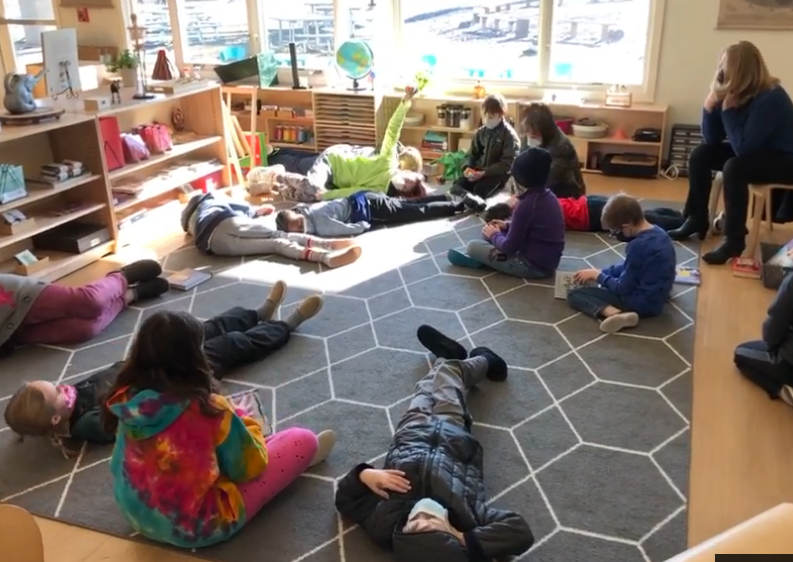 The wheel of emotions is a beautiful material that gives students a robust understanding of their feelings and those around them.
The wheel of emotions is a beautiful material that gives students a robust understanding of their feelings and those around them.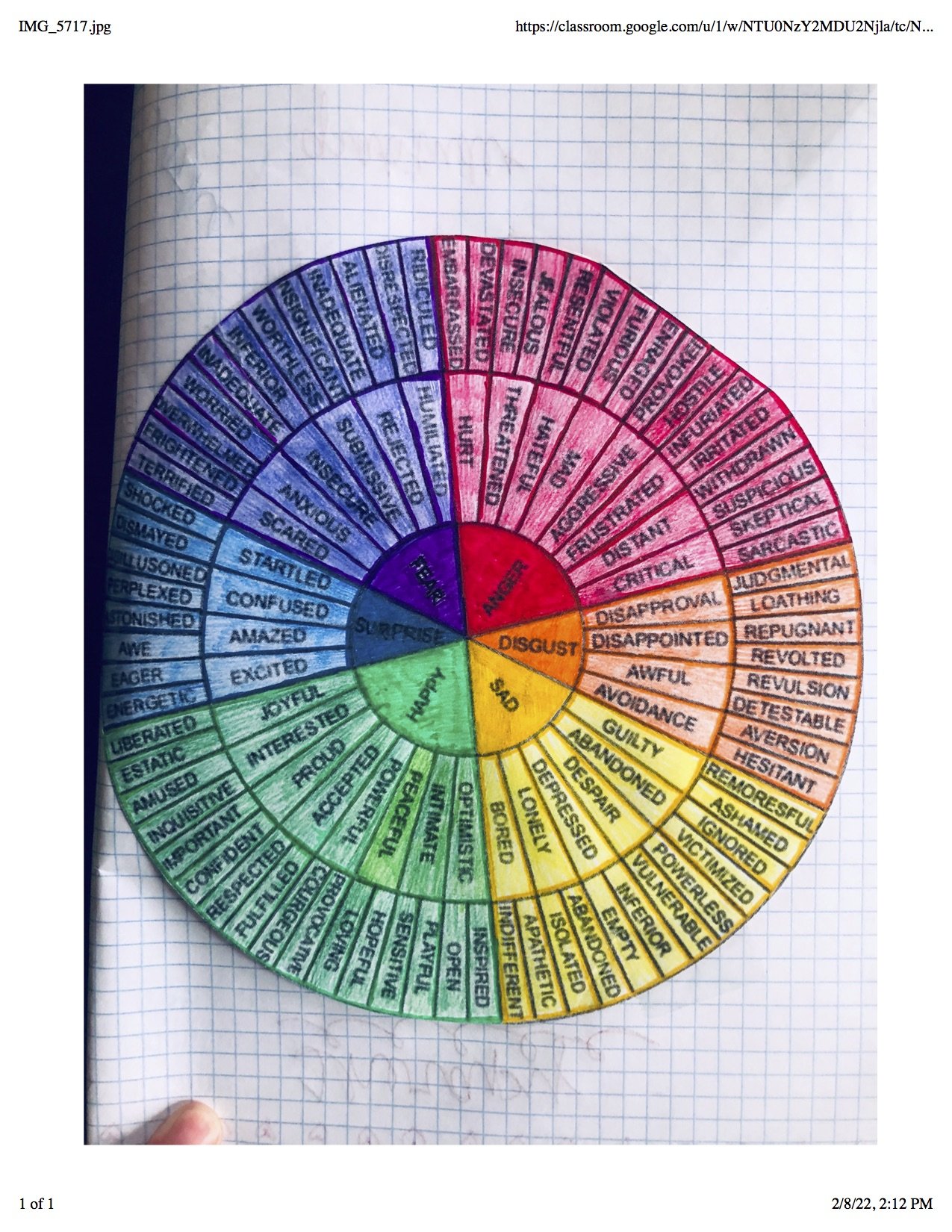 At Villa di Maria we are grateful to accompany each child in their unique journey and contribute to the prioritization of emotional literacy and well-being in education and our world. We are raising future leaders that care about the individual and all the complex facets of human beings.
At Villa di Maria we are grateful to accompany each child in their unique journey and contribute to the prioritization of emotional literacy and well-being in education and our world. We are raising future leaders that care about the individual and all the complex facets of human beings.